Shikhar Blog
Travel Experiences – Sharing Travel Memories Around the World

Satopanth Tal Trek- An adventure to explore the Pristine Glacial Lake
An untouched Glacier Lake, Satopanth Tal is a triangle-shaped hidden treasure amidst the magnificent Garhwal region. The destination happens to be an impeccable religious site for the locals and is believed that the three supreme deities of Hinduism, Brahma, Vishnu, and Maheshwara meditated on the three different corners. Nestled at a huge elevation of 4600 meters above sea level, this crystal clear green water lake is beautifully bedecked amid the snow-shrouded peaks.
This renowned trekking trail in Uttarakhand holds immense significance in Hinduism and attracts thousands of travelers from all across the globe. A massive crowd of devotees treks to this lake on solar and lunar fortnights to take bath into it as this is considered very auspicious. This gorgeous site also offers a great opportunity to have glimpses of the Himalayas.
Along with enjoying the thrilling trekking experience, one can also witness the surreal beauty of the scenic vistas and the glory of the gorgeous Vasudhara Falls. In addition, the traveler also gets an opportunity to capture the awe-inspiring views of Himalayan gigantic such as Chaukhamba, Neelkanth, and Swargarohini.
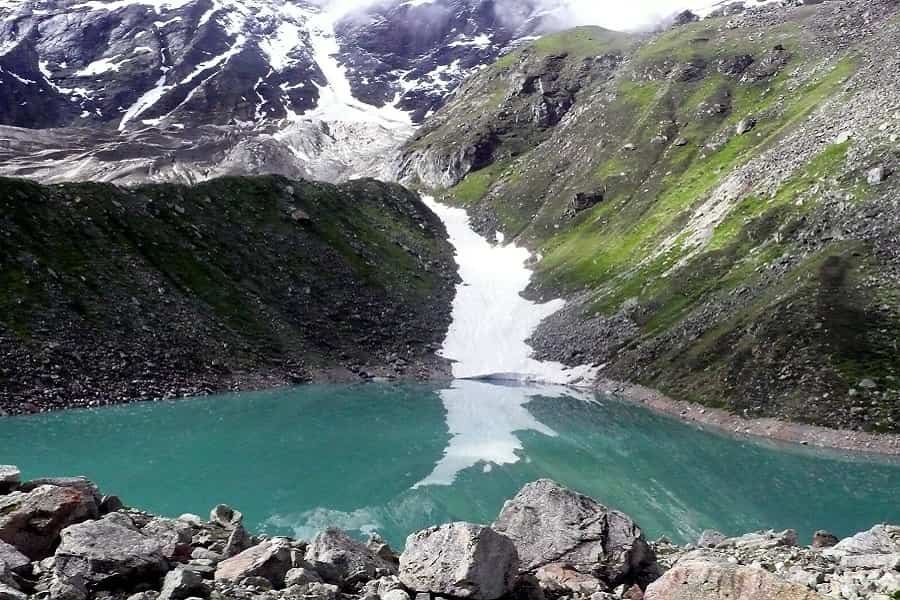
Note- Be informed that you are not going to find any permanent establishments for an overnight halt on the Satopanth Tal Trek expedition. Hence, you are strictly advised to carry food, raw materials, tents, and sleeping gear along with you.
Also Check Out : Detailed Itinerary for Mt. Satopanth Peak Expedition
Brief Details about the Trek
- Duration of the trek- 6 days
- Difficulty level- moderate
- Distance covered- around 50 km
- Start and end point- the journey continues from Rishikesh to Badrinath
- Base Camp- Mana Village
- Nearest Airport- Jolly Grant Airport in Dehradun
- Nearest Railhead- Rishikesh
- Best time- between May-June and then September-October
Trekking Tour Highlights
- Witness the impeccable charm of the untouched Satopanth Lake.
- Walk over the Bheem Pul, a natural rock bridge.
- Watch out for the mesmerizing views of Vasudhara Falls.
- Climb up the Dhano Glacier, one of the majestic glaciers in North India.
- Walkthrough Mana, the last Indian village.
- Witness the spell-binding views of the Himalayan peaks like Swargarohini, Chaukhamba, and Neelkanth.
- Enjoy camping at Satopanth Lake under the starry sky during the night.
The Legend of Satopanth Tal
If we go by the traditional Sanskrit then the word ‘Sat-o’ means ‘of truth’ and ‘Panth’ means ‘Pathway’. Hence, Satopanth altogether means a pathway leading to ultimate truth. Several myths are existing about the lake that has passed on from one generation to another and is spread among locals and tourists as folklore.
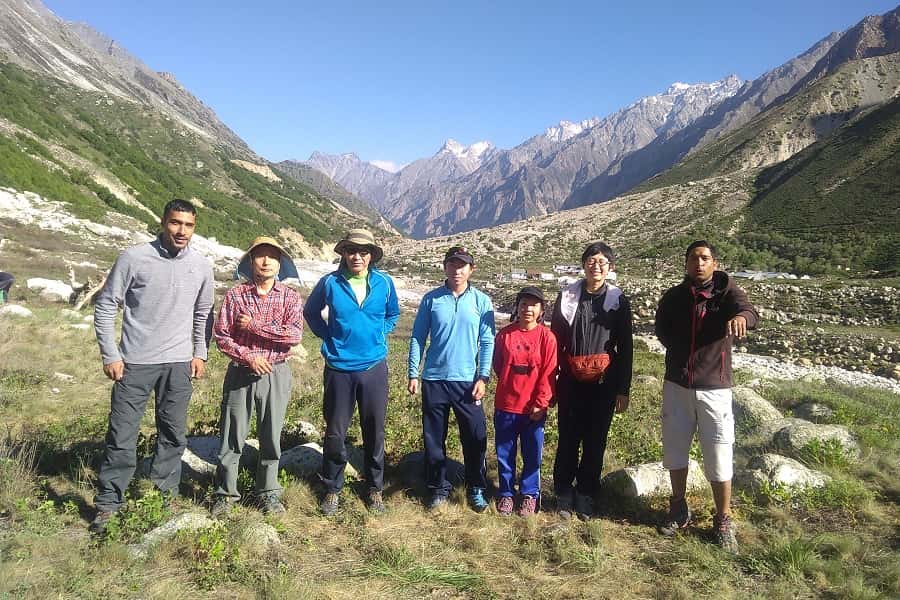
There is a belief that some unique bird species often come to the shores of this lake, which are Gandharvas from heaven. It is believed that they come here to pick the garbage, dirt, and pollution to keep the lake clean and hygienic.
When you roam around the village, you will get to hear several stories related to the origin of this revered site.
Best Time to Trek along the Satopanth Tal Trek
This high-altitude trekking trail however overflows with beauty all around the year and is best to be undertaken either during monsoon months or the summer season.
Covering This Trek during the Summer Months
Summer month in Uttarakhand starts in May and the clear skies offer clear views of the snow-peaked Mt. Neelkanth, Swargarohini, and Mt. Chaukhamba. The starry sky looks so enchanting, especially on the full moon day. Adventure lovers can enjoy the eye-treating views of the nature during summer months with colorful and scented flowers blooming all around.
The trails pass through the dense forest areas, lush meadows, and bluish-green water enhances the glory of this pristine glacial lake. The average temperature of the site ranges between 12 degrees Celsius during the daytime and during the night, the temperature hovers between 7 Degree Celsius and -5 degrees Celsius.
Also Check Out : Detailed Itinerary for Satopanth Base Camp Trek
Covering this Trek Post Monsoon
Another ideal time to trek along Satopanth Lake is the post-monsoon season. September and October reveal another aspect of the scenic vista of this region. This is the most ideal time to witness the beauty of River Alaknanda at its utmost level. In October, the region starts receiving snowfall covering the landscape in a light cover of white.
Winter months are not recommended to plan your Satopanth Tal Trek due to extreme climatic conditions and during the monsoon months, the region becomes quite prone to landslides making routes inaccessible. When you reach the top of this high altitude, it is quite common to find a lot of snow in the winter months.
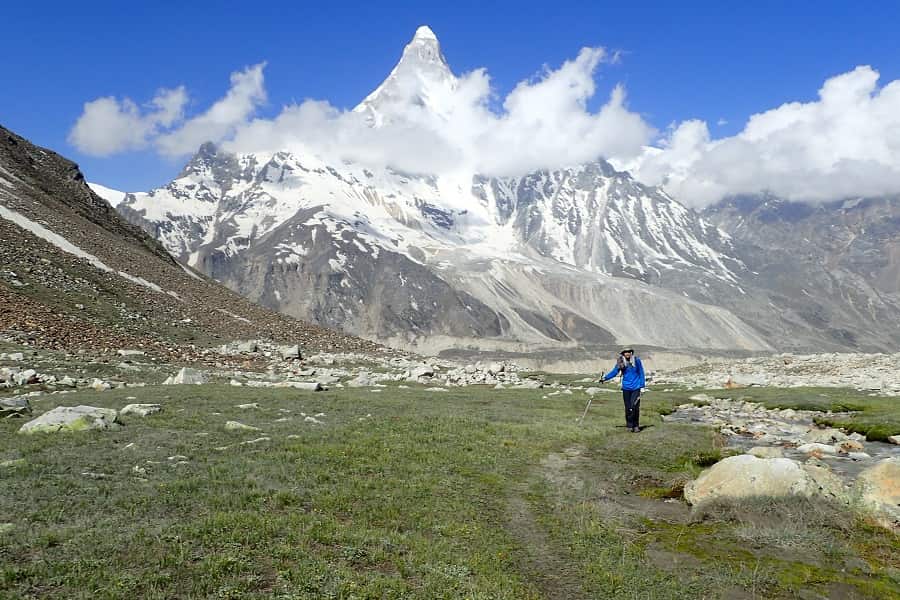
How to Reach Satopanth Tal Trek
The trek commences at Mana in Uttarakhand, the last village established on the Indo-Tibetan border. Located only 4 km away from the main town of Badrinath, the destination is well connected with several major cities of the country.
By Air- Jolly Grant Airport in Dehradun is the nearest airport and is only 317 km away from Badrinath. The airport is well connected to various big cities with several direct and connecting flights available on regular basis. One can also opt for the helicopter services available from the Sahastradhara helipad in the city.
On reaching the airport, one can easily find a taxi or a cab to reach the desired destination.
By Rail – Unfortunately, there is no railway station in Badrinath and the nearest railhead to the pilgrimage is Haridwar Railway Station which is nicely connected to the different parts of the country.
By Road – Badrinath is very well connected to its surrounding states via NH-58 and this makes it easily accessible by roadways. You don’t need to worry about safety as the roads are well maintained and very safe to travel. We would recommend you to take a bus rather than driving your own to reach the place as it would be very arduous and hectic for you.
If you are coming from Delhi then you can easily catch a bus from ISBT Kashmere Gate. Once you arrive in Badrinath then take a bus or taxi to reach Mana Village which is only 3-4 km from here.
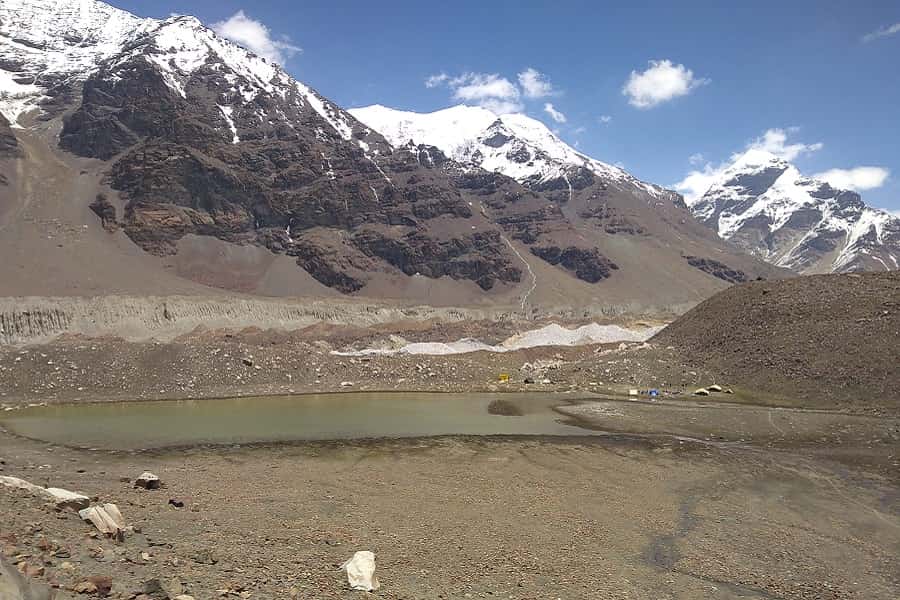
Satopanth Tal Trek Itinerary
To have a clear understanding of the journey you are planning to cover, you must check out this meticulously designed itinerary.
Day 1- Rishikesh- Badrinath- Drive for almost 300 km
You will be covering a total of 11 hours long road journey to reach Badrinath from Rishikesh. We would recommend you to start your day a little early in the morning so that you can reach the site on time and can save your energy for the next day’s schedule. You will be left with a little time in the evening when you can visit the pilgrimage. After darshan and completing the puja rituals return to the hotel for a night meal which is then followed by a relaxing overnight stay.
Day 2- Badrinath- Lakshmi Van- 5 hours long trekking
Kickstart your second day of the trip with a relishing morning meal and then get ready to move towards Mana Village . You can either think of covering the distance between Badrinath and Mana Village by walking or can hire a taxi or cab. After you have completed 3-4 hours of the distance you get to see the mesmerizing beauty of the gorgeous Vasudhara Falls.
After crossing the waterfalls area, keep on moving towards Lakshmi Van campsite elevated at 11,900 feet where you will go for an overnight stay in the tent.
Day 3- Lakshmi Van- Chakratirtha – 4 hours long trekking
On the 3rd day of your journey, you will be walking along the green grasslands along with the rocky areas of Dhano Glacier. This is going to be a very exciting journey where you will be enjoying glimpses of Bhagirathi peaks and the patches of colorful wildflowers. Start trekking towards Sahastradhara from where you get to enjoy the awe-inspiring views of the majestic Neelkanth Peak on a very clear day.
Go for an hour-long trek to reach the Chakratirtha Campsite from here.
Day 4- Chakratirtha to Satopanth Lake and back- 8 hours long trekking
This is the day when you start trekking towards Satopanth Lake from where you get the first glimpse of the pristine glacial lake. Enjoy the scintillating views of a lifetime with Swargarohini on the left, Neelkanth behind you, Balakun on the right, and Chaukhamba straight ahead. Climb up to Chakrateerth once you are done with clicking pictures.
Day 5- Chakrateerth to Badrinath via Mana- 6 hours long trekking
Climb down to Mana Village by following the same route which takes almost 6 hours. Take a direct jeep or cab to reach Badrinath if you feel too exhausted which you definitely would be.
Day 6- Badrinath- Rishikesh
On the last day of your journey, you will be taking a cab or bus to Rishikesh for your onward journey towards home. Take out some time to shop out your heart’s contents or souvenirs from either Rishikesh or Badrinath before you leave the state.
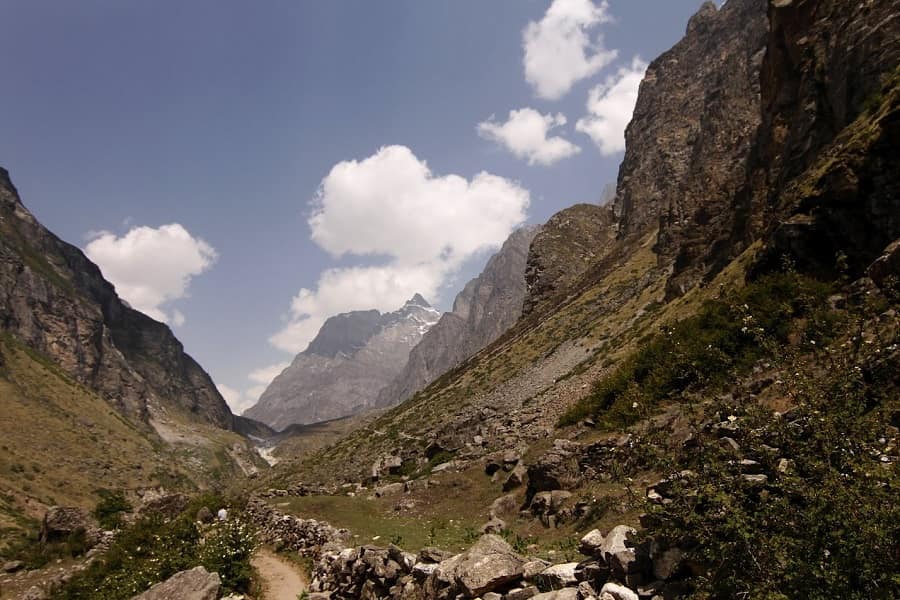
How Arduous is Satopanth Tal Trek
Although the trekking trail to reach the pristine glacial lake in Uttarakhand is of moderate level yet there are some challenges you are surely going to face.
Attitude Gain
- One of the most challenging things on a trek is steep attitude gain as when you climb up the hills, oxygen level in the atmosphere goes down. Our heart and the respiratory organs are bound to function more heavily and this is how acute breathing problems might also occur to someone.
Steep Climb on the 3rd Day
- You will be gaining an altitude of more than 2500 feet in altitude, so be ready for some heavy legwork. Do not forget to keep a water bottle with you to stay hydrated and also carry extra snacks in your bag so that you feel energized throughout the day.
Climate and Temperature
- One needs to stay updated with the weather forecast and be prepared for a sudden drop in the temperature, especially during the night. You will be acclimatizing for a day so that your body gets adapted to the cold climate of the region. The temperature often goes down to a sub-zero level and ranges between -5 and -7 degrees Celsius.
Mountain Sickness
- Altitude Motion Sickness is one of the most common challenges faced by the trekkers as there is a bit of rising in the altitude while climbing up to Satopanth Tal Lake. Altitude Motion Sickness is similar to motion sickness that causes headaches and nausea to the traveler. However, it is not a very serious problem but if ignored initially then it can become very dangerous.
Physical Fitness
- One needs to be physically very fit and should have great strength or else trekking to the height of 2000- 2500 feet is not possible. The entire terrain is covered with loose rocks, moraines, and boulders making the walk pretty stressful for the ankles and knees.
- The entire valley from Chakratirtha to Satopanth Lake is bedecked with thick sheets of snow throughout the year. One needs to be very smart and attentive while packing their trekking bags as your backpacks must include UV protected sunglasses to deal with the snow blindness, good pair of trekking shoes to comfortably walk on the moraines, and a good pair of gloves to keep your hands warm and help with snow handling.
Frequently Asked Questions about Satopanth Tal Trek
It is quite obvious for a traveler to have his/her mind filled with plenty of questions when they plan for this trekking trail. We have enlisted a few of the most commonly asked questions of the trekkers about this thrilling adventure.
Q: How High is Satopanth
- Ans- This crystal clear green water lake is nestled beautifully at an altitude of 4600 meters above sea level.
Q: How Do you Reach There?
- Ans – Badrinath is the starting point of this adventurous trail and then from there, one move to Mana Village. From this place, you will be crossing two campsites, first at Lakshmi Van and the other one is at Chakratirtha.
Q: Where is This Gorgeous Lake Located?
- Ans- This glimmering lake is located in the Chamoli district of Uttarakhand. Satopanth Lake is located closer to Badrinath Dham and is easily accessible from Mana Village.
Q: What is the Itinerary of the Satopanth Tal Trek?
Ans- The itinerary for this thrilling experience goes as follows-
- Day 1- Rishikesh to Badrinath
- Day 2- Badrinath to Lakshmi Van
- Day 3- Lakshmi Van to Chakratirtha
- Day 4- Chakratirtha to Satopanth and then return to Chakratirtha
- Day 5- Chakratirtha to Mana and then to Badrinath
- Day 6- Badrinath to Rishikesh
Q: How Difficult is Satopanth Trek
- Ans- The trek is of moderate to difficult level and you need to have prior trekking experience and a high fitness level to cover this trekking trail.
Leave a Reply Cancel reply
Your email address will not be published. Required fields are marked *
Save my name, email, and website in this browser for the next time I comment.
This site uses Akismet to reduce spam. Learn how your comment data is processed .

Satopanth Tal Trek
Satopanth tal.

Description
Reviews (2), things to take, available dates, include / exclude, the satopanth tal trek is a popular trekking route in the indian state of uttarakhand. it leads to a glacial lake called satopanth tal uttarakhand himalayas.
The Satopanth Tal trek is a captivating journey through the majestic Himalayan landscapes of Uttarakhand, India. Here’s an overview of what you can expect:
- Location : Situated in the Chamoli district of Uttarakhand, the trek starts from Mana village, which is near the famous pilgrimage site of Badrinath.
- Duration : The trek typically takes around 6-8 days to complete, depending on the route and pace chosen by trekkers.
- Altitude : The trek reaches a maximum altitude of approximately 4,600 meters (15,092 feet) at Satopanth Tal, which is a glacial lake surrounded by towering peaks.
- Terrain : The trail winds through diverse terrain, including dense forests, rocky paths, alpine meadows, and glacial moraines. Trekkers encounter steep ascents and descents, as well as river crossings along the way.
- Mana Village: Starting point of the trek and the last inhabited village on the India-China border.
- Vasundhara Falls: A stunning waterfall along the route, believed to be associated with Hindu mythology.
- Chakratirtha: A picturesque campsite offering panoramic views of surrounding peaks.
- Satopanth Tal: The ultimate destination, a pristine glacial lake surrounded by snow-clad peaks. It is considered sacred by Hindus and holds mythological significance.
- Challenges : The trek presents various challenges, including high altitude, unpredictable weather, and rugged terrain. Proper acclimatization, physical fitness, and adequate preparation are essential for a successful journey.
- Best Time to Visit : The trek is usually undertaken from May to October, during the summer and autumn months, when the weather is relatively stable and the trail is accessible. However, conditions can vary, so it’s essential to check weather forecasts and trail conditions before planning the trek.
Overall, the Satopanth Tal trek offers a memorable adventure amidst the pristine beauty of the Himalayas, attracting trekkers seeking both physical challenge and spiritual rejuvenation.
Wishes here never go unfulfilled in Satopanth Tal
Satopanth Tal is a High Altitude Lake at a height of 4,600 Meter. It is one of the virgin treks not known by many but the trekker and sadhu sant or local people of the area believe that this lake is sacred and possess some supernatural power of fulfilling wishes.
The Satopanth Tal is between two beguiling the trail is thrilling through dense forest, meadows with enchanted beauty and some steep ridges but the panorama views from the top cannot be described in words.
Trek to this sacred Tal is a difficult one but as the beliefs of people wishes are fulfilled here so it’s worth going there, this part of swargarohini the way to Heaven.
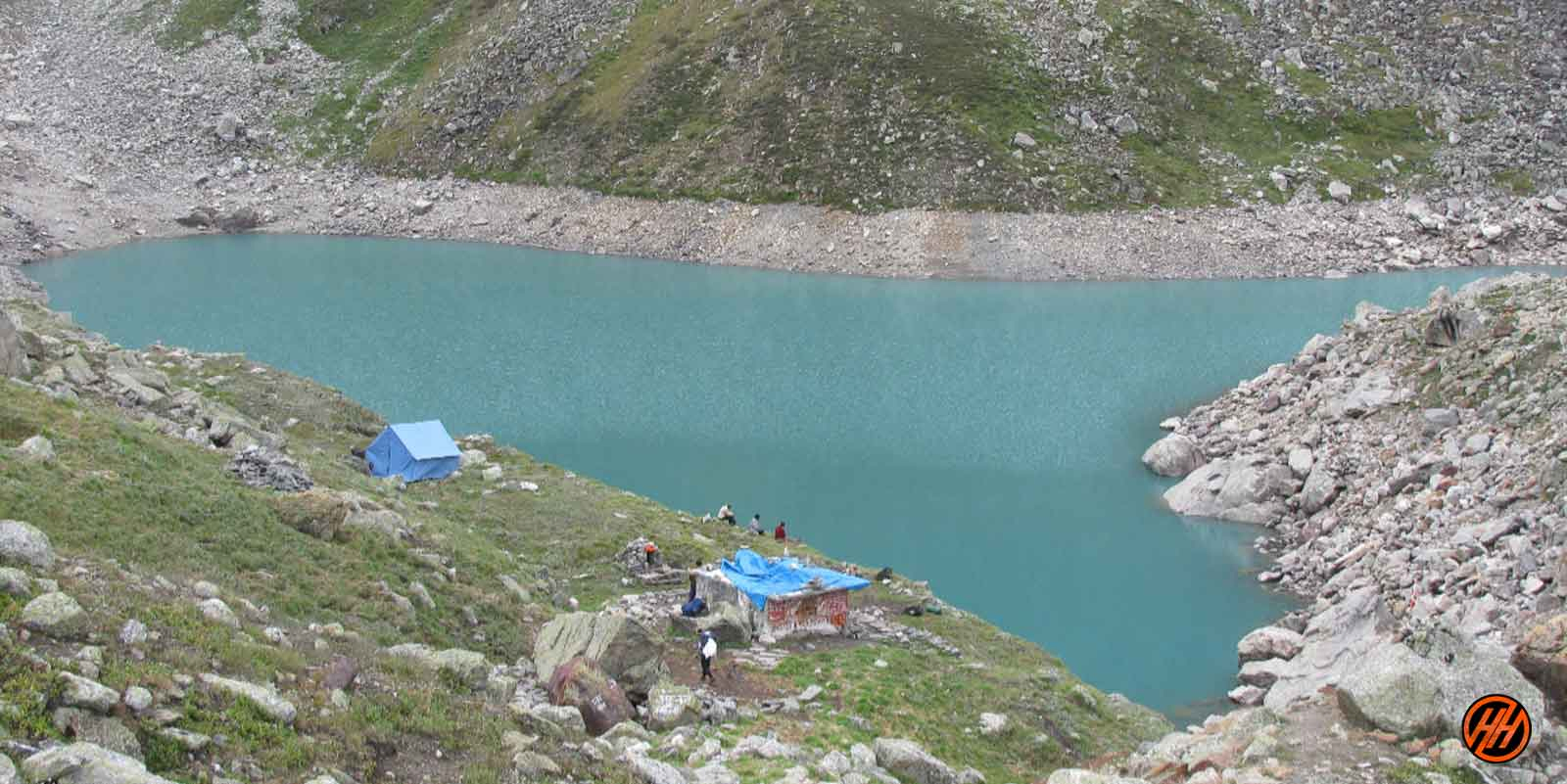
Story of Satopanth Tal Trek
It is believed that Lord Brahma, Vishnu and Mahesh often took bath in the waters of Satopanth Tal since then it is considered sacred and pure. Devotees believe that a holy dip in Satopanth Tal will wash away so every year thousands of people visit this place.
To reach this Lake, trek through some Himalayan villages , wide meadows with several streams en route and go through glaciated tracks. It is going to be an adventurous journey.
Mountain views, the great snow-capped peaks visible are Nilkanth, Swargarohini , Narayan Parbat and Balakun with some thrilling views of Chaukhamba Peaks .
Best Time to Visit Satopanth Tal Trek ?
Satopanth Tal trek is a very beautiful and an Moderate trek in the Uttarakhand Himalaya The Satopanth Tal trek is great for those people who have a great passion for mountaineering and consider it a special purpose in their life. Satopanth Tal trek is such a trek where you get to see more than one Himalayan mountain range..
You can do Satopanth Tal trek May, June, July, September, October, For those who like summer treks, they can go summer treks are a very good time for those who want to see snow Glacier Greenery .
Satopanth Tal trek is also a good trek for Monsoon trek at that time there are flowers and green greenery which makes the trek very memorable.
The Satopanth Tal trek starts from Mana Village near Badrinath in Uttarakhand, state India which comes in Gharwal Mountain Range District Chamoli
During the day the temperature of Satopanth Tal trek is around ( 08°C to 18 °C and during the night the temperature comes down to 05 °C to 08 °C which is not bad.
You will never consider yourself boring in Satopanth Tal trek , this trek can give you nothing but joy, You will get to see the Garhwali and Bhotiya, Traditional culture in mana village this trek which will always keep you connected towards the mountain. Himalayas.
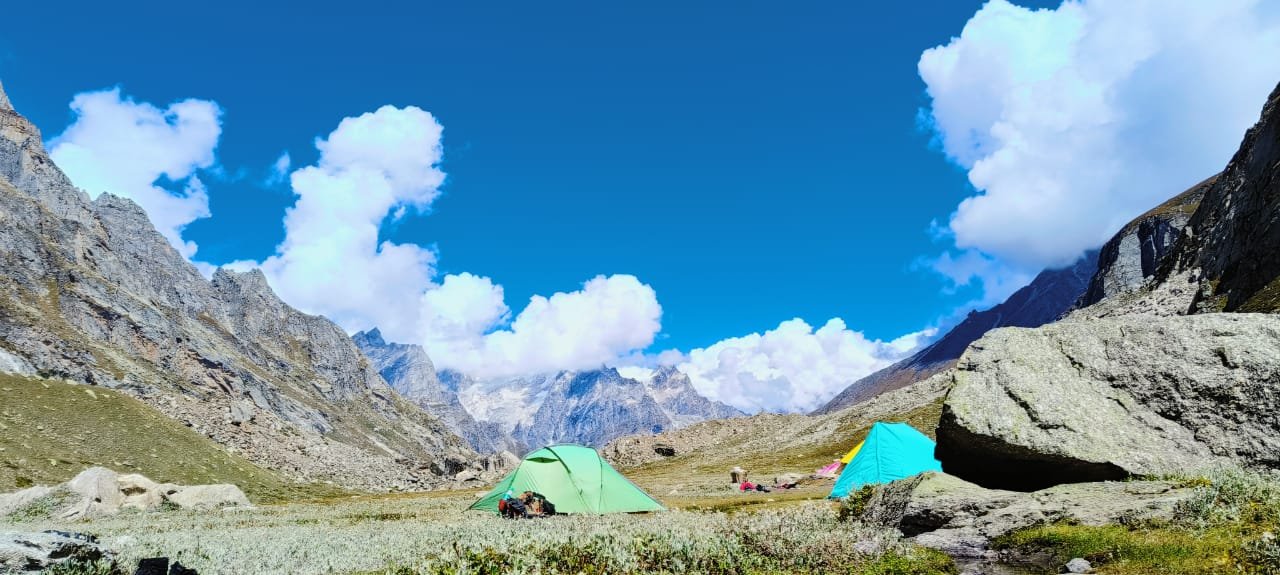
Badrinth Dham Base Camp of Satopanth Tal Swargarohini
The base camp for the Satopanth Tal trek is typically set up in or around the town of Badrinath, which serves as the starting point for the trek. Here’s an overview of Badrinath and its significance as the base camp:
- Location : Badrinath is a town located in the Chamoli district of Uttarakhand, India. Situated at an elevation of approximately 3,100 meters (10,170 feet) above sea level, it is one of the Char Dham pilgrimage sites and is revered by Hindus.
- Accessibility : Badrinath is well-connected by road to major cities like Dehradun, Rishikesh, and Haridwar. The nearest airport is the Jolly Grant Airport in Dehradun, and the nearest railway station is in Haridwar.
- Pilgrimage Site : Badrinath is famous for the Badrinath Temple, dedicated to Lord Vishnu. It is one of the holiest shrines in Hinduism and attracts thousands of devotees and tourists every year, especially during the pilgrimage season.
- Base Camp Facilities : As the base camp for the Satopanth Tal trek, Badrinath offers various facilities and amenities for trekkers, including accommodation options ranging from budget guesthouses to more comfortable hotels. Trekkers can also find restaurants, shops, and equipment rental services in the town.
- Acclimatization : Since Badrinath is situated at a relatively high altitude, it serves as an ideal location for trekkers to acclimatize before starting the trek to higher elevations. It’s essential for trekkers to spend a day or two in Badrinath to adjust to the altitude and prepare for the journey ahead.
- Starting Point : From Badrinath, trekkers begin their journey towards Satopanth Tal, following a well-defined trail that passes through scenic landscapes, including forests, meadows, and rocky terrain.
Difficulty level is Satopanth Tal trek ?
The Satopanth Tal trek is considered to be of moderate to challenging difficulty. Here’s why:
- High Altitude : The trek reaches altitudes above 4,000 meters (13,000 feet), with the highest point being around 4,600 meters (15,092 feet) at Satopanth Tal. Altitude-related challenges such as altitude sickness can affect trekkers, so proper acclimatization is crucial.
- Terrain : The trek involves a variety of terrain, including rocky paths, steep ascents and descents, glacial moraines, and possibly snow-covered sections, especially early in the trekking season. Trekking poles and sturdy footwear are recommended to navigate the terrain.
- Weather : Weather conditions in the Himalayas can be unpredictable, with the possibility of sudden changes, including rain, snow, and high winds. Trekkers should be prepared for varying weather conditions and dress accordingly with layers.
- Duration and Distance : The trek typically takes 6-8 days to complete, covering a distance of approximately 60-70 kilometers (37-43 miles) round trip. Daily hiking distances can vary, with some days involving longer stretches and more challenging terrain.
- Physical Fitness : While prior trekking experience isn’t always necessary, a good level of physical fitness is recommended to undertake the Satopanth Tal trek. Regular cardiovascular and strength training exercises can help prepare for the demands of the trek.
- Remote Location : The trek takes place in a remote and relatively isolated region of the Himalayas. Facilities such as accommodation and medical assistance may be limited along the route, so trekkers should be self-sufficient and prepared to deal with emergencie
Satopanth Tal trek trek safe for Beginner ?
Yes Satopanth Tal trek is a safe trek if you are going with a good trekking team which you must know before booking yourself, It is important for you to know that the bow trekking organization with which we are going is right or not, The minimum age required to trek Satopanth Tal trek is 12 years and maximum 60 years. The rest depends on your fitness .
- High Altitude : The trek reaches altitudes above 4,000 meters (13,000 feet), which can pose risks of altitude sickness for inexperienced trekkers. Beginners may not be accustomed to the effects of high altitude on their bodies, making them more susceptible to altitude-related illnesses.
- Physical Demands : The trek involves long hours of walking each day, covering rugged terrain with steep ascents and descents. Beginners may not have the necessary physical fitness or stamina to handle the demands of the trek, leading to exhaustion or injury.
- Limited Facilities : The trek takes place in a remote and relatively isolated region of the Himalayas, where facilities such as accommodation, medical assistance, and rescue services may be limited. Beginners may not have the experience or resources to deal with emergencies that may arise during the trek.
- Weather Conditions : Weather conditions in the Himalayas can be unpredictable, with the possibility of rain, snow, and high winds. Beginners may not have the knowledge or equipment to deal with adverse weather conditions, increasing the risks associated with the trek.
- Experience : The Satopanth Tal trek requires some level of prior trekking experience to navigate the terrain, manage altitude-related challenges, and ensure safety throughout the journey. Beginners may benefit from starting with shorter and less challenging treks to build up their skills and confidence before attempting more difficult treks like Satopanth T
What should you keep in mind for the Satopanth Tal trek?
Satopanth Tal trek trek is as good as it is said, you also need to be prepared., Satopanth Tal is a moderate trek which starts from Mana Village and ends after trek Mana Village
So what are the special things to keep in mind before coming on this trek?
Satopanth Tal trek is one such trek, which you can do this trek Summer, or Monsoon, this is very safe trek in Uttarakhand Himalayas.
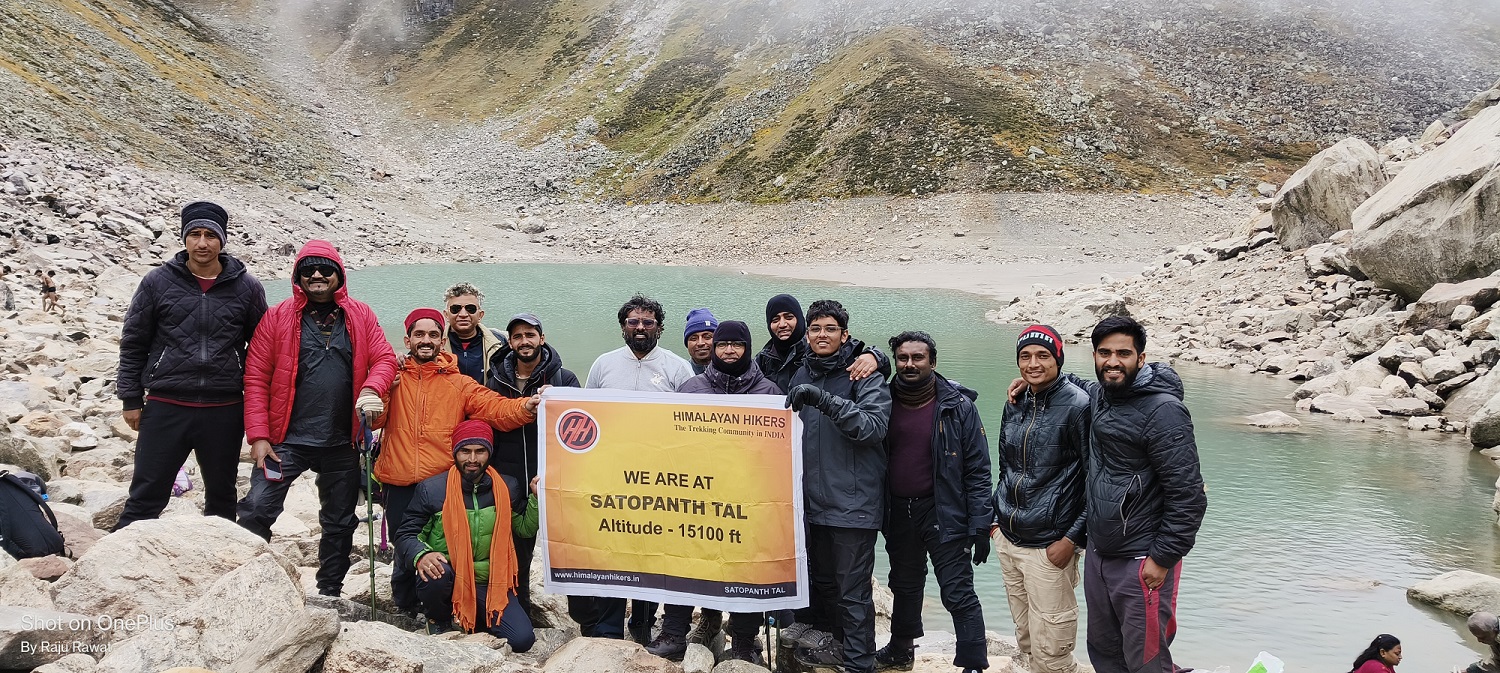
Summer Season
- Summer trek to Satopanth Tal is very special, the view and the temperature are all favorable to you
- For summer trek, you have to bring only normal clothes, so that your trek can be good, there is no need for hot clothes, but in hiking it is also necessary to bring all the equipment which is necessary for you.
- It is necessary to have 3 pairs of clothes from trekking, especially the poncho, you will have to bring every season
- In the summer season, the temperature is always normal, so there is no need for hot clothes.
Monsoon Season
- During the monsoon season, it rains occasionally during the Satopanth Tal trek especially in the Uttarakhand Himalayas , so if you have dry clothes here, it is very good, even when wet, it dries quickly.
- At this time you have to bring at least 3 pairs of clothes, for monsoon trek you do not have to bring too warm clothes, at this time you, hiking pants and t-Sart, I can trek
- It’s only a little cold in the morning and evening and the day is a good temperature for you
- Before going on any trek, it will be easy for you to take information related to each season.
- Trekkers need to know about these, you can ask us anytime like, Satopanth Tal trek route, trek map, temperature, weather condition, difficulty level, trek starting point, end point, transport, view of the trek, best time to visit, How to reach Satopanth Tal distance etc, Trek Location, keep this information before going
- 5. You also find some types of flowers in Satopanth Tal which are very beautiful, these treks are very safe trek for monsoon.
Brief Details of Satopanth Tal?
Before heading towards the itinerary, it is really essential to perceive the reason behind choosing Satopanth Tal trek.
See firstly, the trekking distance is a total of by taxi 680 Km both side and on foot 46 km which is to be covered into 07 days. Dehradun to Dehradun
Satopanth Tal is a high altitude mountain trek Altitudes is 4600 meters
The Starting trail is moderate as compare to other treks this is moderate trek. So this trek is good for beginners’ trekkers
Need proper gear & clothing for sub-zero temperature?
You got to see so many heavenly bodies at one place like the panoramic view of the Himalayan ranges, you can see pine forests, different variety of flora and fauna surpassing through bona fide Garhwali culture.
I think Do spare time in Interaction with our local’s team, and you will get to know about some of the ancient tales of Indian mythology and our local cultures, this is good ideas for trekkers
Beautiful landscapes so carry proper photo gear & Extra battery backup.
The backpack should not exceed 12 kg only
Trekker carry your Photo ID , Adhar card , Passport , Visa , for entry at forest check posts on the trek it is very important
Alcohol and non-Veg and smoking is not allowed in during the trek
Altitude we are going to cover in Satopanth Tal
Joshimath (6152 feet)
Laxmivan (08 km) (4/5 Hours) (12,510 feet)
Chakratirth (13,655 feet)
Satopanth tal (14,755 feet)
Key Points of Satopanth Tal Trek
Duration: – 07 Nights 08 Days from Dehradun to Dehradun
Base camp: – Badrinath
Summer Temperature: – Day (5°C to 15°C) Night (6° C to 12° C)
Satopanth Tal – Altitude: – (17,987 feet)
Best Time: – May, June, September, October
Trek Level: – Moderate
Trek distance: – On foot 46 Km – By taxi 680 km
Group Size: – 15 people
Short Itinerary of Satopanth Tal –
Day 1– Drive from Dehradun to Joshimath Altitude – Joshimath by taxi (256 Km) (10/11 Hours) (1,875 m/ 6152 feet) Overnight stay Hotel
Day 2- Drive from Joshimath to Badrinath by taxi (48 km) (2/3 Hours) Reach hotel need proper acclimatization Overnight stay Hotel
Day 3- Trek from Badrinath to Laxmivan (08 km) (4/5 Hours) (12,510 feet) Overnight stay Camp
Day 4- Trek from Laxmivan to Chakratirth (10 km) (5/6 Hours) (13,655 feet) Overnight stay Camp
Day 5- Trek from Chakratirth to satopanth Tal (10 km) (8/9Hours) (14,755 feet) back to Camp Overnight stay Camp
Day 6- Trek from Chakratirth to Laxmivan (10 km) (4/5 Hours) Overnight stay Camp
Day 7- Trek from Laxmivan to Badrinath via mana village (08 km) Overnight stay Hotel
Day 8- Drive from Badrinath to Dehradun by taxi (380 km) (11/12 Hours)
Things Himalayan Hikers recommend
As previously stated, a camera, as well as spare batteries and memory cards, are recommended. We can assure and guarantee that you will be stopping frequently along the trail to observe the grandeur of the trekking experience.
After the trek, we strongly encourage trekkers to tag us on social media when they post any memories from the trip; this will not only prove invaluable to us with our work, but will also serve as a motivational example for all of our experts.
Why you should choose us
We’re here to give you the greatest experience possible through the eyes of highly skilled and qualified specialists who have a passion for adventure sports. We are community members attempting to promote our favorite adventure sports while also supporting local businesses. We, at Himalayan hikers Local trekking organization in Uttarakhand , dedicate ourselves to providing you with an unforgettable experience.
Weather conditions satopanth tal
The weather conditions around Satopanth Tal can vary depending on the season and altitude. Here’s an overview of the typical weather conditions you might encounter during different times of the year:
- Spring marks the beginning of the trekking season in the region.
- Weather gradually warms up, but temperatures can still be chilly, especially at higher altitudes.
- Days are generally pleasant with clear skies, making it a popular time for trekking.
- However, occasional snowfall or rain showers may occur, especially in March and early April.
- Summer brings warmer temperatures to the region, but it’s also the monsoon season.
- Expect frequent rainfall, especially in July and August, which can make trekking trails muddy and slippery.
- Cloud cover may obscure mountain views, but the surrounding landscape is lush and green.
- Autumn is another popular trekking season characterized by clear skies and stable weather conditions.
- Days are generally sunny with comfortable temperatures, making it ideal for trekking.
- The foliage begins to change colors, creating stunning views of the surrounding mountains.
- Nights can be cold, especially at higher elevations, so be prepared with warm clothing.
Things to carry
1) Because nights at higher elevations tend to be substantially colder, we suggest having well-graded, warm and comfortable clothing along with good quality shoes.
2) Despite the fact that we handle medical crises, we urge individuals to keep their emergency kits at hand in any case of personal underlying illnesses.
3) Since the journey provides you with a picturesque view, don’t forget to bring your camera along with extra batteries.
4) All the trekking gears will be provided by our teams hence a we recommend carrying only the important luggage with essentials
You r Travel Plan for the Satopanth Tal Trek
You can book trains, air flights, and bus tickets for your journey only according to the information given by us.
The Satopanth Tal trek will be of 6 days and 02 days of your journey total of 08 Days from Dehradun to Dehradun
First of all, all the trekkers will have to book their flight and train bus according to our time table as our pick up is from 6 am to 7 am, you will have to reach Dehradun in the morning.
A taxi from Himalayan Hikers will link you to the Dehradun Railway station.
Himalayan Hikers organize transport to Badrinath base camp from Dehradun Railway station. Our vehicles leave at 6:00 am to 7:00 am sharp from Dehradun
In the Dehradun Railway Station, you will get our staff that will arrange transport for you. The contacts no Transport coordinator or our office team will give you a week ago to your departure
Please you guys book your transport facility according to your own time table, after Himalayan Hikers take all the responsibility of Dehradun to Dehradun , that you will not face any problem.
How to reach Satopanth Tal Trek ?
If you are Traveling from Kolkata, Bangalore, Chennai, Pune, Mumbai, Maharashtra, or Gujarat, Delhi Hyderabad any other State , so you will have to come to Delhi, you will get a train from Delhi for Dehradun comfortably.
Option 01:- By Train
All trekkers booked yourself the,
Nanda Devi Express to Dehradun v (Train no is 12402 Departure 11:30 pm: – Reached Haridwar 3:53 am a morning
Take the overnight train Dehradun to from new Delhi- Dehradun Special A/C train from Hazrat Nizamuddin railway station the best option for you. The train reached at Haridwar railway station morning 3:53 am to 4:30 am if you Meet to Our office Member – joining to our upcoming batches and Group.
Option 02:- By Air –
Jolly Grant airport is the nearest airport in Dehradun , Rishikesh or Haridwar, Located about 27 km for the Dehradun main city. There are flights available from all states to Dehradun Airport, you can go online and book your tickets. These are easy and easy ways for you and you also save your time, Taxis are available from the airport to Dehradun, Rishikesh or Haridwar at all time costs Rs. 1000/* one-way pay to directly
Option 03:- By Bus
You can reach Dehradun Bus Stand ISBT from Delhi by a bus, board it from (Delhi) Kashmiri Gate ISBT; it is good if you are booked the seats.
Day 1 : Pickup from Dehradun/Haridwar Railway Station and Drive to Joshmath by Taxi or tempo travellers
Total distance – 280 km – 10/11 Hours journey
Mode of journey – By taxi
Altitude – Joshimath– 6152 feet
Night stay – Hotel – on twin share basis
Himalayan Hikers organizes transport for trekkers from Haridwar Railway Station in the morning which will leave for Sankri around 6:00 am to 7:00 am.
The journey from Dehradun or Haridwar Railway Station to Joshimath typically involves a scenic drive through the Himalayan foothills and passes through several towns and villages. Here’s an overview of the route and some key points of interest along the way:
- Your journey begins at either Dehradun or Haridwar Railway Station, depending on your starting point.
- Dehradun is the capital city of Uttarakhand and offers picturesque views of the Shivalik range.
- Haridwar is a sacred city situated on the banks of the Ganges River, known for its temples and ghats.
- Rishikesh is a popular stopover point known as the “Yoga Capital of the World.”
- The town is renowned for its spiritual significance, yoga ashrams, and adventure activities like river rafting.
- Devprayag is the confluence of the Bhagirathi and Alaknanda rivers, which merge to form the Ganges River.
- It’s a significant pilgrimage site and offers stunning views of the confluence.
- Not to be confused with the city in Jammu and Kashmir, Srinagar is a town in Uttarakhand known for its scenic beauty.
- It’s situated on the banks of the Alaknanda River and offers beautiful views of the surrounding mountains.
- Chamoli is a district headquarters town and serves as a major administrative center in the region.
- The town is surrounded by lush greenery and offers glimpses of traditional Garhwali architecture.
- Joshimath is a significant town and a gateway to several Himalayan treks, including the trek to Satopanth Tal.
- It serves as a base camp for pilgrims visiting the revered temples of Badrinath and Hemkund Sahib.
- The town offers breathtaking views of the Nanda Devi and Neelkanth peaks.
Day 2 : Drive from Joshimath to Badrinath by taxi or tempo travellers overnight stay Hotel
Total distance – 48 km – 2/3 Hours journey
Altitude Badrinath– 10,170 feet
Night Stay – Hotel – on twin share basis
The journey from Joshimath to Badrinath is a picturesque drive through the Garhwal Himalayas, offering stunning views of snow-capped peaks, lush valleys, and sacred rivers. Here’s an overview of the route and some notable locations you’ll encounter along the way:
- Your journey begins in Joshimath, a significant town in the Chamoli district of Uttarakhand.
- Joshimath serves as a base camp for treks to several Himalayan peaks and pilgrimage sites, including Badrinath.
- Vishnuprayag is the first of the Panch Prayag (five confluences) along the Alaknanda River.
- It marks the confluence of the Alaknanda and Dhauliganga rivers, with a picturesque setting surrounded by mountains.
- Hanuman Chatti is a small village and a popular starting point for the trek to the holy shrine of Yamunotri.
- It’s located at the confluence of the Hanuman Ganga and Yamuna rivers, offering serene natural beauty.
- Mana Village is the last inhabited village on the India-China border and holds mythological significance.
- It’s believed to be the home of Vyasa, the author of the Mahabharata, and attracts pilgrims and tourists alike.
- Bheem Pul is a natural rock bridge over the Saraswati River, named after the Pandava prince Bheem from the Mahabharata.
- Legend has it that Bheem placed this bridge to help Draupadi cross the river during their exile.
- Badrinath is one of the Char Dham pilgrimage sites and is dedicated to Lord Vishnu.
- The town is nestled between the Nar and Narayana mountain ranges and offers breathtaking views of the Neelkanth peak.
- The Badrinath Temple, dating back to the 8th century, is the main attraction and draws thousands of devotees each year.
The drive from Joshimath to Badrinath takes approximately 1.5 to 2 hours, covering a distance of around 45 kilometers (28 miles). The route offers spectacular vistas of the Himalayan landscap
Day 3 : Trek from Badrinath to Laxmivan overnight stay Camp
Trek Distance – 08 km – 4/5 Hours journey
Mode of journey – On foot
Altitude – Laxmivan – 12,510 feet
Night Stay – Camp – on twin share basis
The trek from Badrinath to Laxmivan is a scenic journey through the Himalayan wilderness, offering breathtaking views of snow-capped peaks, alpine meadows, and pristine forests. Here’s an overview of the trek route, difficulty level, location, and overnight camping options:
- The trek from Badrinath to Laxmivan typically follows a trail that ascends gradually through the valley alongside the Saraswati River.
- The route passes through dense forests of pine, deodar, and rhododendron trees, offering opportunities to spot diverse flora and fauna.
- Along the way, trekkers may encounter small streams, waterfalls, and picturesque meadows, making for a scenic journey.
- The trek from Badrinath to Laxmivan is considered to be of moderate difficulty.
- While the trail is generally well-defined, it involves ascending terrain and some steep sections.
- Trekkers should have a reasonable level of fitness and be prepared for several hours of hiking each day.
- Badrinath: The trek begins in the town of Badrinath, located in the Chamoli district of Uttarakhand. Badrinath is a significant pilgrimage site and serves as the base for treks to various destinations in the region.
- Laxmivan: Laxmivan is a scenic camping site located at an elevation of around 3,500 meters (11,500 feet) above sea level. It’s situated amidst lush green meadows surrounded by towering peaks, offering a serene and picturesque setting for overnight camping.
- Laxmivan serves as an ideal overnight camping site for trekkers en route from Badrinath to higher altitudes.
- Trekkers can set up their tents amidst the meadows and enjoy stunning views of the surrounding mountains.
- It’s advisable to carry camping equipment, including tents, sleeping bags, and cooking supplies, as facilities may be limited in remote areas like Laxmivan.
- En route to Laxmivan, trekkers are treated to panoramic views of the Neelkanth peak and other snow-capped mountains.
- The trek offers opportunities for birdwatching and wildlife spotting, with chances to see species like the Himalayan monal, musk deer, and langur monkeys.
- Laxmivan provides a tranquil setting for stargazing and experiencing the serenity of the Himalayan night sky.
Day 4 : Trek from Laxmivan to Chakratirth overnight stay Camap
Trek Distance – 10 km – 5/6 Hours journey
Altitude – Chakratirth – 13,655 feet
The trek from Laxmivan to Chakratirth is another enchanting leg of the journey through the Himalayan wilderness, offering stunning landscapes and serene camping spots. Here’s an overview of the route, overnight camping options, distance, trek level, and scenic highlights:
- The trek from Laxmivan to Chakratirth continues along a well-defined trail that winds through alpine meadows and rocky terrain.
- The route gradually ascends, offering panoramic views of the surrounding peaks and valleys.
- Trekkers will pass through patches of dense forests, open meadows, and possibly encounter small streams along the way.
- Chakratirth serves as an excellent overnight camping site for trekkers en route from Laxmivan to higher elevations.
- Located at an altitude of around 3,800 meters (12,500 feet) above sea level, Chakratirth offers expansive meadows surrounded by snow-capped peaks.
- Trekkers can set up their tents amidst the meadows and enjoy the tranquility of the Himalayan wilderness under the starry night sky.
- The distance from Laxmivan to Chakratirth is approximately 5-6 kilometers (3-4 miles), depending on the specific route taken.
- The trek typically takes around 3-4 hours to complete at a moderate pace, allowing time for breaks and enjoying the scenery.
- The trek from Laxmivan to Chakratirth is considered to be of moderate difficulty.
- While the trail is generally well-marked, it involves some steep sections and rocky terrain, requiring a reasonable level of fitness and hiking experience.
- Trekkers should be prepared for several hours of hiking and be cautious of altitude-related challenges as they ascend to higher elevations.
- Along the route, trekkers are treated to breathtaking views of the surrounding Himalayan peaks, including Neelkanth, Chaukhamba, and Hathi Parbat.
- Chakratirth offers a serene setting with lush green meadows, colorful alpine flowers, and the soothing sound of mountain streams.
- The area is ideal for photography enthusiasts, offering stunning vistas at every turn and opportunities to capture the beauty of the Himalayan landscape.
Day 5 : Trek from Chakratirth to Satopanth Tal summit then back to Camp
Trek Distance – 05 km – 4/5 Hours journey
Mode of journey – ON foot
Altitude – Satopanth Tal – 14,755 feet
Start the trek early today because you will be crossing some tricky sections on the trail. Ascent to the ridge’s high point and trek along the glacier to reach serene triangular “Satopanth Lake”. Get impressive views of Chaukhamba peaks and Neelkanth Mahadev.
The trek from Chakratirth to Satopanth Tal and back is the highlight of the journey, offering trekkers an opportunity to witness the stunning beauty of Satopanth Tal, surrounded by towering Himalayan peaks. Here’s an overview of the route, altitude, location, and scenic highlights:
- The trek from Chakratirth to Satopanth Tal involves ascending along a challenging trail that passes through rocky terrain, moraines, and possibly snow-covered sections.
- The route follows a gradual ascent, offering panoramic views of the surrounding mountains and valleys.
- Trekkers will cross streams, negotiate steep inclines, and navigate through high-altitude terrain before reaching the pristine shores of Satopanth Tal.
- Satopanth Tal is situated at an altitude of approximately 4,600 meters (15,092 feet) above sea level, making it one of the highest points of the trek.
- The ascent from Chakratirth to Satopanth Tal involves a significant altitude gain, so trekkers should acclimatize properly and pace themselves accordingly.
- Satopanth Tal is located in the Garhwal Himalayas of Uttarakhand, India, near the town of Badrinath.
- The glacial lake is surrounded by majestic peaks, including Neelkanth, Chaukhamba, and Balakun, creating a breathtaking backdrop for trekkers.
- Along the trekking route, trekkers are treated to stunning vistas of the surrounding Himalayan peaks, including snow-capped mountains, alpine meadows, and cascading waterfalls.
- Satopanth Tal itself is a mesmerizing sight, with its crystal-clear waters reflecting the azure sky and towering peaks.
- The area around Satopanth Tal is tranquil and serene, offering trekkers a chance to relax and soak in the natural beauty of the Himalayas.
- After spending time at Satopanth Tal, trekkers will retrace their steps back to their campsite at Chakratirth.
- The descent involves navigating the same trail in reverse, offering different perspectives of the landscape and allowing trekkers to enjoy the scenery from a new angle.
Overall, the trek from Chakratirth to Satopanth Tal and back is a challenging yet rewarding adventure, offering trekkers an opportunity to experience the pristine beauty of the Himalayas
Day 6 : Trek from Chakratirth to Laxmivan overnight stay Camp
Trek Distance – 10 km – 4/5 Hours journey
Mode of journey – on foot
Night Stay – Camp – on twin share basis
The trek from Chakratirth to Laxmivan offers trekkers a scenic journey through the Himalayan wilderness, with opportunities to enjoy the tranquility of the alpine meadows and majestic views of the surrounding peaks. Here’s an overview of the route and overnight camping options:
- The trek from Chakratirth to Laxmivan involves descending from the higher altitude of Chakratirth back to the serene meadows of Laxmivan.
- The trail may follow the same route taken during the ascent or may vary slightly, depending on the specific trekking itinerary.
- Trekkers will pass through lush forests, open meadows, and possibly encounter small streams along the way.
- Laxmivan serves as an ideal overnight camping site for trekkers descending from higher altitudes.
- Trekkers can set up their tents amidst the picturesque meadows and enjoy the tranquility of the Himalayan wilderness.
- Laxmivan offers a serene setting with panoramic views of the surrounding peaks, making it an ideal spot to rest and rejuvenate after a day of trekking.
Day 7 : Trek from Laxmivan to Badrinath via mana village
Mode of journey – By taxi – 15 km – On foot – 13 km
Altitude – Swargarohini base camp – 17,987 feet
Night Stay – Hotel – on twin share basis
The trek from Laxmivan to Badrinath via Mana Village offers trekkers a scenic and culturally enriching journey through the Himalayan landscape. Here’s an overview of the route:
- The trek from Laxmivan to Badrinath via Mana Village involves descending from the higher altitude of Laxmivan to the town of Badrinath, passing through the picturesque Mana Village along the way.
- The trail may follow a combination of descending paths through forests, meadows, and rocky terrain as it winds its way down to lower elevations.
- From Laxmivan, trekkers begin their descent towards Mana Village, trekking through alpine meadows and possibly crossing small streams.
- Trekkers will pass through scenic landscapes, including lush forests and open meadows, with opportunities to enjoy panoramic views of the surrounding mountains.
- From Mana Village, trekkers continue their descent towards Badrinath, following well-defined trails that wind through the Himalayan foothills.
- The trail may pass through quaint villages, terraced fields, and patches of dense forests, providing glimpses of local life and culture.
- Trekkers will eventually reach the town of Badrinath, a significant pilgrimage site and home to the revered Badrinath Temple dedicated to Lord Vishnu.
Day 8: Drive from Badrinath to Dehradun by taxi or tempo travellers
Distance – 328 km – 11/12 Hours journey
Mode of journey – By Taxi
The drive from Badrinath to Dehradun by taxi or tempo traveler offers travelers a scenic journey through the Himalayan foothills and valleys of Uttarakhand. Here’s an overview of the route:
- Your journey begins in the town of Badrinath, a significant pilgrimage site and home to the revered Badrinath Temple dedicated to Lord Vishnu.
- Badrinath is nestled between the Nar and Narayana mountain ranges, offering breathtaking views of the surrounding peaks.
- As you leave Badrinath, you’ll pass through Mana Village, the last inhabited village on the India-China border.
- Mana Village holds mythological significance and offers glimpses of traditional Himalayan culture and architecture.
- Chamoli is the district headquarters town and serves as a major stopover point along the route.
- The town is surrounded by lush greenery and offers picturesque views of the Alaknanda River and surrounding mountains.
- Srinagar is a town situated on the banks of the Alaknanda River and serves as another significant stopover point.
- The town offers opportunities to stretch your legs and enjoy local cuisine before continuing your journey.
- Devprayag is the confluence of the Bhagirathi and Alaknanda rivers, where they merge to form the Ganges River.
- The town is a sacred pilgrimage site and offers stunning views of the confluence.
- Rishikesh is a major town known as the “Yoga Capital of the World” and offers opportunities for adventure activities like river rafting and bungee jumping.
- It’s a popular stopover point where travelers can rest and explore before continuing their journey.
- Your journey ends in Dehradun, the capital city of Uttarakhand, known for its picturesque landscapes and colonial architecture.
- Dehradun is well-connected by road and rail to major cities like Delhi and offers plenty of accommodation options for travelers.
Mandatory Documents
Please carry the documents given below.
Original and photocopy of government photo identity card- (Aadhar Card, Driving License, Voters ID, etc, Passport and Visa important to foreigners Medical Certificate (First part should be filled by the Doctor and Second part by the Trekker) Declaration Certificates
Note: – Many trekkers commit the same mistake of carrying unnecessary items on a trek which only makes the backpack heavy. It is important to know the right items to carry. It differs from season to season if you are trekking in summers then carry less layers of warm clothing and if you are trekking in winters carry enough layers to protect yourself against chilly cold.
Necessary Items for trekkers

Backpack (50 to 60 liters) A strongly built backpack with good support is compulsory for a trek. (Rain cover is important)
Sturdy Trekking Shoes The shoes should be strong enough with good support. The people ask if sports shoes would be comfortable but it is good to bring the right trekking shoes.
The Clothes You Should Bring On a Trek Avoid keeping extra clothes because it only makes you backpack heavy.
Trek Pants – The jeans are never suitable for a trek so you need at least 2-3 trek pants for treks carry more for longer treks.
Jacket – Jackets are very important to carry on a trek it protects you against the chilly weather. So carry 2 jackets on a week long trek.
Layers of warm Clothing Carry warm woolen layers or fleece. Carry more layers during winter season (at least 2 to 3) and less during summer.
Thermals – The Temperature decreases at night so you might be need thermals for Night.
T- Shirts – Bring those t shirts which dry fast.
Poncho –They are needed if you are trekking on a Rainy day to keep you dry.
Hiking Pole
Water Bottle 2
Cap or Balaclava
Woolen and Waterproof Gloves
Socks (Woolen and Regular)
Torch head light
Personal Toiletry Items – (toothpaste, toothbrush, toilet paper, sanitizer etc.)
Carry Personal Medical Kit
Personal Medical Kit (Carry minimum 5 tablets and maximum 10)

Diamox – (Prevents altitude sickness)
Digene – (It cures discomfort in stomach, acidity)
Crocin Advance – (Cures fever and headache)
Aspirin/Combiflam – (Pain reliever)
Disprin – (Cures headache)
Avomine – (Prevents motion sickness)
Avil – (It treat allergies)
Norflox TZ & Lomofen – (Prevents Diarrhoea)
Ranitidine – (Reduces the amount of acid in stomach)
Volini/Moov spray – (For sprains)
Betadine/Savlon – (Antiseptic cream)
Stretchable/Elastic bandage
Note:- Use medicines only when prescribed by the doctor. In case you face any problem during your trek, discuss and take advice from the Professional guide.
Sorry! Here are no Available dates right now. For Any Queries you can Email us with [email protected] and Call Us +91 9756197558
- Satopanth Tal trek we do in small group, Small group is always safe and good, our own experience is that special care can always be taken for trekkers in small group
- We need to have minimum 5 people for Satopanth Tal
- Groups of up to 15 people are safe in Satopanth Tal
- We always tell Trekkers that you can feel yourself very comfortable with your own group
- One thing should always be kept in mind that in high altitude treks, only a small group should always be taken so that you can experience peace and joy.
- In small groups, always the group can be supervised very well
What is Included In This Trek?
Transport Facility
Forest Permit and entrance fee
Accommodation in tents on twin share basis
All meals: breakfast, packed lunch, tea, coffee, snacks, soup and dinner
(All camping gears)
High quality tents
Sleeping bags
Separate Toilet tents – Ladies and Gents
Dining Tent
Dining Table
Kitchen team
Radio Walkie Talkie for Communication
Good Experience Trek Leader guide and Technical guide
Medical Kit
Oxygen Cylinders
Crampons and Gaiters
What is Not Included In This Trek?
Personal Insurance
Medical Certificate
Personal toiletry Items and Personal Medicine kit
On first day En Route to base camp the Breakfast and Lunch are Not Included
Last Day En Route Lunch and Dinner are Not Included
2 reviews for Satopanth Tal Trek
Palash – November 19, 2019
Well organised
santanu das – November 19, 2019
Satopanth our first trek with Himalayan hikers, this is good company in Uttarakhand,, service and food very good, thanks to Himalayan hikers all team
Your email address will not be published. Required fields are marked *
Name *
Email *
Save my name, email, and website in this browser for the next time I comment.
Related Tours
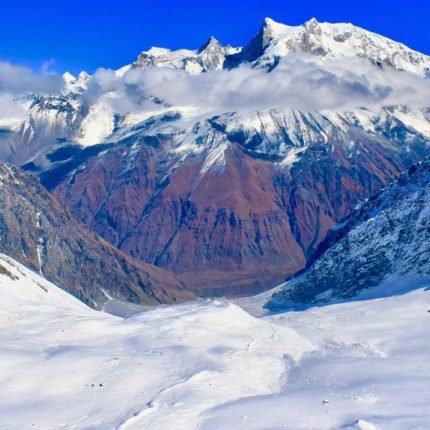
Bali Pass Trek
Bali pass Connecting Ruinsara valley to Yamunotri valley.
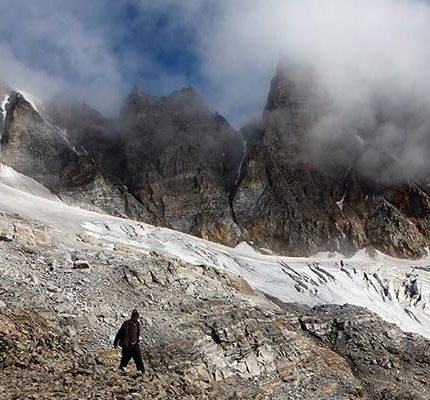
Gupt Khal Trek
It is lies in at an a altitude of 5,807 m in Chamoli, Uttarakhand India.
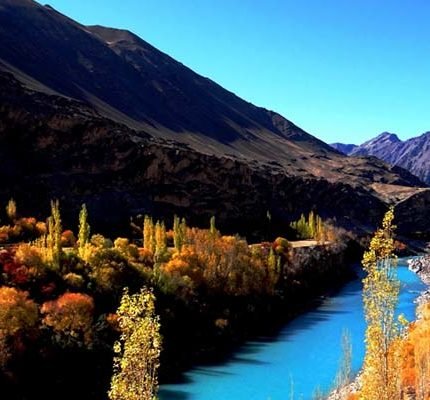
Sham Valley Trek
The Sham Valley Trek has got one more name – “The Baby trek of Ladakh”.
Price: ₹ 30,000.00
Book the tour
Book your trek.
- Overview Itinerary Dates Include/Exclude
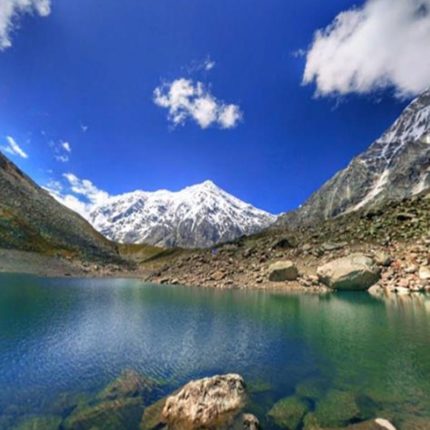
- Good Friday Weekend Trips
- Domestic Tours
- International Tours
- Upcoming Trips
- Corporate Program

Welcome Guest
- Uttarakhand
Satopanth Lake – Trek Itinerary
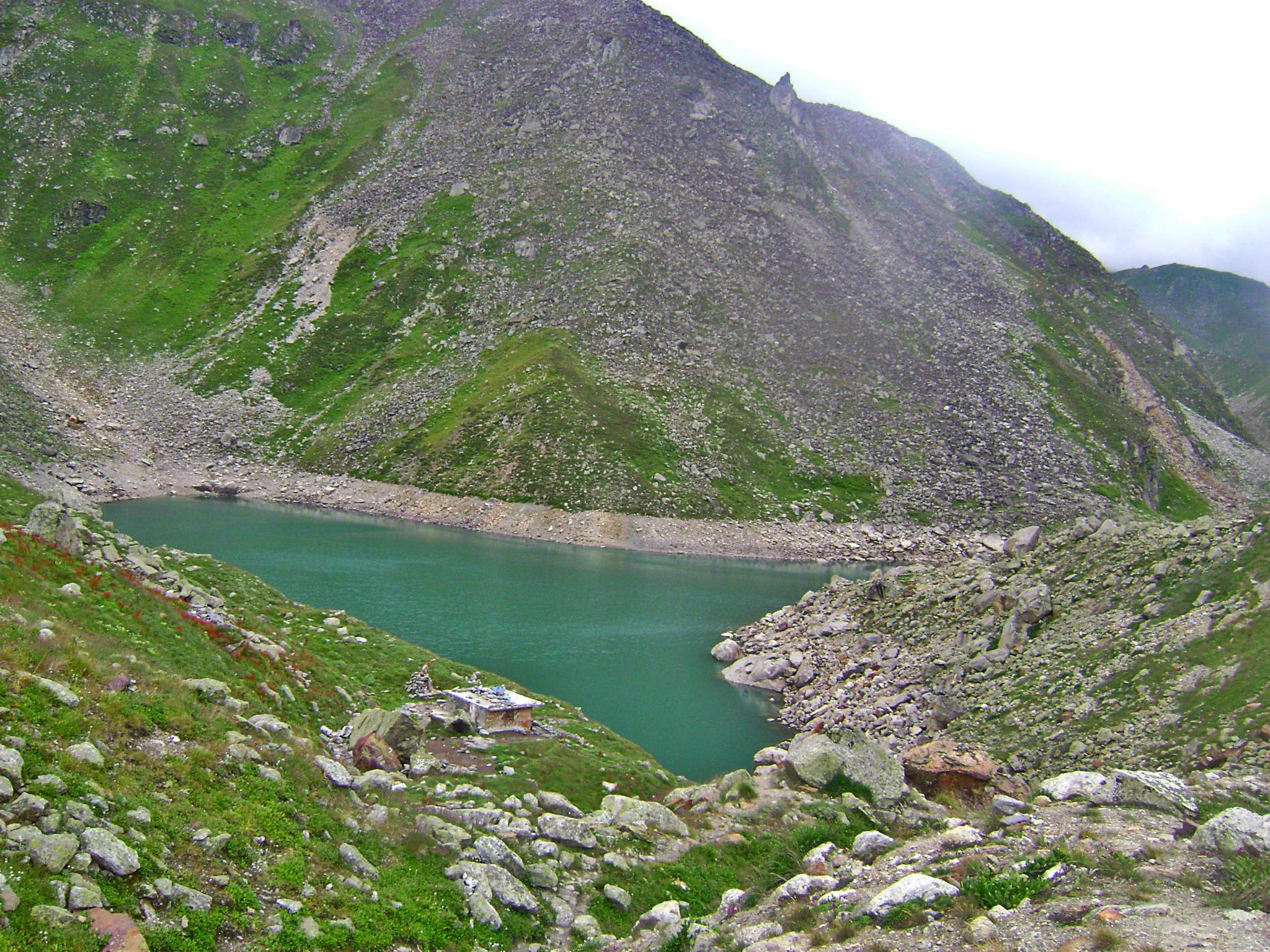
Written by Shubham Vyas 30 Mar, 2019
Have you ever walked on the path which leads to heaven? Have you ever felt the bone-chilling cold and still were motivated to move on and on? Have you trekked to one of the highest lakes in India whose altitude stands tall at 4600 meters? Well, I can proudly say, “Yes, I have.” Come on let me take you on a trek to Satopanth Lake and I will bust up some myths about the lake on the way up. So are you ready? Let’s go with the Satopanth Lake Trek Itinerary.
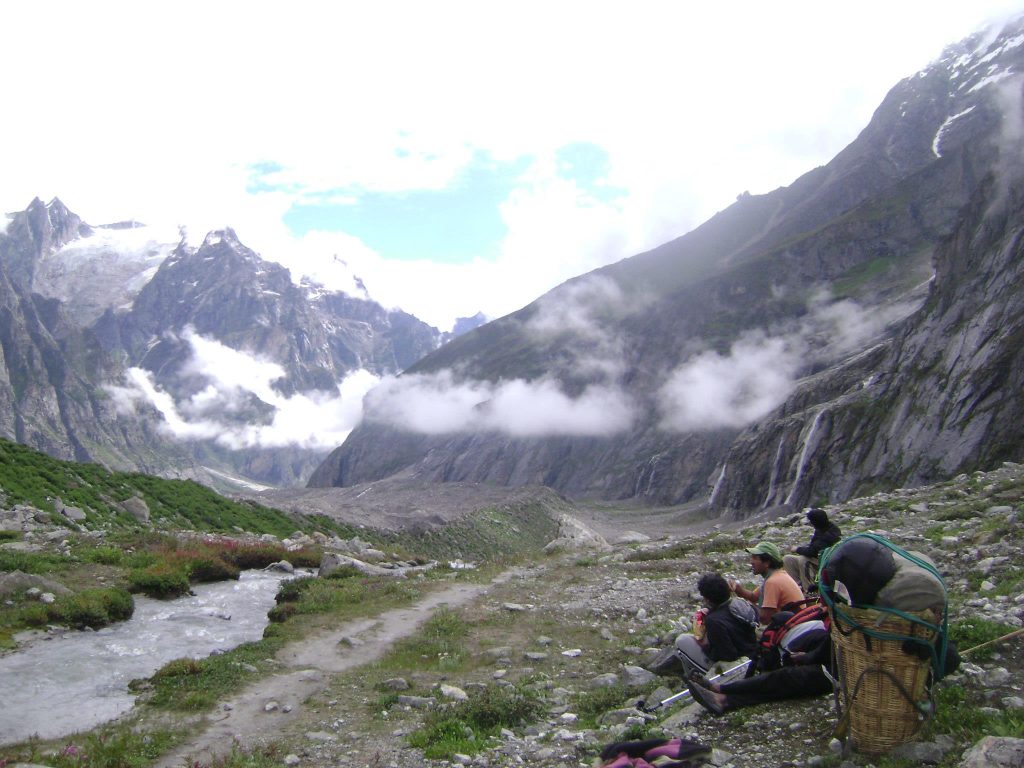
When I first came to know about this beautiful lake called Satopanth, I googled everything about it I could. But to my surprise, there was still a feeling of unknown and something that said to me that I need to visit this beautiful lake which has the elixir of heaven. And thanks to the good fortune, I found these amazing people at JustWravel and they helped me complete my wish of trekking to Satopanth. And believe me, it was worth the hype.
Table of Contents
On the very first day after scheduling everything with JustWravel, I was all set to become a Wraveler and go on the very first trek of my life and that too on this mystic location called Satopanth Lake. On the first day our Satopanth Lake Trek Itinerary, I reached Rishikesh and then met my organizer and trip guide, a very frolic and joyful person indeed. I was all set to be the part of a car journey from Rishikesh to Joshimath en route Devprayag and Rudraprayag.
The car had a quick halt at Joshimath, and I witnessed the holy waters of the Gods – the world-famous Devprayag, where two glacial rivers Alaknanda and Bhagirathi gives birth to the mother of all rivers – river Ganga or Ganges. The feels were amazing and incredible, a hot cup of ginger and masala tea in the mild weather and witnessing the unique confluence of these glacial rivers.
After a quick halt, the group proceeded towards Badrinath and after about an hour and a half. As soon as we had our dinner, I went straight into my bedroom to relax in my guestroom’s comfy and cozy bed. Believe me, after a drive of 245 kilometers which took almost 8 hours, it seems that the bed is calling you to sleep like a baby. Good Night…!!
Morning Wravelers…!!! After sleeping like a baby and having steaming hot Paranthas for breakfast I was all set to take my last ride for the day to Mana village which was roughly around 3 kilometers from my guesthouse in Badrinath. It took 20 minutes to reach this incredible and peaceful village.
According to my guide, the village is the terminal village over Indo-Tibetan Border which was once populated by Mongolian ethnicity people. From here I started on my feet toward the formerly introduced Vasudhara Falls. Finally, my first-ever trek began on Day 2 Satopanth lake trek itinerary. To my surprise, I had not even completed 1 kilometer of my trek and I witnessed the first wonder of trek journey, The Bheem Bridge.
The name must-have clarified who build the bridge. The bridge is set up on Saraswati River and the restless hustle rustle of the river and the calm nature around soothed me and it was a unique experience. After a walk of 4.8 kilometers, I reached the Vasudhara Waterfall, which I named the Vertical Ganges, the waterfall is so authentic and the waterfalls from such a height that it changes from its natural liquid state and millions of small drops of water seem like mother Ganga is flowing vertically.
The view was really astounding, enticing, and worth the walk of 3 hours. I spent the night in the camp which to my surprise was quite comfortable.
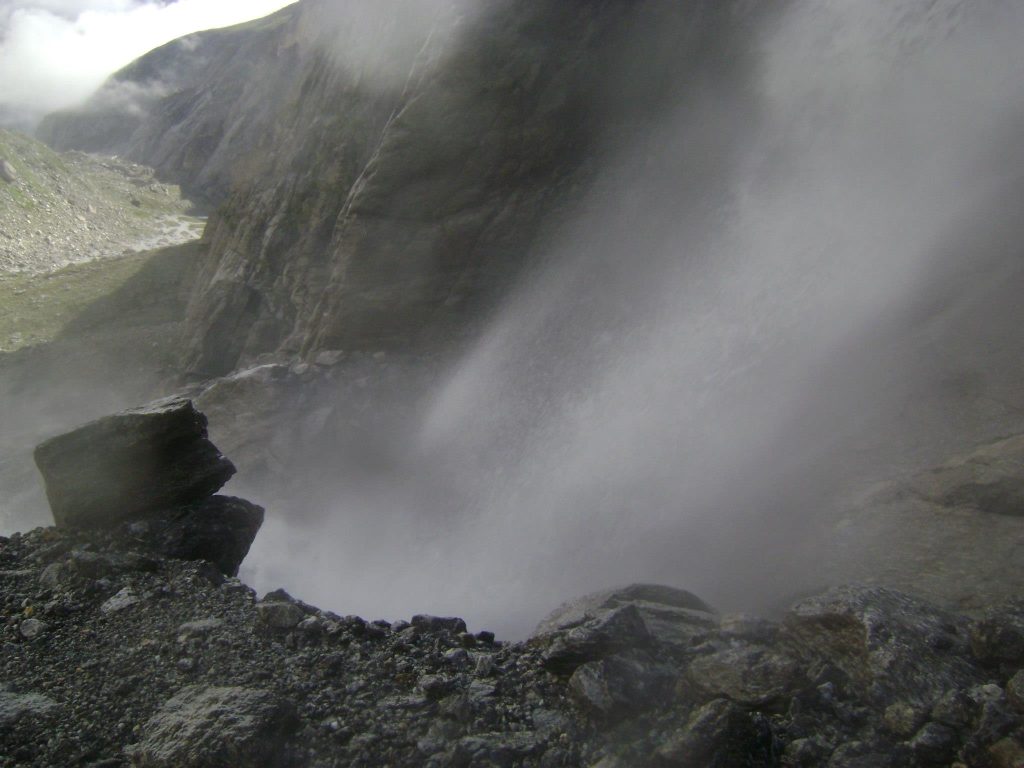
I woke up to a beautiful view. A light mist covered the place and the sound of the waterfall was so soothing I wish I could sleep again with this melodious and restless sound of Vasudhara Waterfall.
But the schedule was something else. I was told that a trek to Lakshmi Van was scheduled. I heard folklore that five holy places or Tirthas came here to meditate. The five Tirthas were Pushkar, Bodh Gaya, Prakash, Naimish, and Kurukshetra.
The amazing grassland of Lakshmi Van inhibits the local tribe which maintains the ecosystem by letting their cattle gaze here at Lakshmi Van. After a short break to eat my packed lunch provided by JustWravel, which to my surprise was utterly delicious and lip-smacking I started walking again towards the Chakrateerth Meadow.
The Chakrateerth Meadow or Chakrateerth Grasslands are green fields surrounded by mountains and hills on the sides. The plan was to camp at Chakrateerth for the night. I had a mystic and amazing experience sitting around the bonfire with the trekking group singing songs and sharing some horror stories and our experiences.
Suddenly a thunderous sound made me jump and then to my comfort I was told that this sound is of the Sahastra Dhara’s glacial ice breaking. I spent the night at Chakrateerth, although it was a bit cold, it seemed worth tolerating a bit cold for this million-dollar experience.
After a cold night, I woke up to steaming hot tea and breakfast which best suited the chilly morning. The view at 6:00 A.M. left me awestruck and astonished, the high peaks immersed in the mist was fascinating.
After having breakfast, the group started trekking again. Today was the day that I was the most excited about because today I would witness the magical and charming Satopanth Lake. We started trekking at 8:00 hours in the morning and walked almost 13 kilometers.
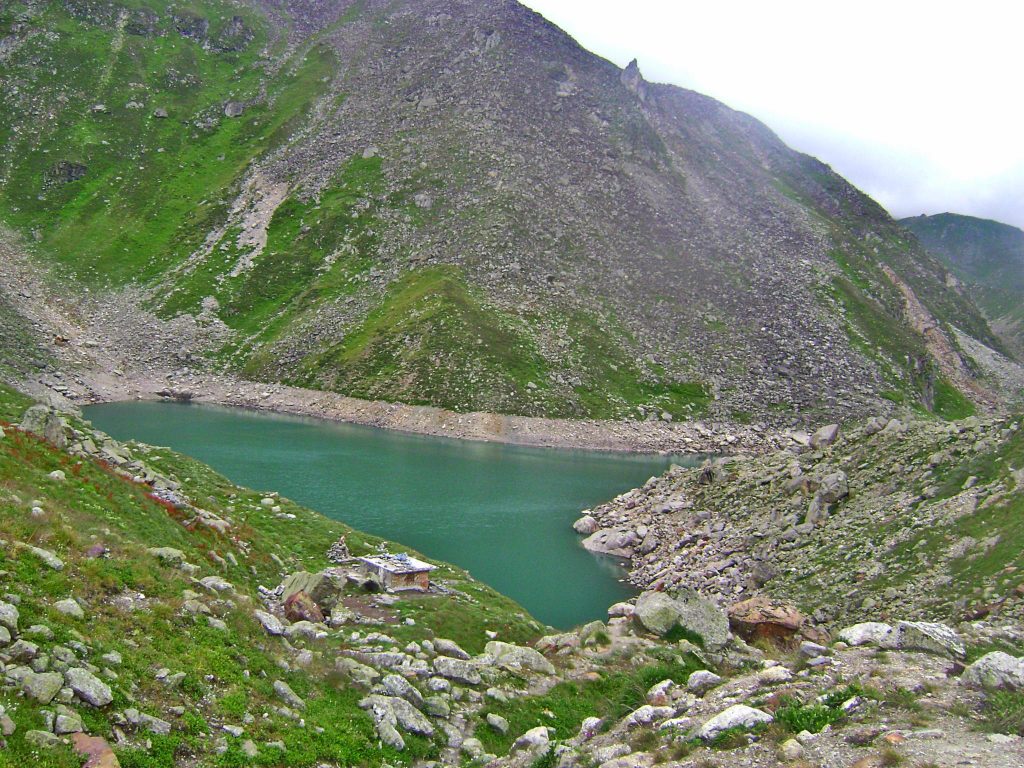
After harsh and tough thirteen kilometers my feet felt utmost tired but when I saw the Satopanth Lake at first glance, I felt like, “this magnificent view is worth the 6 hours long walk.” I was cherished and frolic, all my tiredness was far gone now. My guide told me that, this Lake carries some religious attachment to it.
According to the local blokes here, they throw the cremation ashes of their departed ones here, and hence they find peace, and why won’t they find peace? Satopanth is a calm and peaceful lake. “The silence here is hallucinating, at an arm’s distance from mother nature”, I said to myself.
The length of this nature’s marvel is 427 meters, and it engulfs peaceful Tridevs (a group of Hindu mythological Gods – Brahma the creator, Vishnu the Preserver, and Mahesh the destroyer). Another local I met by the lake told me that Gandharvas or husbands of the Apsaras (Dancers which performed in the heaven) preserve this lake from adulteration and infiltration.
After having my delicious and steaming hot stuffed paranthas and savoring puri sabzi, I descended from the lake towards the Lakshmi Van and spent the night there.
After a good and sound night’s sleep at the Lakshmi Van, my morning felt very spiritual and positivity flowed through my body. Truly speaking, this trek helped me uplift my spiritual self and made me happy on the inside.
Now I was ready to trek my way back down to the Mana village – the village made by Indo-Mongolian tribe centuries ago. From Mana, the vehicle picked us and dropped back to Badrinath, and then I paid my respects to the Badrinath Dham or Lord Shiva’s Temple. After a tiring day of trekking and a not so smooth drive, I was tired and slept early.
The next morning, I woke up and felt like a sweet dream was about to end. Yes, the time was to go back to Rishikesh and then to Delhi and get stuck up in the corporate life forever. By 17:00 hours, I reached Rishikesh on the last day of Satopanth Lake trek Itinerary, and right now at 23:00 hours, I am signing off my Journal. What a wonderful trip it was, worth the money spent, worth the kilometers walked, worth the cold, worth the runny nose.
I will definitely tell my friends to give this beautiful place a visit, The Satopanth Lake and do so with the people at JustWravel , their love and support for their clients is unconditional and will leave you speechless.
You can also read :
- 7 Reasons to do Har ki Dun Trek
- Treks to do around Bangalore
- Brahmatal Trek
Web Stories
Leave a comment, subscribe newsletter.
Shubham Vyas
Latest Blogs

34/1, Fourth Floor, Tower B, The Corenthum, Block A, Sector 62, Noida, Uttar Pradesh 201301
+91-8810 457 631
© 2015-2024 JustWravel Pvt. Ltd.

34/1, Fourth Floor, Tower B, The Corenthum, Block A, Industrial Area, Sector 62, Noida, Uttar Pradesh 201301
Group Tours
Customized Trips
- Valley of Flowers Trek
- Satopanth Lake Trek
- Kuari Pass Trek
- Chopta Chandrashila Deoriyatal Trek
- Explore Badrinath Dham
- NAG TIBBA TREK
- Panch Kedar Trek
- Kagbhusandi Lake Trek
- Chanap Valley Trek
- Swiss Tents
- Trek Stories
Satopanth Tal – Swargarohini Trek
By prof elango surendran.
Satopanth Tal is located in the midst of snow-capped peaks at an altitude 15,000 feet above sea level. One has to trek 22 km from mana village to reach the lake. The lake remains under the snow from the end of October to the middle of May or sometimes till end of June. The normal summer temperature remains around 12 °C in day and −5 °C in night, while the winter temperature may drop to even −25 °C in day and −36 °C in night. This is the only trek route in Himalayas where trekkers are allowed to walk 22 km in the interior Himalayan range near the Indo- Tibetan border.
According to Hindu mythology, it is believed that TriDev – the creator, the preserver & the destroyer eternally exist at the three edges of this triangular lake. Also there is another belief that Gandharvas guard this lake against evils. So no wonder this trek will give everyone a special feel and exciting experience. This trek is very special because the path touches the base of mount Neelkanth and mount Parvati on the way to the lake. Also while resting in the lake, one can visualize 360 degree panoramic view of Chaukhamba, Satopanth, Neelkanth and Parvati Peaks which makes this trek one of the best in Himalayas.
Ever since we returned from our last year Badrinath trip, We had been thinking about carrying out Swargarohini-Satopanth Tal Yatra this year. The path used by Pandavas to reach Swarga(heaven) for the salvation of their sins. Luckily for us, our last year Vasuki Tal trek leader Santosh along with his friend Vinit had started an organization named “ Himalayan Trek n Tour ” in Badrinath and operating treks in Uttarakhand. When we approached them with our aspiration for undertaking Satopanth Yatra, Santosh had charted out a five days-trek plan which included four nights stay in tents in high altitude. We agreed with his plan and asked him to make arrangements for carrying out the trek from Monday to Friday during last week of September 2017. Also we insisted him to accompany us during this spiritual Yatra.
Surprisingly, six members of our VTC had showed interest to join the trek. We all reached Badrinath on Sunday with some land slide issues on the way due to heavy rain earlier. Our cab was stopped near a hydro electric power station in Govindghat by Police vehicles and we had to trek a short distance of one hour to bypass the land slide zone. Santosh came on the other way to receive us and picked us in another cab. He explained about our trek plan and told that he had arranged a team of eight supporting members for helping us, which included a lead (himself), a chef and six porters with all emergency evacuation measures.
According to the epic Mahabharata, Satopanth Tal lies on the mythical route used by the Pandavas during their Swargarohini Yatra. At the starting point at Mana, 3 km away from Badrinath, lies Bheem Pul which is a natural rock bridge. Here, Bheem is believed to have made the bridge over the river Saraswati for Draupadi to cross the river during their yatra to heaven.
On Day 1 , Our team along with our lead Santosh reached the Army camp near Mana Village(10000 ft) by cab and started a brisk walk on the left side of Alakananda River banks. Initial one hour trek was a gentle meadow walk without any difficulty and then we reached a point where all our mobile phone signals had stopped. We got a feel as if we were disconnected from the whole family and the entire world. After walking for nearly two hours we sighted Vasudhara water falls on the other side of the river banks. By this time we gained 1000 feet elevation and enjoyed the view of Alakananda running in a gorge. Around 1 pm, we sat near a glacier stream and finished our packed lunch of Stuffed Parotta. Santosh had worked out a wonderful food arrangements for all days of our trek. We rested in that place for nearly half an hour and continued our trek. Around 3.30 PM we reached a beautiful plain grass covered region called Laxmivan (12000 ft) and by that time support team had already pitched the tents for us.
The place was calm and still. It was amazing to watch a glacier in front of us melting its water into Alakananda river. We had ginger tea followed by cup of hot soup to acclimatize the evening cool climate. By 7.00 PM we switched on tent lights and Chef along with our lead served us hot Sambar rice with curry and Pappads. That was more than enough to fall asleep in the tents. Inside the tents I was not feeling that much comfortable with the heavy sleeping bags and we all slept early on the first day. But around 2.00 AM in the mid night I woke up and was not able to continue my sleep. My tent mate another professor was also awake and was telling me that he was also not at ease inside the tent. Then we somehow managed to sleep with disturbance and by 6 am support team gave us wake up-black coffee. We were very happy to come out and to get the warmth feel of sunlight in the morning. I was not having any appetite and explained my discomfort to the Lead Santosh.
On day 2 , we started our trek around 8 am and planned for 8 kms stretch walk to reach a resting place called Chakratheerth. Since I didn’t eat well in the morning, I felt very weak during this trek period and was not enjoying like the previous day. I understood that my lack of sleep the day before was due to anxiety and home-sickness. We halted near a water stream at the beginning of Sahasdhara water cascade for our early lunch and I took Digene tablets along with the lunch. I explained the lead that I might not be able to walk till Chakratheerth. Adding to the trouble my shoe’s sole got torn open and we were not having any adhesive to paste it. I told the lead if such issues continue I would rather prefer to return to mana the next day. Santhosh and my team members were shocked to hear such words from me. The lead convinced me that he had oxygen cylinders and evacuation team with him and comforted me not to worry about fatigue and distress. Then somehow we reached the end of Sahasdhara water cascade and pitched our tents around 3.00 PM. Lying on the ground, I was staring deep into the sky. The most worrying factor to me then was missing my family without any calls & messages.
Some old Baba’s were passing by our tents, asking us why we were all resting by 3.00 PM and were insisting us to continue for another 4 hours trek to reach the lake where we would get divine blessings of the eternal Tridev. Suddenly I felt a flash change in my mind and from then onwards I started to focus my thinking about only reaching the destination. My mindset changed then from withdrawing the yatra to carrying blessings from the divine trinity lake to my kith & kin. I told myself then: All is well. A simple psychology that I learnt from this experience, is that with your whole thoughts anchoring on the source you could no way reach your destination. With that zeal I managed to sleep that night for six hours.
On day 3 , we woke up early in the morning and started a fresh uphill trek by 6.30 am with packed Breakfast. The lead explained about climbing high altitude with ease. I was feeling very much comfortable to climb from 12000 feet to 15000 when few in my team complained about having mild headache and breathing difficulty. The lead was comforting all of us. He was helping me to tie my shoe sole bottom with plastic threads. On the way we sighted Himalayan tiny rabbits called “Pikas” and clicked some shots. We reached the base of Neelkanth glacier then and offered prayers. We crossed its glacier stream after taking a few snaps. The ambience near Neelkanth base was breathtaking and one gets the heart fulfillment while standing there. From there we reached Chakratheerth and took our breakfast around 9.00 AM.
Chakaratheerth is another resting place during uphill trek to Satopanth Tal. It lies at an altitude of 14000 feet and looks like a huge football ground surrounded by beautiful small stream of frozen water. It is believed that Vishnu rested his chakra here and hence named Chakratheerth. Bhima tires and falls down. He asks his elder brother why he is unable to complete the journey to heaven. Yudhishthira explains his brother’s vice of greediness for food. At Bhimbar, the rock pillar reminds Bhima’s exit from mortal life.
After finishing our breakfast, we climbed a steep ascend of 500 feet high ridge for nearly 1 hour and we reached the top of the ridge where there was a flag post indicating our penultimate destination. We rested at the top for 15 minutes and took photos in plenty. One side of the ridge falls in to the gorge of glacier crevasses and the other side of the ridge touches the base of mount Parvathi. We saw little birds in plenty here and took photos.
Next came the challenging task for us: walking on boulders and small rocks lying over glacier crevasses. We tried our maximum to negotiate with crevasses and the lead told more alarmingly that we were crossing the land slide zone. It took nearly 2 hours for us to complete this difficult stretch. My torn shoes cooperated with me very well. I along with two others reached another ridge with a flag post indicating that we had reached our ultimate destination. The lake appeared in front of us in all its sheer beauty and serenity. At last, we finally reached the triangular lake and rested in our tents in front of a Tridev stone temple. Our souls experienced triumphant excitations and celestial vibrations on reaching our destination!
After a short rest, I and another trek mate again continued to climb up and reached the Swargarohini view point. We took shots in plenty and enjoyed the amazing glacier panoramic view from there. We came down to the lake and waited for others to reach the camp. After nearly 2 hours, others reached the lake with the support of our lead Santosh. We had hot Ginger tea, Hot soup and hot gruel with pappads. We sat near the camp fire for nearly two hours and relaxed. We went to bed late by 9.00 PM. We slept and woke up by the thunderous sound of glacier fall once in a while. All members missed their slumber not only because of the crashing sound of breaking glaciers, also because of less oxygen as well as sub zero temperature at that altitude of above 15300 feet.
Satopanth Tal is a triangular lake, located at an altitude of 15300 feet amidst snow clad mountains. From here Swargarohini view is rather amazing. Trekkers with sleeping bags use caves as shelter in Satopanth Tal. There are plenty of caves found in all resting places.
Yudhishthira and the dog continue their journey to Swargarohini. Indra appears with his chariot, suggesting him to enter the chariot alone. Yudhishthira refuses to go into the chariot, explaining he cannot abandon the dog who is his companion. The dog, watching Yudhishthira’s commitment for his friend, transforms as deity. The deity Dharma then praises Yudhishthira for his virtues. Yudhishthira enters heaven in his mortal form on Indra’s chariot at Swargarohini.
On day 4 , we offered prayers in the lake, finished our breakfast and started our downhill trek back to Mana. We crossed the danger land slide zone by hopping over the boulders and moving rocks. Climbing down was much easier for all that we reached Charatheertha around 1 pm and had lunch there. During the return trek we saw all water cascades near Sahasradhara overflowing with huge flow of water. After trekking nearly for 11 kms we had reached our camp site near Bhimbar. The support team had arranged plenty of woods for the night camp fire. Basking near the fire we finished our soup and last supper! We rested near fire till 10 pm and enjoyed old Hindi songs played in mobile phones. Then we had a good sleep in the tents.
On day 5 , we woke up by 6 am with hot black coffee and we thought of crossing the Alakanantha river near laxmivan. Later we dropped the idea, since the river was flowing 4 feet high with huge current. We reached the same glacier stream in front of Vasudhara falls around 1 pm and had our lunch. Then we walked towards mana village and santhosh, moving at the front told me that there was mobile signal. Eureka, I made the first call to my family and delighted to hear the breaking voice of my wife as well as my daughters. Then we reached mana by 3 pm. We all cheered each other on reaching mana village and boarded a cab to Badrinath hotel. At the end, we all felt so excited that we did complete a difficult and memorable mighty Himalayan trek. We offered prayers and thanks to lord Vishnu at Badrinath chanting Jai-Badrivishal. With memories in the heart, blessings in the soul and frost bytes in the lips as well as in the palms we returned home after two days of hectic travel.
Journey to the Sacred: The Satopanth Tal Trek in the Garhwal Himalayas
The Satopanth Tal Trek is a soul-stirring pilgrimage into the sacred landscapes of the Garhwal Himalayas, where pristine glacial lakes, towering peaks, and spiritual legends converge. Nestled in Uttarakhand, India, this trek commences from the pilgrimage town of Badrinath and unfolds as a journey through rugged terrains and high-altitude wonders.
The trail winds through enchanting forests, revealing the majestic Neelkanth Peak and the mystical Mana village, considered the last inhabited village on the Indo-Tibetan border. As trekkers ascend, the landscapes transform into vast meadows adorned with vibrant wildflowers, leading to the pristine Satopanth Tal at an elevation of around 4,402 meters.
Satopanth Tal, believed to be the abode of the Trimurti—Brahma, Vishnu, and Shiva, is surrounded by towering peaks, including Chaukhamba and Neelkanth. The crystal-clear waters mirror the Himalayan grandeur, creating a serene ambiance that invites introspection and spiritual connection.
The Satopanth Tal Trek is not just a physical challenge; it’s a cultural and spiritual odyssey. Trekkers encounter ancient temples, witness the sacred confluence of three rivers, and immerse themselves in the timeless myths of the region. The trek stands as a pilgrimage for those seeking a blend of adventure, spirituality, and the pristine beauty of Uttarakhand’s high-altitude landscapes.
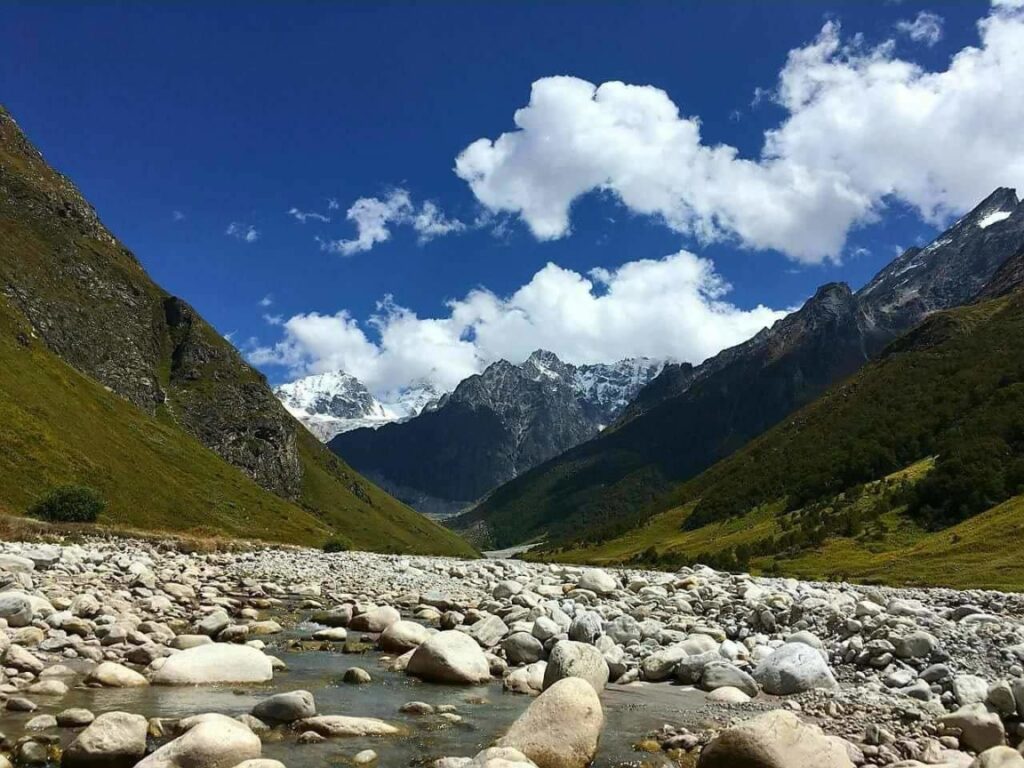
Upcoming Treks to Satopanth Tal
Beat the Heat - with the best summer destinations in Uttarakhand : Chopta - Nainital - Mussoorie - Kanatal - Dhanaulti - Chakrata - Auli - Kausani - Mukteshwar - Chaukori - Pangot
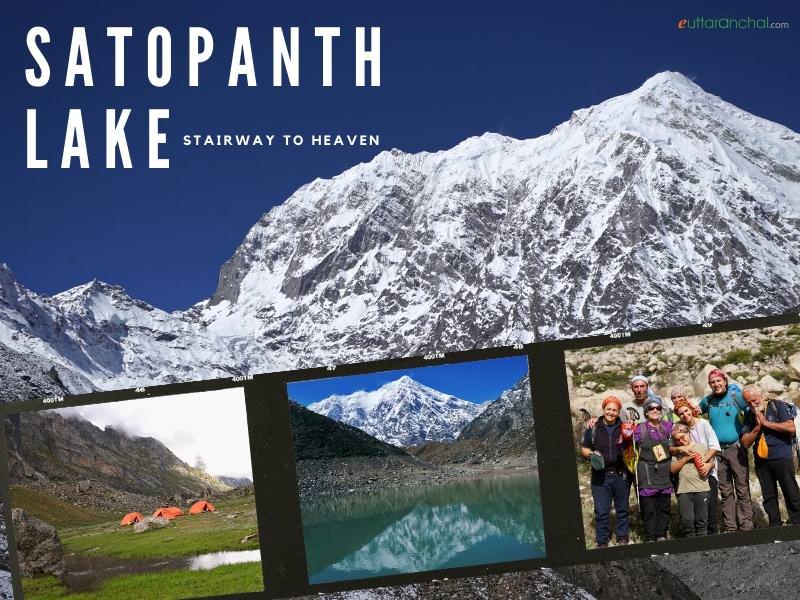
- Satopanth Trek
- Uttarakhand
- Uttarakhand Tourism
- 2 Tour Packages
- Send Enquiry
Satopanth - Glacial Lake of Divinity
Satopanth Tal is a crystal clear green water, the triangular lake at an elevation of 4600 meters above sea level and is adorned in the midst of the snow-shrouded peaks. Satopanth Tal is a high altitude lake located in Chamoli district of Uttarakhand and near to Badrinath Shrine .
Apart from religious significance Satopanth also become one of the Popular treks in Uttarakhand . This glacier trek offers majestic views of Himalayas.
Get Satopanth Lake Trekking Guide, Trek Updates, Satopanth Travel Tips
- Satopanth Trek Tour Packages
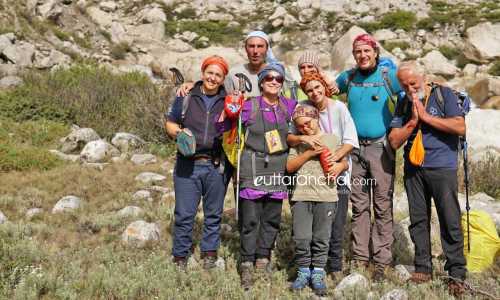
- Tour Packages
- How to Reach
Why you should gear yourself up for the venerated Satopanth trek?
The pea-green Satopanth Lake is celebrated for its holiness and mysticism which tempts many avid travellers to gear up for commencing the Satopanth Tal trek. The virgin trail leading to Satopanth can be easily accessed by crossing Lakshmi Van and Chakratirtha. This rewarding trek will offer you unobstructed view of the snow crested Chaukhamba and many other peaks. You will have euphoric spiritual as well as mental bliss while reaching at this lake.
The trail to the lake rewards trekkers with abundant natural beauty in the form of snow-clad peaks, verdant hills covered with pine and oak trees, gushing rivulets and streams.
Best Suggested Itinerary for Satopanth Trek
Day 01: Rishikesh - Badrinath Early morning catch the bus to Badrinath from Rishikesh and have lunch en-route. On reaching Badrinath , pay obeisance at the Badrinath temple and take the blessings of the deity. Check it at a hotel, have dinner and overnight stay.
Day 02: Badrinath - Lakshmi Van Post breakfast, check out from the hotel and commence a short 3 km trek to Mana (you can take local taxi as well), the last village of India on the Indo-Tibetan border. After getting your permits checked, make your advancement towards the Vasundhara Falls . After crossing the Saraswati temple from Mana, the gradient of the trek will become steeper. Walk-in harmony with the mighty Alakananda River, flowing below.
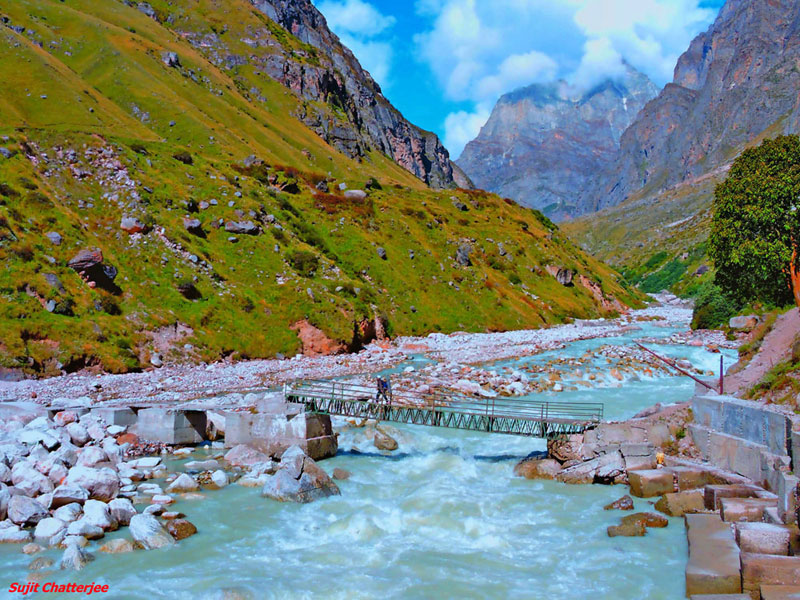
After a couple of hours, the surging sound of the water plunging from a height will suddenly hit your ears. On walking closer to the sound, the sight of Vasundhara Fall will come into your eyes. This cascading waterfall has medicinal properties and has been scientifically proved. Absorb the beauty of the waterfall and start treading through the thick birch forests of Laxmi Van. Walk 4 km further on the moraines and you’ll come across your campsite at Laxmi Van. Day 03: Lamxi Van - Chakratirtha Capture the beautiful sunrise view and gear up for today’s trek. This is a short yet scenic trek which will cross the Satopanth Valley. The well-marked trail is dotted with the green patches amidst the vast terminal moraines of Dhano Glacier.
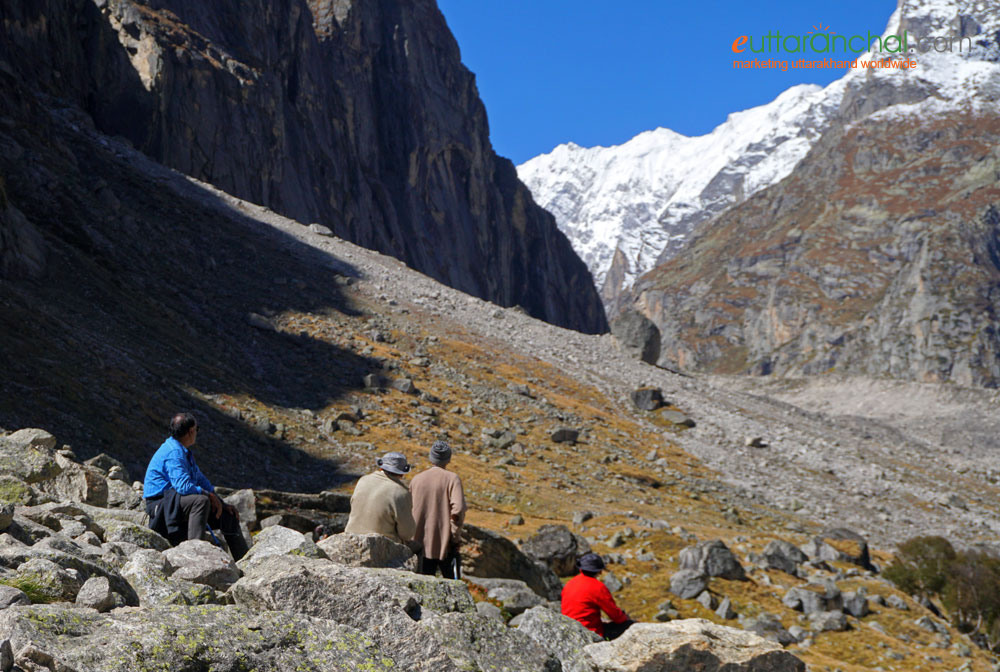
On the way, you can see the colourful alpine flowers blooming in the valley, after which the glorious view of the three benevolent peaks of Bhagirathi will first appear at the Satopanth Valley. Gradually climb the steep ridge of Sahastradhara to Chakratirtha camping grounds. On reaching the campsite, roll on the ground and gaze at the glaring west face of Mount Neelkanth.
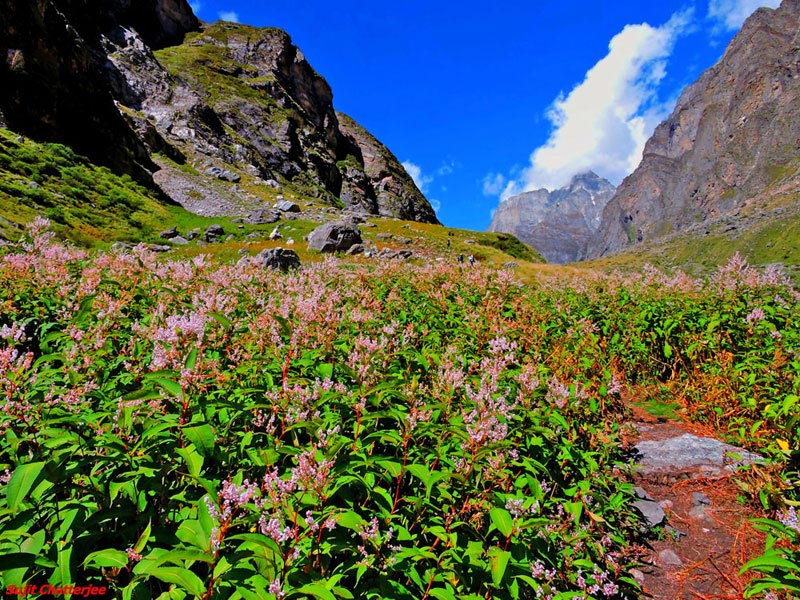
Day 04: Chakratirtha - Satopanth - Chakratirtha Unzip your tents early morning, to have a tempting view of Chaukhamba in the centre, Neelkanth , Satopanth and Parvati Peaks on your left and Balakun on your right. Sip a cup of tea, while getting drenched in the enigmatic aura of the colossal hills.
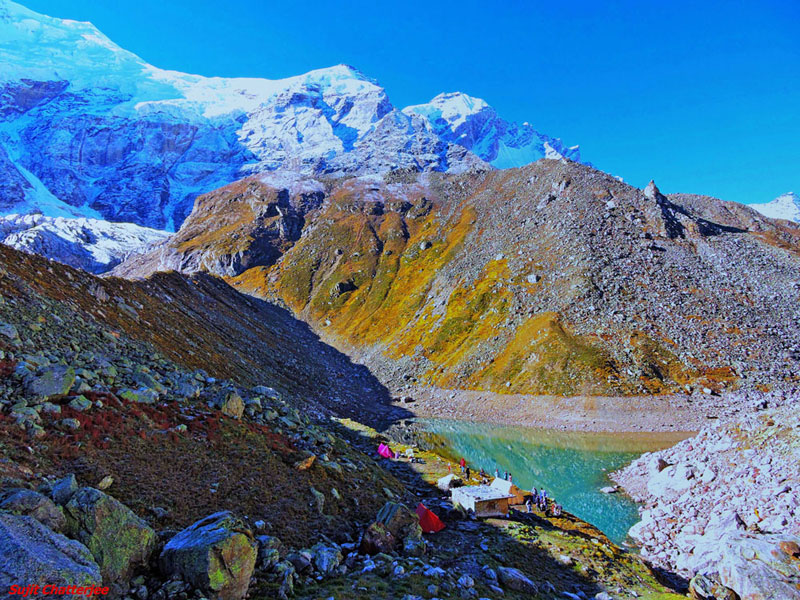
Now get ready to meander through the puzzling maze of boulders and moraines. You may also hear the perpetual tumbling sound of the avalanches throughout the valley. This is a tricky stretch so be patient while crossing it. In the last 2 km trek, you may have to deal with a couple of steep slopes and walk over the loose soil scattered over the glacial moraines. On reaching the top of the ridge, you will see the first sight of the triangular shaped, Satopanth Lake .
The breath-taking views from the emerald lake will sweep you off your feet. You can also see a saint known as Mauni Baba who resides near the lake and has stopped talking from a very long time. There is a common belief that he can live on only sun and air if food is unavailable. After spending some time here, start descending to Chakratirtha campsite. The 5 km return trek to Chakratirtha can be completed in a couple of hours.
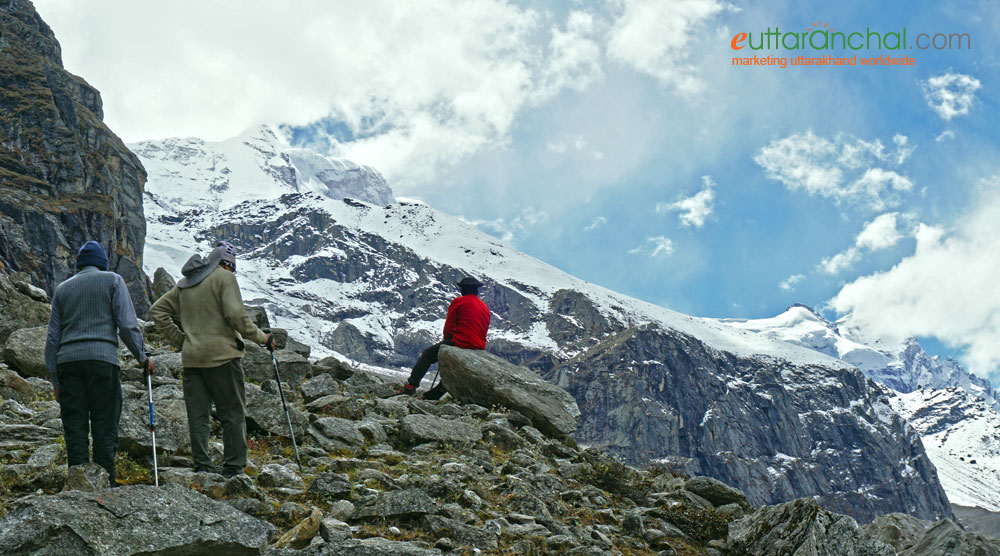
Day 05: Chakratirtha - Mana - Badrinath Wake up to the chirps of the playful birds, post breakfast pack your tent to start descending all the way down to Mana village . Follow the same trail that you took for reaching Chakratirtha from Mana. This 15 km trek can be completed in 5-6 hours. On reaching Mana, take the taxi ride to Badrinath , check in at a hotel and have an overnight stay there.
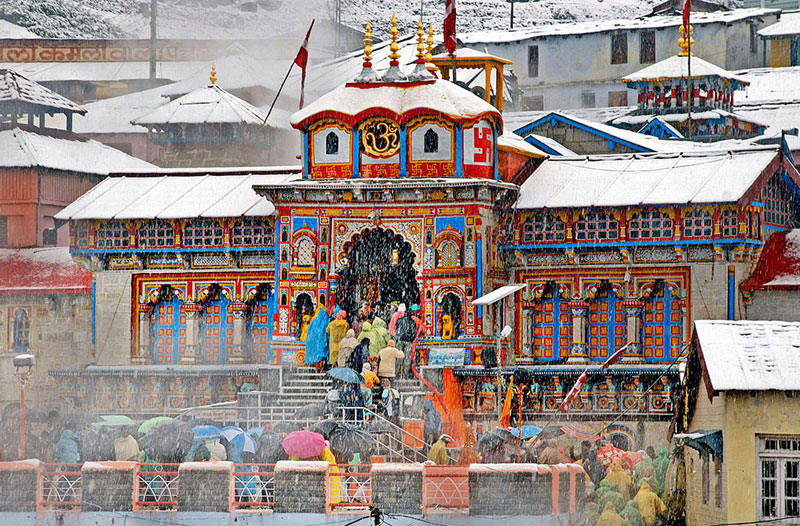
Day 06: Badrinath - Rishikesh After having a nutritious and healthy breakfast, check out from the hotel and leave for Rishikesh .
You can also check our tours of Satopanth : Budget Trek to Satopanth ex-Badrinath :: Satopanth ex-Haridwar/Joshimath Deluxe Trek
Satopanth Trek Travel Tips
- Trek to Satopanth Tal is moderately difficult and hence requires the trekkers to be physically fit. Cardio-vascular exercises like running, swimming could be practiced to improve stamina.
- It is recommended that to take the service of experience guide or trekking company for Satopanth Tal trek. You can also check Satopanth Tour packages from eUttaranchal as well.
- During the monsoons months (July-August), it is better to check with weather and road conditions with the local authorities and tour operators before travelling to the destination.
- Best time to visit Satopanth Tal is during the months of May, June, September and October. Nearest railhead is at Rishikesh while the nearest airport is situated at Dehradun.
- Obtain inner line permits from the Forest Department in Joshimath.
- The weather conditions and the gradient make the trek more difficult than it may appear.
- Last market is in Badrinath , do all preparations in Badrinath or Joshimath itself.
Mythology about Satopanth Trek
According to the Hindu legends amd Mythology, the Tridevas or the three devas, Brahma , Vishnu and Mahesha (Shiva) mediated on the corners of this lake. It is believed that during every Ekadashi the trinities take a holy dip in the water of Satopanth Lake. The Hindus believe that taking a bath in the Saptopanth Lake on the 11th day of the solar and lunar fortnights is considered to be auspicious.
Locals also believe that some special type of birds are found here, which pick up the pollutants of the lake and thus keeping the lake clean. These birds are not found anywhere else. The local belief is that they are the Gandharvas perdue, who guards the lake against evils.
The Hindus believe that Goddess Lakshmi and her husband Narayan indulged in a penance at Lakshmi Van and Chakratirtha.
There is an interesting story behind the indent created at Chakratirtha which states that Narayan once kept his Sudarshana Chakra on the valley and due to its weight the valley got its round shaped meadow surrounding the lofty mountains.
About Satopanth Lake
With its emerald blue-green crystal clear waters the triangular lake, having a perimeter of 1 km is situated at an astounding height of 4400-4600 meters (15100 feet). Satopanth Lake is 25 km from Badrinath shrine and about 4 km from Chakrateerth. This pristine lake is situated on the base of legendary Neelkantha Peak. The travelers can relish the stunning views of the glorious Balakun Peak, Kuber Top, Mt. Nilkantha and Mt. Swargarohini which are visible en route.
There is a saint known as Moni Baba , who hasn’t uttered a single word from years. There is a common belief that he can live on sun and air if food is not available.
What is Meaning of Satopanth?
Satopanth word is derived from two words – ‘ Sat-o ’ meaning of truth, and ‘ Panth ’ meaning path or way. So its literal meaning is the path of truth .
Satopanth Lake has three corner and each corner of Satopanth Lake is named after divine Trinity of Brahma, Vishnu, and Mahesh. The lake considered sacred by the local people of Mana village , which is base camp village for Satopanth Lake.
About Satopanth Glacier and Bhagirathi-Kharak Glacier
The Satopanth and Bhagirath Kharak glaciers are located at the head of Alaknanda Valley in Chamoli district of Uttarakhand. Both Satopanth glacier (13 m) and Bhagirath Kharak glacier (18.5 m) have an average width of 750-850 metres.
These glaciers sprawl over an area of 21.17 and 31.17 square km respectively. The eastern slopes of Chaukhamba group of peaks feed the ice to these glaciers. The towering peaks raging from 5,288 to 7,068 metres are snow-clad during winters.
These two glaciers are separated by a linear ridge. Both the glaciers have a sinuous course as their paths are obstructed by a number of spurs. The ablation zones of both the glaciers are covered by a thick layer of debris and their snouts are located at 3858 m and 3796 m above sea level.
The Alaknanda River originates from Satopanth glacier and meets Uttar Ganga upstream to Alkapuri. At Mana, Alaknanda meets Saraswati River and there onwards it drains in the Badrinath basin. The enchanting Vasudhara Fall is located on the route of these glaciers.
Satopanth is also known or written as Satopanth Lake, Satopant Tal, Sathopanth Tal, Sathopanth Lake trek, Satopanth Glacier trek. Sometimes it is also known as Satopanth - Swargarohini Trek .
Satopanth Trek Photo Gallery
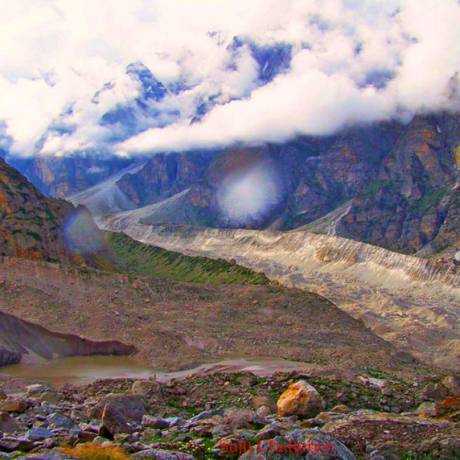
- Satopanth Trek Travel Guide
- Satopanth Trek Weather
- How to Reach Satopanth Trek
- Satopanth Trek FAQs
- Satopanth Trek Photos
What is Satopanth Trek famous for?
Satopanth Trek is famous among tourist as Trekking, High Altitude Lake, Mythological Importance, Camping, Glacier, Pilgrimage.
Satopanth Trek is recommended destination for Foreigners, Groups, Solo.
Satopanth Trek is popular destination for following activities/ interests - Adventure , Camping , Glaciers , Lakes , Pilgrimage , Trekking .
Plan your Trip
Satopanth trek highlights.
- Surreal high altitude green lake Satopanth
- Walk over a natural rock bridge, Bheem Pul near Mana Village
- Vasudhara waterfall during the trek
- Walk through the last village of India, ' Mana '
- Meet Moni Baba near the lake
- Cross many glaciers and valleys during the Satopanth trek
- Views of Himalayan peaks like Chaukhamba, Neelkanth and Swargarohini
- Satopanth Lake remains frozen during from October to May.
Uttarakhand Travel Update
Char Dham yatra will start from 10 May 2024, Bookings Now Open! Check Char Dham Tour Packages - Hotels in Badrinath - Char Dham Yatra by Helicopter - Kedarnath Helicopter Booking Guide
Char Dham Closing Dates: Gangotri , Yamunotri and Kedarnath dhams are closed now. Badrinath temple will be closed 19 Nov. Check out Char Dham Yatra tours : Char Dham News . Char Dham Registration is compulsory for visiting Char Dham Temples. Check Kedarnath Helicopter Ticket booking guide .
Traveling to Uttarakhand? Check out Uttarakhand Covid Stats , Uttarakhand Travel Guidelines and Uttarakhand Travel News
Char Dham Update: Gangotri , Yamunotri , Kedarnath and Badrinath are open for pilgrims. Check out Char Dham Yatra tours : Char Dham News . Char Dham Registration is compulsory for visiting Char Dham Temples. Check Kedarnath Helicopter Ticket booking guide .
Last Updated: 08 Apr 2024
Satopanth Trek overview
- Best time to visit Satopanth Trek May, Jun, Sep, Oct,
- Starts from Badrinath
- Trek Distance 22 kms
- Trek grade Moderate
- Trek duration 5 days
- Altitude range 4600 mts
- Located in Chamoli, Garhwal
- Famous for Trekking, High Altitude Lake, Mythological Importance, Camping, Glacier, Pilgrimage
Travelling to Satopanth Trek in 2024?
Contact us for planning your Satopanth Trek tour with best travel packages of as per your requirements!
- Sacred Yatra
- Char Dham Tours
- Chopta Tourism
eUttaranchal
- Uttarakhand Tour Packages
- Uttarakhand Hotels
Customer Service
- Return, Cancellation & Refund
- Privacy Policy
- Terms of Use
Business Connect
- List your Package
- List your Hotel
- Send Feedback
Get Customized Tour Package
Satopanth Swargarohini Trek: Garhwal Himalayas, Uttarakhand
About satopanth:.
The hypnotic beauty of the glacial lake of Satopanth , a little distance from the religious town of Badrinath in the Chamoli district of Uttarakhand beckons the trekkers with its irresistible charm. This emerald triangle-shaped lake, nestled in the middle of the towering Garhwal regions, provides an atmosphere of an utter tranquility. The lake is known to have a close correlation with the Hindu mythology, as it is thought that the three corners of the lake resembling a triangular shape are the divine part of the Holy Trinity: Brahma, Vishnu, and Maheshwar. Many pilgrims also walk down to the lake during sun and lunar eclipse weeks to bathe, since this is regarded the most sacred and wish-fulfilling.
Walking over boulders, moraines, glaciers, and ridges with razor-sharp edges, although risky, is captivating on the fabled lake trip path to Satopanth Tal at high altitude. The ever-changing panoramic views of the breathtaking summit vistas are a treat to the eyes. Above a staggering height of 14000 feet, this glacier lake is concealed inside the ridge known as "the road to truth" (Satya Ki Pantha). The Panch Pandavas with their wife Draupadi of the Mahabharata epic ascended to the heaven by following this arduous path commencing from Mana Village. Folklores still exist at numerous locations along the path. Along with the Neelkanth, Balakun, Parvati, and other peaks, the Chaukhamba ridge towers above this pristine lake. Brahma, Vishnu, and Maheshswar, according to legend, bathe in the lake on special occasions. During the monsoon, pilgrims including intrepid worshippers and Sadhus flock to this lake.
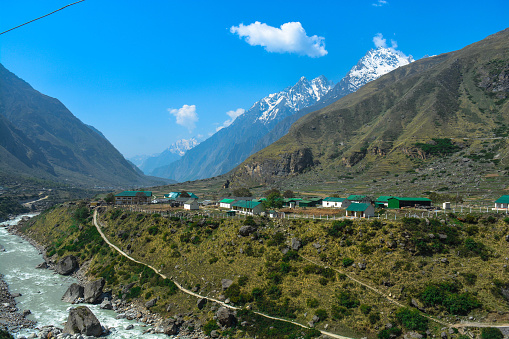
Other tales surrounding the lake have been passed down through generations as part of popular mythology. Some people think that a rare species of birds, known as Gandharvas from heaven, are said to frequent the beaches of SatopanthTaal. They came over to sift through the trash and filth, keeping the lake water clean from negative forces. If you inquire about the hamlet, you will hear additional legends about the terrain at Satopanth, such as how Lord Vishnu's Sudarshan Chakra produced the imprint at Chakrateertha, after which the village was named.
In this area, Swargarohini is not the only significant glacier. You will come across the magnificent Satopanth Glacier and the Bhagirath Kharak Glacier when you trudge higher along the holy river Alaknanda from Mana village. The snow from the Chaukhamba summits feeds both flowing streams of ice. The Chaukhamba Glacier, which rises to 7,068 metres and melts at 3,810 metres, has a 13-kilometer length and is the source of the Alaknanda River. The river subsequently joins the Uttar Ganga at Alkapuri, then the Saraswati at Mana, before entering into the Badrinath basin.
Also Check: Trekking in Uttarakhand: Land of Gods
Satopanth Lake begins at Mana Village, 3 kilometres from Badrinath, and includes BhimPul, a natural bridge made from rocks. The Satopanth Lake Trek is a little treacherous, but the risk is well worth it for the spectacular, bewitching scenery of the verdant landscapes and rugged snow-topped mountains. This trek will take you along some ethereal scenery namely, the BheemPul, Vasundhara Waterfall and the quaint Mana village.During the journey, you will feel blessed to hear the burbling sound ofVasundhara Falls, while enjoying exquisite views of Himalayan peaks such as Neelkanth, Chaukhamba, and Swargarohini.
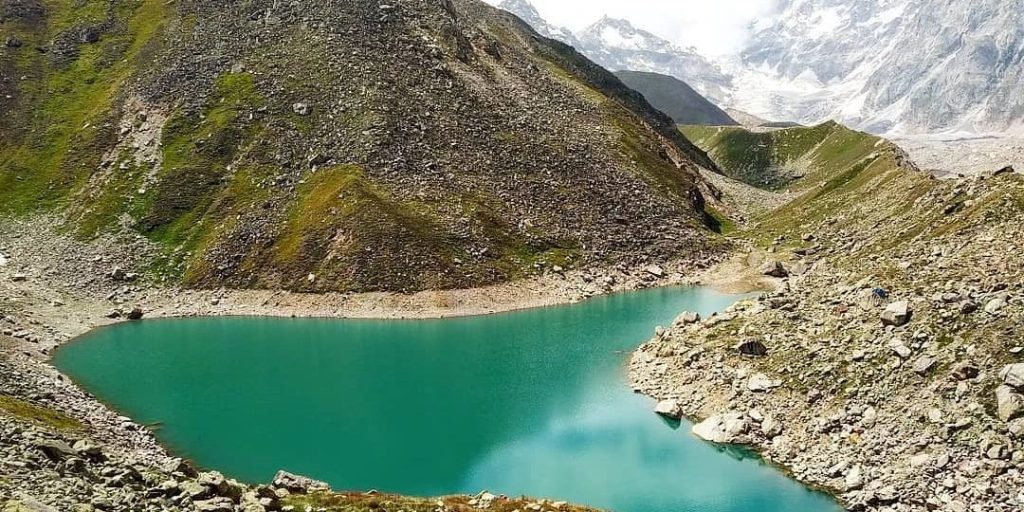
Also Check: Short Treks in Uttarakhand
BEST TIME TO VISIT SATHOPANTH LAKE TREK:
Pre-monsoon, summer months (may to mid juy):.
The snow-capped Mt. Chaukhamba, Mt. Neelkanth, and Mt. Swargarohini can all be seen clearly owing to the bright blue sky. The vista of the star-studded night sky is equally stunning. During the summer, trekkers may experience nature at its best, with gorgeous alpine wildflowers blossoming all around them. The pathways, winding up the Alaknandariver, manoeuver through thick wooded forests and scintillating meadows. One of the finest seasons to visit Satopanth Lake is during the summer. This incredibly beguiling lake has pure bluish-green waters in the summers. It is revered as sacred and is said to have miraculous properties. Its serene beauty also draws magnificent exotic species that are only seen in this vicinity during the summers.
It's one of the most enchanting summer treks in the Indian Himalayas. The weather remains favorable, with typical summer temperatures ranging from 13°C to 5°C during the day, falling to almost -5°C at night. Even so, adequate winter apparels should be brought because evenings may be rather freezing.
Post-monsoon, autumn months (mid September to October):
The trek to Satopanth is also best done in the post-monsoon season. Autumn displays yet another facet of this region's natural splendour. While the sky remains azure blue, trekkers may stumble upon paths covered with vibrant fall hues. This is the optimal time to immerse in the aesthetic delight of the Alaknanda River as it merges with the Vasundhara Falls.
With the start of snowfall bathing the landscape in a gentle blanket of white, Satopanth Taal entails a mesmeric charm in October. Temperatures range from 5 degrees Celsius during the day to -15 degrees Celsius at night, so it is bitterly cold out there. As a result, it is important to be well-prepared with thermal and thick woollen clothing and dress in layers.
The monsoon and the winters months are not at all recommended as navigation becomes challenging. In the monsoons, the road becomes very slippery and the winters bring about heavy snowfall blocking the roads. Dangerous avalanches are also quite frequent in these months.
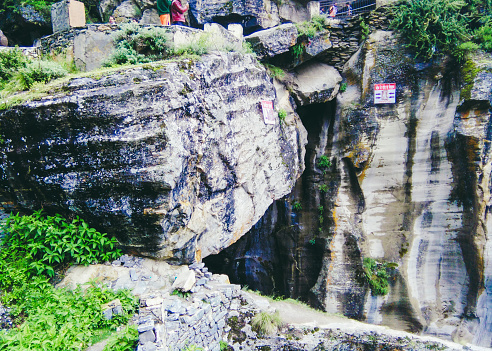
PERMIT TO GET TO SATHOPANTH:
To undertake the Sathopanth, Swargarohini trek, you will have to apply for an interline permit from Joshimath. You are supposed to receive your permission from the divisional forest office of Nanda Devi Biosphere Reserve situated in Joshimath. If you are willing to take a guide for this trek, acquiring a permit will be quite easy.
DIFFICULTY LEVEL OF THE SATHOPANTH TAAL TREK AND WHY?
This is not a trek for rookie trekkers. This trek is rated as a difficult and one of the most demanding one. One of the most difficult aspects of this trip is gaining elevation quickly. As you ascend, the oxygen level in the air drops. Severe respiratory complications are also a possibility.
Brace yourself for a rapid dip in temperature in elevated campsites, particularly at night. You'll have to ascend over 2500 feet in one day, and your body may take some time to adjust to the biting cold. Acclimatization often becomes challenging and so you should take adequate rest whenever you feel the need. At night, the temperature might drop to approximately -5 to -7 degrees Celsius. When you go to sleep, wrap yourself in warm clothing and cover every part of your body in woolen garments.
The Satopanth Taal walk involves a lot of steep climbs, and the most typical problem for trekkers is Acute Mountain Sickness. It generally occurs at high elevations as a result of a reduction in the body's oxygen level leading to hypoxia. AMS is similar to motion sickness in that it causes nausea and headache, but it can become hazardous if the initial symptoms are overlooked. As a precaution, it is recommended to descend to a lower altitude as soon as symptoms of AMS appear.
Trekkers must be in decent physical shape and capable of ascending 2000-2500 feet in a single day as the terrain is riddled with boulders, loose rocks, and moraines. It is necessary to remain fighting fit with prior trekking expertise. The final section of the trip, way to the top, is particularly difficult which has only loose moraine soil caused by melting glaciers.
DETAILED SATHOPANTH TREK ITINERARY
Day 1: rishikesh to badrinath – drive for 300 km.
On the first day, you will drive by road for approximately 11 hours from Rishikesh to Badrinath. Start early if you want to arrive on scheduled time and have some relaxation for the next day. Take the early bus or begin your journey by vehicle. Pay a visit to the shrine before supper and then retire for the evening to your accommodation.
Day 2: Badrinath to Lakshmi – Trekking for 5 hours
You may either trek to Mana Village from Badrinath or hire a taxi for 3 kilometres. From here, you'll begin your journey to SatopanthTaal. You'll be strolling along the Alaknanda River's left bank. After 3-4 kilometres, you will reach the majestic Vasundhara Falls. Continue trekking through the Falls' gushing waters to the Lakshmi Van campground tugged at a height of 11,900 feet, where you might pitch your tent for the night.
Day 3: Lakshm to Chakrateertha – Trekking for 4 hours
You will trek over the moraines of Dhano Glacier, passing through lush meadows. On the journey, focus on areas of vibrant wildflowers and sierra of the Bhagirathi peaks. You will reach Sahasradhara at the completion of the walk, known for its limestone stalactite monoliths.Beneath these incredible structures many river streams flow, earning it the name Sahasradhara. It signifies a "thousand-fold spring." On a clear day, one may see the massive Neelkanth range. The Chakrateertha campground is about a half-hour hike away from here.
Day 4: Chakrateertha to Satopanth and back – Trekking for 8 hours
This day's climb commences on a smooth level and easy incline before getting steeper and steeper as you approach the summit. Boulders and moraines dot all the way to the top, where you can see the immaculate lake for the first time. Prepare to be winder-struck with anunsurpassable view, with Neelkanth heaving in the backdrop, Swargarohini on your left, Chaukhamba directly ahead, and Balakun to your right. Return to Chakrateertha once you've finished photographing and enjoying the site.
Day 5: Chakrateertha to Badrinath via Mana, Trekking for 6 hours
Descend the very same trail to reach Mana village in around 6 hours. If you are too tired, as you will most likely to be, you may hire a taxi or jeep straight to Badrinath.
Day 6: Badrinath to Rishikesh
You can book a bus or a cab returning to Rishikesh on the last day of your tour to continue your journey back home. Before leaving Uttarakhand, you may buy up some necessities and pick up some gifts and talisman for friends back home at either Badrinath or Rishikesh.
Deals And Offer
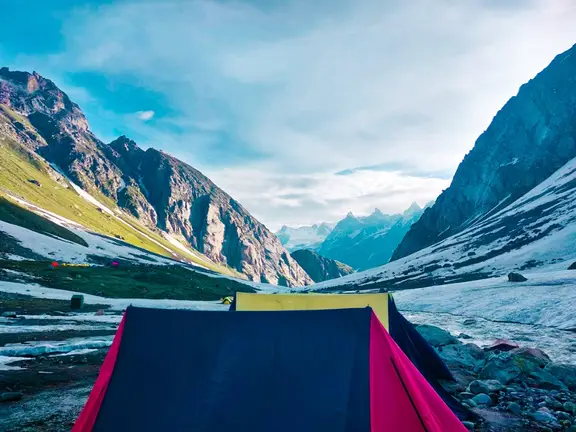
Hampta Pass Trek
4.87 ( 438 ), hampta pass trek 2024 - chandratal lake trek | moxtain, free cancellation till 30 days prior trek, rental & gear available on rent, book with 20% initial amount.
See Dates / Book Now
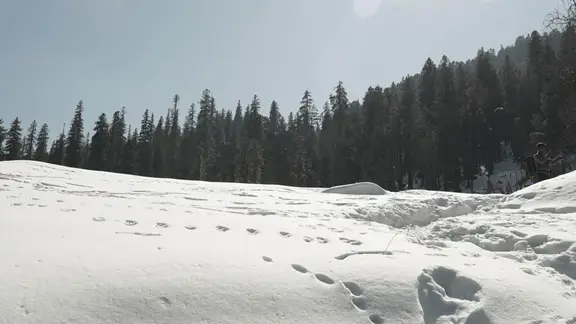
Dayara Bugyal Trek
4.85 ( 398 ), dayara bugyal trek 2024 - 6 days trek | moxtain.
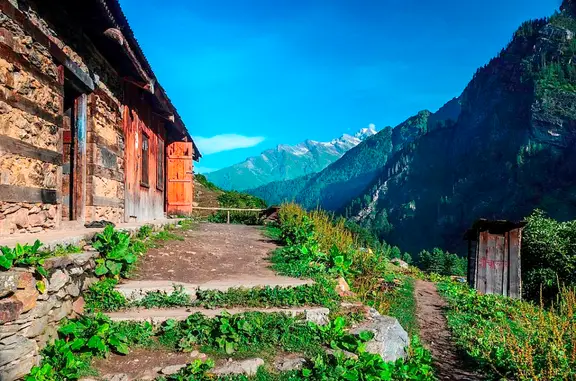
Kasol-Kheerganga-Tosh-Malana-Trek
4.56 ( 24 ), similar blogs.
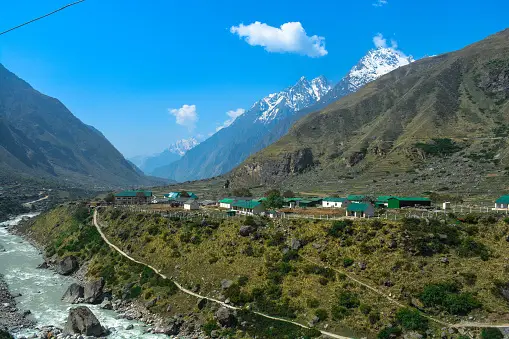
Complete trekking guide for Sikkim: Best treks in Sikkim
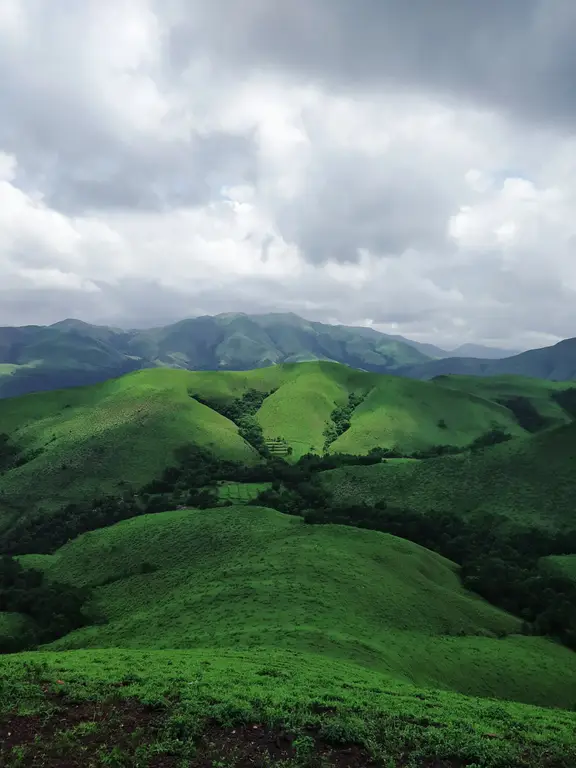
11 Best Monsoon treks in Maharashtra
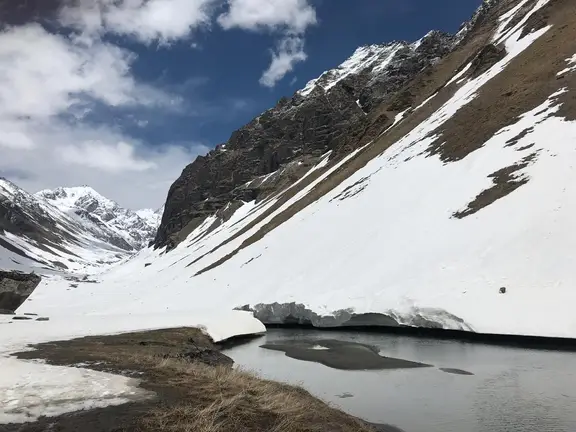
Bali Pass vs Har Ki Dun Trek
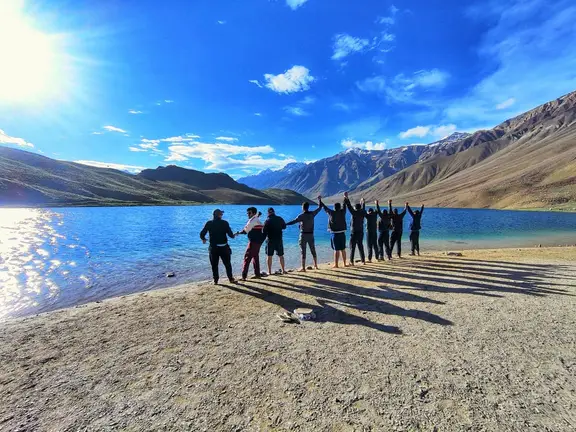
8 Best treks in Himachal Pradesh
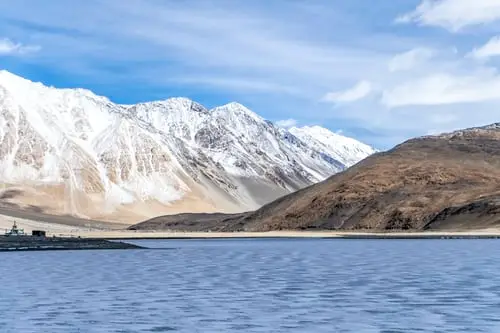
Trekking in Jammu Kashmir: 8 Best trekking trails and adventure activities
Similar trips, stok kangri, mayali pass, everest base camp trek, annapurna base camp trek, goechala trek, nag tibba trek, deoriatal chandrashila, bara bhangal, sandakphu phalut trek.
Satopanth Trek (Uttarakhand) – Complete Travel Guide
Brief about satopanth trek.
The Satopanth Tal trek is not only a spiritual experience but also offers breathtaking natural beauty. It’s a difficult trek that rewards you with a pristine glacier lake that’s nestled amidst the Garhwal Himalayas. The trek offers stunning views of the snow-covered Chaukhamba peak, Neelkanth peak, and Swargarohini peak. Along the way, you’ll also get to witness the Vasundhara Falls, which is a 400-ft tall waterfall, and Sahastradhara, which has over 100 waterfalls.
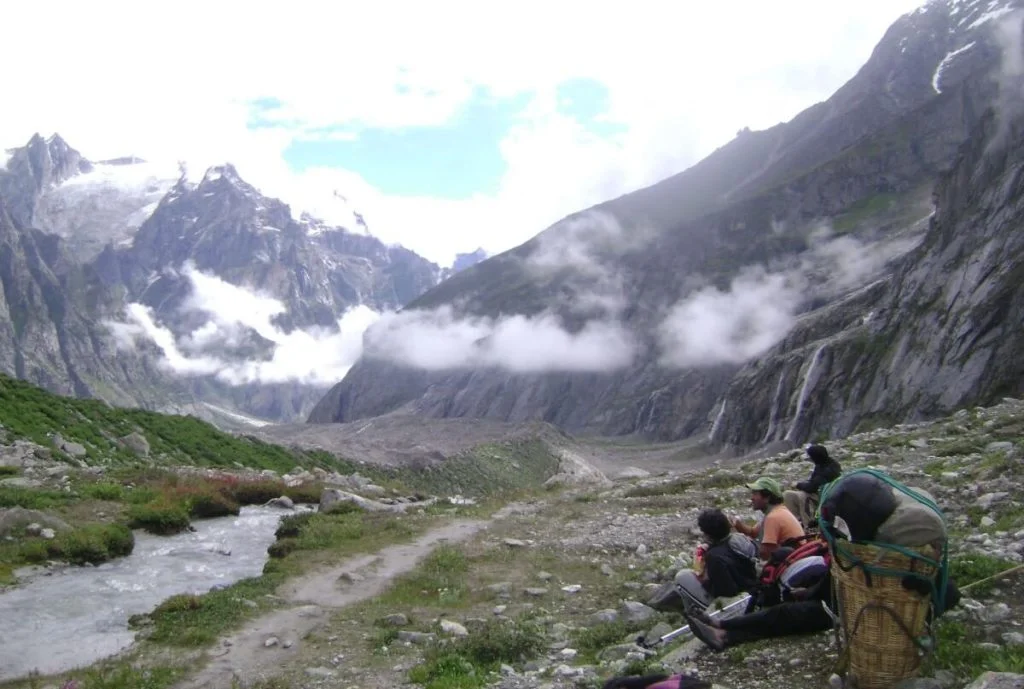
The Satopanth Trek is also an opportunity to explore the rich history and culture of the Garhwal region. You’ll get to visit the last village of India, Mana village, and witness ancient temples and historical sites. The trail takes you through thick forests, snow-covered trails, and beautiful meadows, making it a complete package for those seeking adventure, natural beauty, and spiritual fulfillment.
Key details of the Satopanth Trek :
- Ideal Number of Days for the Visit : 7 days and 6 nights
- Trek Distance : 50 km both ways
- Trek Altitude Range : 15,100 feet
- Starting Point: Joshimath
- Nearest Railway Station : Rishikesh Railway Station (300 km)
- Nearest Airport: Jolly Grant Airport, Dehradun (314 km)
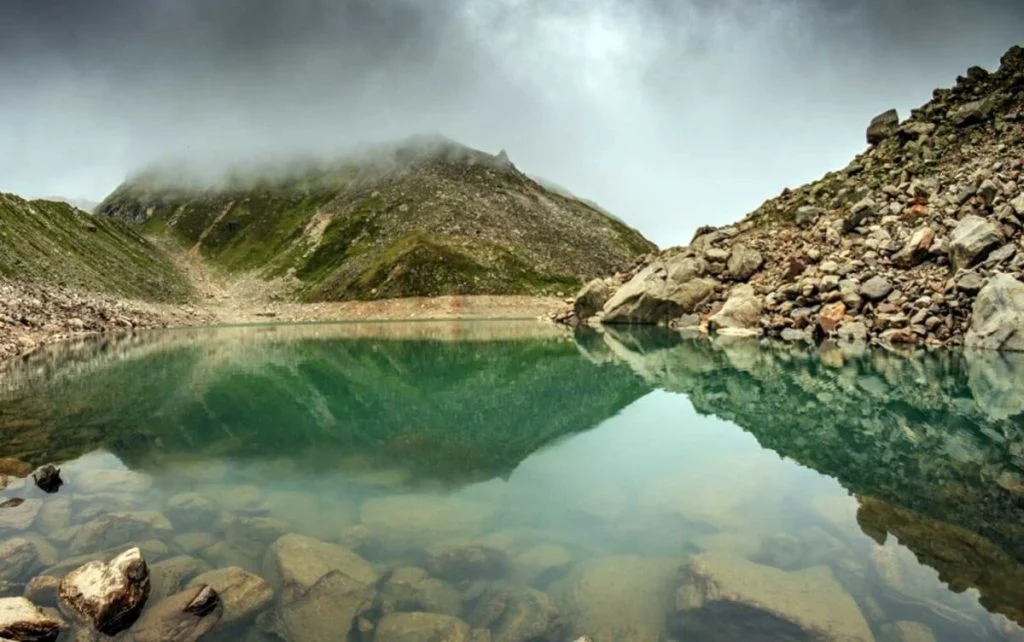
Table of Contents
Best places to visit during satopanth trek.
As you trek towards Satopanth Lake, you will be treated to a majestic view of Mount Neelkanth, the highest peak in the Garhwal division of the Himalayas. The mountain can be constantly seen once you cross the Lakshmi van forest region, provided the weather is clear.
Another attraction on the trail is the Vasundhara waterfall, located 3 km from Mana Village. The burbling sound of the falls will accompany you as you trek towards it, and the falls will be visible on your right side on the other bank of the Alaknanda river.
The Satopanth Lake is a crystal-clear, triangular lake surrounded by snow-capped mountains, including the famous Swargarohini, Chawkamba, Neelkanth and Balakun peaks. It remains clean throughout the year, and the lake’s evergreen color soothes the eyes.
If you’re up to visit a good nearby place, Pandukeshwar Temple, located between Joshimath and Badrinath is another great attraction. It is believed to be a sacred place where King Pandu, the father of the great Pandavas of Mahabharata, worshipped Lord Shiva.
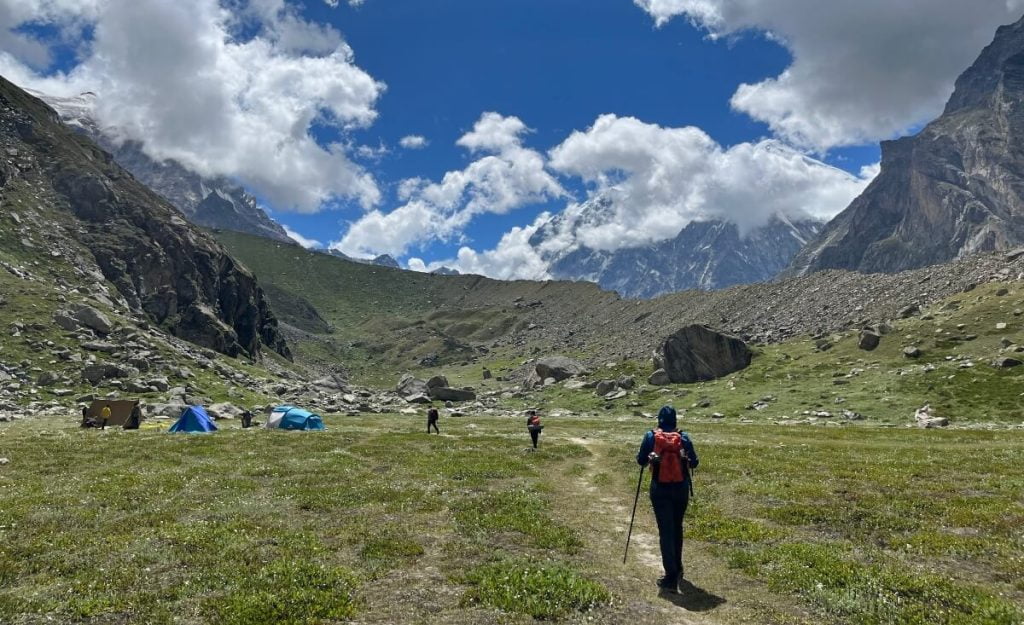
What is the best time to visit Satopanth Trek
The Satopanth Tal trek is best undertaken between May to mid-July and September to October. During May to mid-July, the trail is lush with green meadows and wildflowers. Post-monsoon, from September to October, offers the chance to see the Alaknanda river in full flow, along with the Vasundhara waterfalls.
Trekking during the winter season is not possible due to heavy snowfall, while monsoons make the trail dangerous. The best time to visit Satopanth Tal is during May, June, September, and October, with the nearest railhead at Rishikesh and the nearest airport in Dehradun.
How to reach the starting point of the trek?
To reach Satopanth Tal, you need to start your trek from Mana village, which is easily accessible from Haridwar/Rishikesh. If you are coming from cities like Bangalore, Chennai or Mumbai, it is recommended to fly directly to Dehradun and then take a shared taxi or bus to Rishikesh. From Rishikesh, take a bus to Badrinath and stay overnight there. The next day, you can either hire a cab to Mana or directly start the trek from Badrinath.
Alternatively, you can fly to Delhi and take a train or bus to Haridwar, and then follow the same route to Badrinath. It is important to reach Haridwar or Rishikesh by 6 pm and leave for Badrinath the next day at 3 am to reach there by 4 pm. You can then start the trek from Badrinath or hire a cab to Mana.
Availability of accommodations and food near the trek
Kukke Subrahmanya temple offers plenty of restaurants for an early breakfast before starting your trek, with popular choices like Neo Mysore Cafe and Hotel Kumarakripa opening as early as 5 AM. On the trek itself, Bhatta’s house is the only food source, so let Bhatta know when you arrive to ensure meals are prepared. It’s also a good idea to bring dry fruits, nuts, and non-perishable items like bread and peanut butter or rotis to keep you fueled throughout the two-day trek.
Before setting off, fill your water bottles at one of the temple restaurants, as your next opportunity for water will be at Bhatta’s house or the Forest Office. Carry at least two 1-liter water bottles and avoid filling them from small streams or stagnant sources along the trail, as they might not be safe to drink.
Accommodation:
You can book comfortable resorts and hotels in Joshimath to stay and get ready for the trek.
- Check Resorts & Hotels in Joshimath
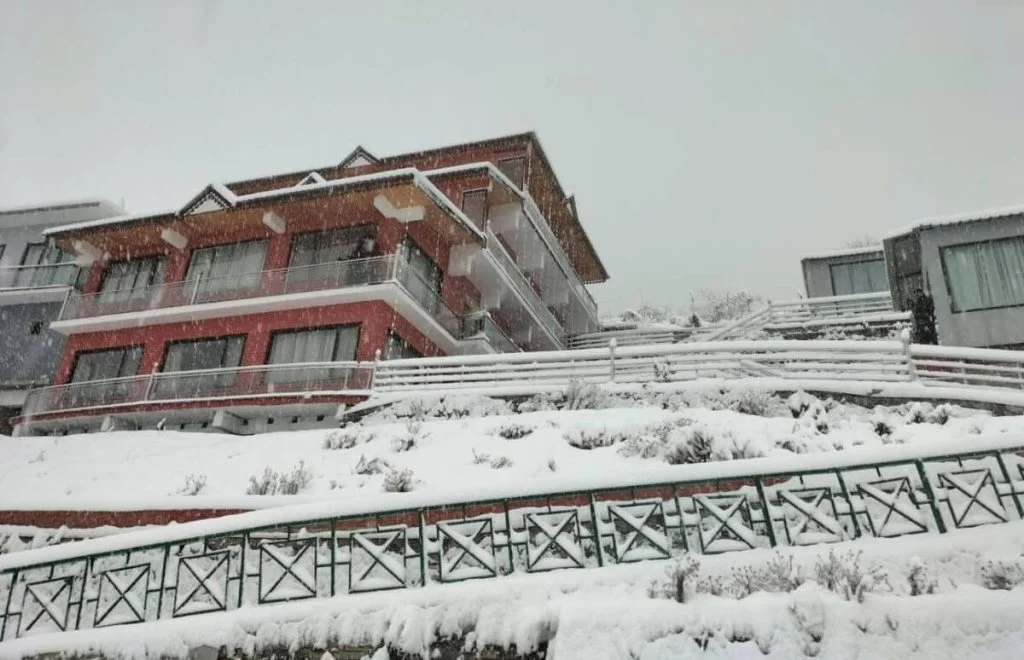
The Difficulty level of the Satopanth Trek
The Satopanth Tal trek is of moderate-difficult level and requires prior Himalayan trekking experience and high fitness level due to the steep sections on the trail, overall altitude gained, and total distance covered every day. The trail is through a maze of loose rocks, boulders and moraine, and has sections that are steep and need to be negotiated carefully.
The final stretch to Satopanth Tal is quite steep and has loose soil over the glacial moraine. A basic level of physical fitness is recommended, and it is suggested you increase your stamina by doing cardio-vascular exercises like running and swimming. Despite the difficulty, the beautiful view and the beautiful hills all around will continue to delight you.
Is Camping Allowed On Satopanth Trek ?
It is recommended to carry your camping equipment for Saropanth Trek. While shops in Badrinath provide camping equipment, the quality is not guaranteed. However, it is possible to rent utensils and other equipment from Badrinath.
Keep in mind that camping on alpine and sub-alpine meadows/grasslands, locally called “Bugyal” is not permitted due to a Uttarakhand High Court order. As a result, camping at Satopanth Tal is not allowed and the highest camp is at Chakratirtha from September 2018 onwards.
Is Any Permission Required For Satopanth Trek ?
You need to obtain an inner line permit from the Divisional Forest Office of Nanda Devi Biosphere Reserve in Joshimath. You can get permission by contacting them on 91-1389-222179. If you are hiring a guide, they will help you get the permit.
Nearby Destinations you may want to explore:
- Kedartal Trek in Uttarakhand – Full Travel Guide
- Tarsar Marsar Trek in Kashmir – Full Travel Guide
- 11 Most Amazing Places To Visit in Dalhousie
About The Author, Anant
Anant is a seasoned traveler and product professional, who is passionate about exploring new products, destinations and cultures. He captures all his experiences through his love of writing. Driven by a desire for adventure and knowledge, Anant is on a quest to see as much of the world as possible.
Related Posts

- Badrinath Yatra Package
- Valley of Flowers Trek Package
- Vaishno Devi by Helicopter
- Other Hotel
Sathopanth Tal is located at the height of 4600 m above sea level in the bosom of the snow-capped Himalayas. The lake is a triangular shape with its turquoise color glistening in full potential during summer and remain frozen throughout winters. Located in the Chamoli district of Uttarakhand near to Badrinath temple, the lake also carries a religious significance.
Main Highlight of Satopanth Trek
- Latitude – 30.7456N
- Longitude – 79.3437° E
- Altitude Range – 4600m (15,100ft)
- Best Time To Visit- May to July
Table of Content
- Why Saopanth Trek?
History of Satopanth Lake
- Itinerary for Satopanth Trek
- Best Time to do the Trek
- Things to Carry during the Trek
Why Satopanth Trek?
Satopanth Trek, a famous trek of Uttarakhand is not only known for its holiness and mysticism stories but also for the views that one comes across. The trail which stretches 50km presents some of the jaw-dropping views of the Himalayas . The journey begins from Badrinath, taking a trail that passes from Laxmi Van and Chakartirtha.
While going through the trek, one will be rewarded with – soul-soothing views of rivers originating from the Himalayas; snow-capped peaks of Mount Chaukhamba, Mount Neelkantha, Mount Balakun, and tranquility in the lap of nature.
According to the legends, the TriMurtis Brahma, Vishnu, and Shiva meditated on the corners of this triangular lake. And on the occasion of every Ekadashi, the trio takes the dip in the lake. It is believed that people who take a dip in the holy water of the Satopanth lake are absolved of all the sins.
Lakshmi Van and Chakratirth too have their share of stories. The story about indent in Chakratirtha states that Lord Vishnu once kept his Sudarshan chakra on the valley which causes an indentation due to the weight of the chakra and hence it got its round shape surrounding the mountains. Whereas Lakshmi Van is still believed to be the place where Goddess Lakshmi and her husband Lord Vishnu penanced.
How to Reach Satopanth Trek:
By Air – You can take a flight up to Jollygrant Airport. From there you can take a taxi till Rishikesh and again for Badrinath or directly from the airport to Badrinath. By Train – Board the train for Rishikesh and take a taxi/bus for Badrinath. By Road – Board bus or cab till Rishikesh and then directly for Badrinath and person with their own vehicle can directly go to Badrinath via Rishikesh.
Hotels in Badrinath:
- Sarovar Portico
- GMVN Tourist Rest House
- Narayan Palace
- Badri Ville Resort
- Jagirdar Guest House
Itinerary for Satopanth Trek:
1 st day: Rishikesh – Badrinath Route(approx. 301km)
Take the bus from Rishikesh for Badrinath and have lunch en route. It will take approx. 11-13 hours to reach Badrinath. On reaching Badrinath, Visit the shrine and take the blessing of the Lord. Check-in at the hotel, take a rest and rejuvenate yourself for the next day.

Figure 1- Badrinath
2 nd day: Badrinath – Lakshmi Van(Approx 9km)
Check out from the hotel and start your journey to the Mana village, the last village of India . You can take a local taxi for this or a short trek of about 3 km as per your requirement.

Figure 2- Laxmi Van Campsite
Get your permit verified( this inner line permit is necessary and you can get it from Joshimath). From Mana village, follow the trail on the left of the river Alaknanda. The properly built trail stretches about a few kilometers. Covering a few kilometers, your ear will be mesmerized by the sound of the water falling from graceful Waterfall Vasundhara . This waterfall is known for its medicinal properties which are scientifically proved. As you advanced the valley bifurcates into two, keep sticking to the left bank throughout the trek. Walk 3-4 km through moraines you will reach the Lakshmi Van campsite .

Figure 3- Vasundhara Fall
3 rd day: Lakshmi Van – Charkratirth(Approx. 7km)
The trail for the Chakratirtha will be slightly difficult as the elevation gain will be more than 1100 ft. Keep yourself hydrated during the entire trek and make sure you had a healthy breakfast. Taking the trail, along the Alaknanda river your trek will be on grassland amidst moraines of the Dhano glacier .
On the trail you will come across some of the beautiful alpine flowers, blooming in the valley that will spellbind you. As your cross this patch, you will get a glimpse of the 3 peaks of Bhagirathi if the weather is clear. Moving further a distance of a few 5-6 km you will reach Sahastradhara (the name called so because of hundreds of small waterfall plunging through the single rock) . On the left side rest Mount Neelkanth . Try to reach the Chakratirtha Camping site as soon as possible as afternoon the weather may change drastically. It’s a flat grassland where you can set your tent.
4 th day: Chakratirtha – Satopanth Tal – Chakratirtha
Be ready to be enchanted by the view the next day early morning with Balakun range on your right, Mount Neelkanth on left, and Mount Chaukanmba at the middle.

Figure 4- Satopanth Lake
The trek would be 10-11 km long and would be a difficult one. Initially, the trekking will be on a flat grassland. As you move further, you will meander through the boulders and moraines so try to be patient. On reaching the ridge top, you will the very first glimpse of Satopanth Lake. Near the lake, you will find a shelter made from stone, home to Saint Mauni Baba who has taken on silence for a long time. It is believed that he can survive on air and sun even if no food is available. Taking some rest from the tedious journey, you can start descending towards Chakratirtha campsite and reach within few hours.
5 th day: Chakratirth – Mana – Badrinath(Approx 15-16 km) Take the same trail to reach the Mana by crossing the Lakshmi Van. It may take about 5-6 hours. From Mana, you can even hire a taxi if tired enough to not move further. Once you reached Badrinath, check-in at a hotel and take a rest.
6 th day: Badrinath – Rishikesh
Once you have rejuvenated yourself, check out from the hotel and leave for Rishikesh.
Best Time to Satopanth Trek
The best season for taking the trek is the month of May to July . As in this month, you will get to see the beautiful flowers, green meadows, and crystal clear Satopanth lake.
Things to Carry During the Trek
Water Bottles, flashlights, Trekking shoes, Basic Medical Kit, Trackpants/Trousers, Backpack, Sunscreen, Energy bar, Powerbank.
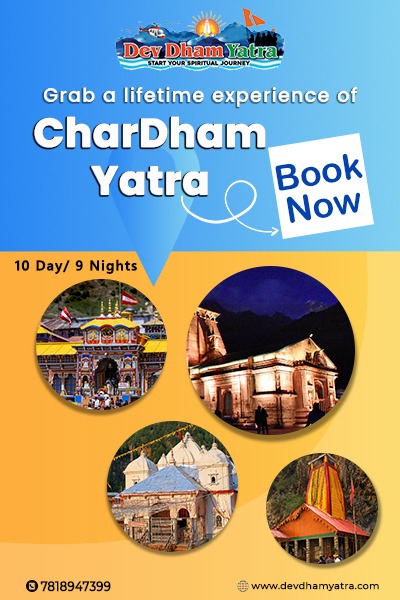
Most Popular

About ISKCON Temple in Mayapur- A Complete Guide
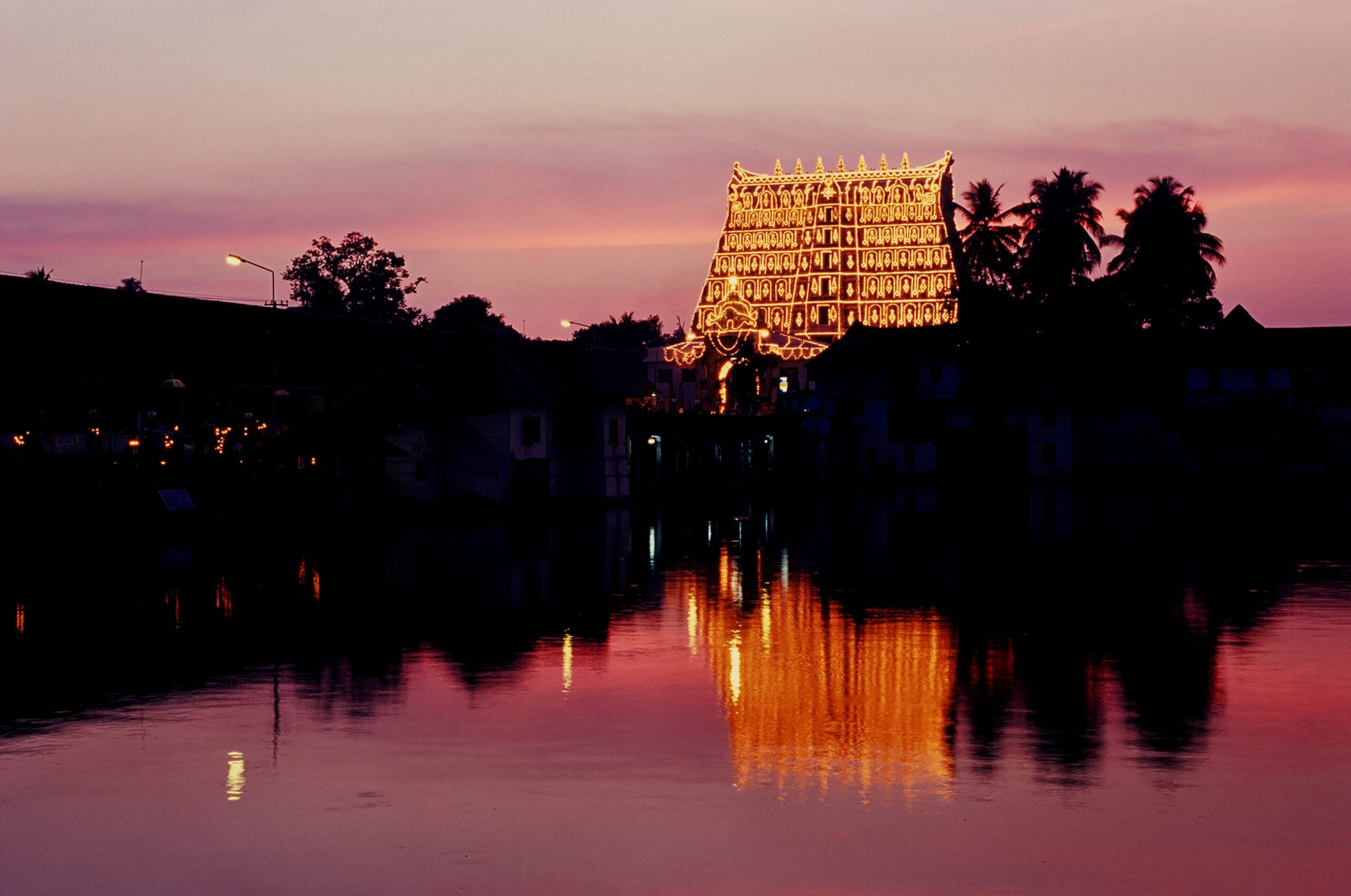
Shree Padmanabha Swamy Temple, Kerala Golden Temple of Kerala

Char Dham Yatra की 10 मई से हो रही है शुरुआत, 15 अप्रैल से होगा ऑनलाइन रजिस्ट्रेशन; यहां मिलेगी सारी जानकारी

Gangotri Dham 2024 : गंगोत्री धाम के कपाट खुलने की यह है डेट, इस समय से शुरू हेांगे दर्शन
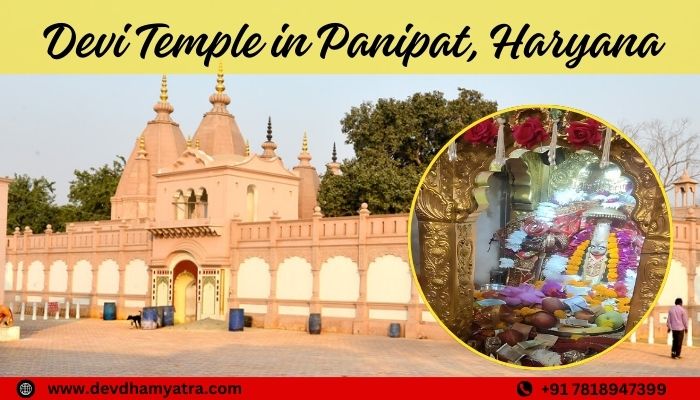

About Devi Temple in Panipat, Haryana

उत्तराखंड: चारधाम यात्रा Chardham Yatra के लिए आज से ऑनलाइन रजिस्ट्रेशन शुरू, जानिए कैसे करें अप्लाई
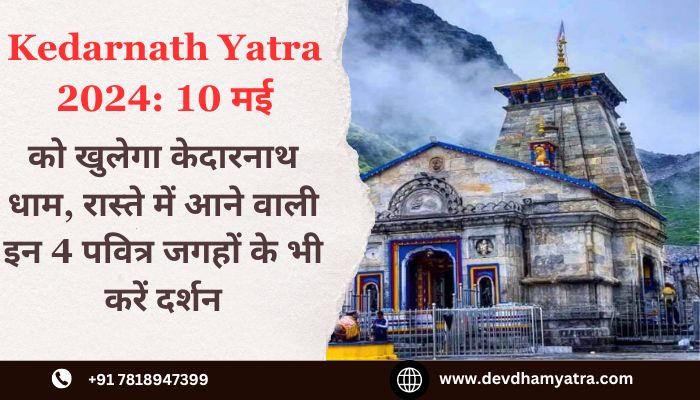
Kedarnath Yatra 2024: 10 मई को खुलेगा केदारनाथ धाम, रास्ते में आने वाली इन 4 पवित्र जगहों के भी करें दर्शन
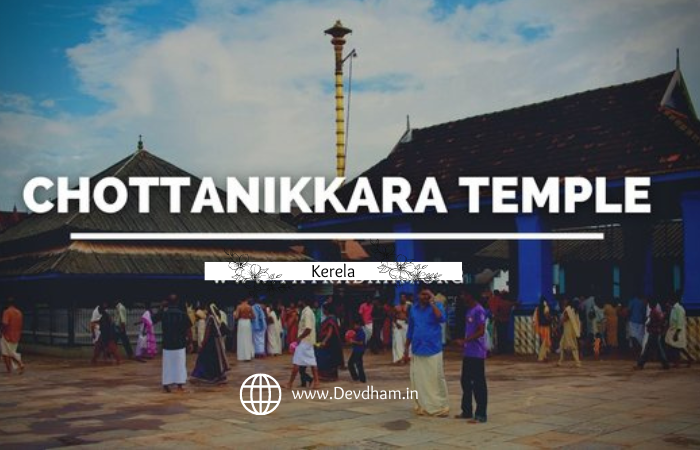
Sacred Majesty of Kerela Chottanikkara Bhagavathy Temple
Subscribe to our weekly newsletter.
Notifications only about new updates.
Leave a Comment Cancel Reply
Your email address will not be published. Required fields are marked *
Save my name, email, and website in this browser for the next time I comment.
Related Posts
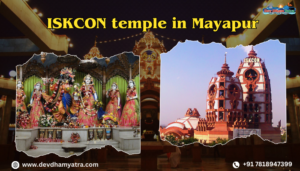
Devdham Yatra Packages
- We are most recommended Dehradun based tour and travel company of Uttarakhand. We provide all kind of tour and travel services in all the pilgrimage place.
Chardham Yatra
- Chardham Yatra from Haridwar
- Dodham Yatra (Badrinath-Kedarnath)
- Dodham Yatra (Gangotri-Yamnotri)
- Kedarnath Yatra Package
Chardham Yatra by Helicopter
- Chardham Yatra by Helicopter (DDN)
- Dodham Yatra by Helicopter
- kedarnath Yatra by Helicopter I
India's Most Popular Dham Yatra
- Baba Amarnath Yatra
Book by Phone
7818947399 7505771634.
Booking time: 0800 - 2000 hrs
Give your Feedback
Help us improve!
Services and Support
Support centre.
29, Tagore Villa, Dehradun UK
Our Partner
- Privacy Policy
- We are in the business of travelling and trekking, and it is very risky but we provide all the safety measures to our client. But some additional money will be charged for safety purpose. This will not included in your current package. All Prices are shown with packages on basic standard literary like group, and bulk booking. Before booking, first confirm the price.

15,549 Dham Yatris | 2000+ Yatras
© 2022 - Devdham Yatra - by AdxVenture
- [email protected]
SUBSCRIBE NOW
Trending news, staying at a backpacker hostel in oman : an experience beyond borders, unlocking global travel: the ultimate guide to seamless exploration with a us visa – visa hacks and tips revealed, mapping my wanderlust: a solo traveler’s obsession with exploring every nook and cranny of africa, the cape of good hope , they call it , a memorable adventure in meghalaya, captain nero’s hotel reviews: saimika resort, cherrapunjee.

Satopanth Lake Trek
Maximum Altitude: 15100 ft Duration: 4 days Difficulty: Moderate – Difficult Amidst the snow clad mountains and sun kissed meadows, the Satopanth Lake is one of the high altitude lakes in the Himalayan region that is often dubbed as the lake of divinity. The story goes that Lord Brahma, Mahesh and Vishnu descend on earth during auspicious days to take a dip in the pristine water of the lake and meditate here. Interestingly the lake is triangular in shape and each corner is said to be a dedicated spot for one of the holy trinities. Hence the Satopanth Lake is considered as one of the sacred lakes in the Garhwal Himalayan region. Every year thousands of pilgrims undertake the journey to reach the vicinity of Satopanth Lake to take a holy dip in the water in the belief that it will wash away their sins. Certain species of birds are found here, which pick up the pollutants of the lake and thus keep the lake clean. These birds are not found anywhere. The local belief is that they are the Gandharvas disguised, who guard the lake against evils. There is one more story from the time of Mahabharata. It is said that after the war, the Pandavas came to Satopanth valley, in search of peace and on the way to Satopanth, all four brothers Bheema, Arjuna, Nakul & Sahadev died along with Draupadi. Yudhisthira, the eldest of Pandavas could reach to Satopanth and from Swargarohini, he ascended to heaven alive. As you can see, this crystal clear glacier lake has a strong hold in mythology.
The journey to Satopanth Lake commences from Mana village, which is approximately 3 kilometers up from Badrinath. Badrinath is one of the Hindu “Char Dhams” which is popular for hosting a shrine dedicated to Lord Vishnu. The trek passes through several small streams, villages, alpine meadows and thick forest and once you step at a mighty altitude, you embark upon the dangerous glaciated tracks. The journey is as beautiful as it is adventurous. The snow covered Himalayan peaks of Neelkanth, Chaukhamba, and Balakun loom over the waters of the glacial lake and form a surreal silver horizon. Click here to read about Vasuki Tal Trek in Uttarakhand! Itinerary Day 1: Badrinath to Laxmivan (12,000 ft) – 8.5 km A short drive from Badrinath will take you to the mystical village of Mana which is also known as the “last village of India”. The gurgling sound of River Saraswati welcomes you in the village. The river is known as Gupt Gamini or the hidden river since it flows just about 100 metres from its origin and then merges into Alaknanda at Keshav Prayag in Mana. The trail takes you to is Bheema Pul. It is said that Bheem created this stone bridge so that his wife Draupadi could cross Saraswati river during their journey to heaven. The view of this extraordinary bridge and the din of the flowing river make this place interesting. Vasudhara falls – 5 km after Bheem Bridge this astonishingly high waterfall is very attractive. The most interesting aspect about this place is that all the water here becomes vapour and vanishes into the atmosphere. The view looks like the Ganges is descending from the sky.
You will walk along the dense forest, feel the peaceful aura of this beautiful place and spot the Bhojpatra trees and different variety of flowers. The astounding view of the nearby mountains like Chaukhamba, Neelkanth and Balakun will make you fall in love with the trail. The first campsite of the Satopanth Tal trek is Laxmivan. After reaching the campsite, you can go by the river and click pictures. Or you can sit by the camp and enjoy the view of peaks around you. From this campsite, you will see the Vasudhara waterfalls disappear and see Chaukamba and Swargarohini trying to peak out as you move up ahead slowly. Day 2: Laxmivan to Chakratirtha (13658 ft) – 9.5 km The trail from Laxmivan to Chakratirtha is tough but is also full of excitement and the view of the snowy peaks. The well marked trail is dotted with the green patches amidst the vast terminal moraines of Dhanno Glacier. On the way you can see the beautiful alpine flowers blooming in the valley, after which the glorious view of the three peaks of Bhagirathi will appear at the Satopanth Valley. Gradually climb the steep ridge of the mesmerizing Sahastradhara (literal meaning- thousand springs). Chakratirtha is a beautiful camping ground with green grass all around and towering peaks surrounding you. On reaching the campsite, roll on the ground and gaze at Mount Neelkanth. At night you may also hear the glacial ice breaking away into a thunderous sound.
Day 3: Chakratirtha to Satopanth Lake and back to Laxmivan (15100 ft) – 12 km Enjoy a cup of tea with enigmatic mountains around you and soak in the sun rays which are illuminating the snow covered peaks. Start a little early as camping is not allowed near the lake so you’ll have to trek down to Laxmivan.
The trail will take you through the puzzling maze of boulders and moraines. You may also hear tumbling sounds of avalanches through the valley. In the last stretch of the trek, you’ll come across a couple of steep slopes and walk over the loose soil which will increase the difficulty of the trek. But the moment you reach the top of the ridge and see the emerald lake for the first time, all your tiredness will vanish. The breathtaking views will sweep you off your feet. Nothing could have been more serene than gushing winds, broken glaciers and mighty peaks. The heavenly lake justifies all the myths and stories surrounding it. You’ll believe that this is actually the lake of Gods. After spending some time, descend down to the Laxmivan campsite and spend one more night in the middle of the mountains.
Day 4: Laxmivan to Mana This is the last day of the trek. Wake up to the chirping sounds of the colourful birds, have a nice breakfast with a view and then tumble down to Mana village. You can continue to your onwards journey from here, or decide to spend some time in the pretty village of Mana. Visit the Vyas Gufa where Ved Vyas, the renowned scholar lived and composed the famous four vedas. Interestingly, the roof of the cave looks noticeably flaky and does appear like a bundle of palm leaf manuscript. It is also believed that from this cave he narrated Mahabharata to Ganesha who was the assigned scribe to write the epic. And it’s not surprising to see Ganesh Gufa, a cave just a few metres downhill from the Vyas Gufa. Talk to the locals who will tell you these stories proudly and with such honesty that you cannot help but believe them. Also, don’t forget to enjoy a cup of tea at India’s Last Tea Shop.
Best Time To Visit Best time to travel to Satopanth Lake Trek is in summers (Mid May – June) and Post monsoon (September – October), when the weather remains pleasant and the sky clear for some magical views of far-flung high mountain peaks. How To Reach By Air: Jolly Grant of Dehradun is the nearest airport to Badrinath. The airport is well connected to Delhi with regular flights, whereas Badrinath is well connected by motorable roads with Jolly Grant Airport. By Rail: The nearest railway station to Badrinath is Haridwar/Rishikesh. The Rishikesh railway station is situated 295kms before Badrinath on NH58 and is well connected by with major cities of India. Trains to Rishikesh are frequent and Badrinath is well connected by motorable roads with Rishikesh. Taxis and buses are available from Rishikesh/Haridwar to Badrinath. By Road: Badrinath is well connected by motorable roads. Buses and taxis to Badrinath are easily available from major cities of Uttarakhand state like Dehradun, Haridwar, Rishikesh, Pauri, Rudraprayag, Karnprayag, Srinagar and Chamoli. Click here to read about Digar La Trek in Ladakh!
Vasuki Tal Trek
Baraadsar Lake Trek
OnHisOwnTrip
Related posts, hotels in guwahati under rs 5,000, vanuatu’s incredible diving festival : naghol, dishes you must try in germany, the siju caves of meghalaya, japan in seven days, ladakh in ten pictures.
Username or Email Address
Remember Me
Registration is closed.
Our trips are about a lot more than just seeing a place. There is a strong emphasis on bonding.
Useful Links
©2023. OHOT All Rights Reserved.
Choose Trek
Customise Trek
Suggest me a trek
Rent a gear
Volunteer Program
Blogs & Articles
Discounts & Offers
Discover Satopanth Lake Trek: Unforgettable Adventure
Dear Trekkers,
Are you looking for a thrilling and breathtaking trekking experience? Look no further than the Satopanth Lake Trek in India. Located in the Chamoli district of Uttarakhand , this trek offers a journey through stunning landscapes and awe-inspiring views, culminating in the magnificent Satopanth Lake . Imagine standing before a crystal-clear lake reflecting the majestic Himalayan peaks, that’s the awe-inspiring Satopanth Lake .

This a brand new trek started by us and we encourage each of you to embark on this stunning adventure that is the Satopanth Lake Trek. We are thrilled to announce that the trek opens on 28th May – 16th June and we can’t wait to present another wonderful trek for all of you!!!
How The Journey Unfolds

The trek starts from the picturesque town of Badrinath and takes you through Mana village, believed to be the last inhabited village before the Indo-China border. The village is steeped in mythology and is believed to be the abode of the Pandavas during their exile. The trek then ascends through the Vasudhara Falls, a stunning 400-foot waterfall, and the Swargarohini base camp, which offers breathtaking views of the surrounding peaks.
The highlight of the trek is undoubtedly Satopanth Lake , a glacial lake located at an altitude of 14,100 feet. According to Hindu mythology, the lake is believed to be the meeting point of Lord Brahma, Lord Vishnu, and Lord Mahesh. The lake’s crystal-clear waters reflect the surrounding peaks, making for a truly awe-inspiring sight. The lake is also considered sacred by the locals, and it is said that a dip in its waters can wash away sins.
The trek takes you through lush green forests, rocky terrain, and snow-capped peaks, making for a truly diverse and exhilarating experience. The trail is approximately 38 kilometres long and takes around 6 days to complete, with altitudes ranging from 4,500 to 14,000 feet.
Why We Suggest The Satopanth Lake Trek To Everyone
Step Into The Mythical World Of The Pandavas With A Visit To Mana Village

The trek starts from the picturesque town of Badrinath and takes you through Mana Village, which is believed to be the last inhabited village before the Indo-China border. The village is steeped in mythology and is said to be the abode of the Pandavas during their exile. The village is also home to the Vyas Gufa, where the ancient sage Ved Vyasa is believed to have composed the epic Mahabharata.
Experience The Beauty And Serenity Of The Himalayas

The trek takes you through lush green forests, rocky terrain, and snow-capped peaks, making for a truly diverse and exhilarating experience. The region is also home to a wide variety of flora and fauna, including the elusive snow leopard.
Embark On A Journey Of Discovery As You Witness The Ethereal Beauty Of Vasudhara Falls
The trek ascends through the Vasudhara Falls, a stunning 400-foot waterfall. The falls are said to be named after the legendary queen of the Pandavas, who is believed to have taken a dip in the falls.
Challenge Yourself And Discover The Sacred Beauty Of Satopanth Lake

Satopanth Lake is undoubtedly the main highlight of the trek. The lake is located at an altitude of 14,000 ft and it is a true natural wonder and a sight to behold. According to Hindu mythology, Satopanth Lake is the meeting point of Lord Brahma, Lord Vishnu, and Lord Mahesh, adding to the mystique and spiritual significance of the trek. The Satopanth Lake is considered sacred by the locals and believed to wash away sins, making it an experience that is both awe-inspiring and spiritually uplifting. The Satopanth Lake is not just a destination, it’s an experience of a lifetime that will leave you with memories to cherish forever.
Witness The Resilience And Adaptability Of The Bhotiya Tribe

The region is home to the Bhotiya tribe, who have a rich cultural heritage and a unique way of life. The locals are warm and hospitable and offer a glimpse into their traditions and customs. The trek offers the opportunity to interact with the locals and experience their way of life.
The Satopanth Lake Trek is a truly remarkable experience that offers a journey through stunning landscapes, rich culture, and mythology. The trek is a must-do for adventure enthusiasts looking for a challenging and rewarding experience. So, pack your bags and head out on this journey of a lifetime!
Happy trekking!!!!
- Search for:
A little something about you, the author. Nothing lengthy, just an overview.
The BA Trek Trivia Challenge: Participate & Win free treks!
Satopanth Lake Trek
A Trek to an Enchanting Lake in the Shadow of Giant Mountains
Available Batches
September 2024, october 2024.
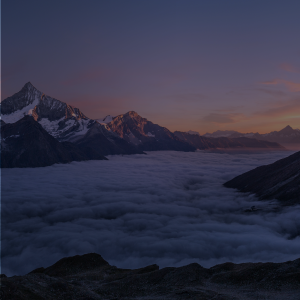
Brief Description
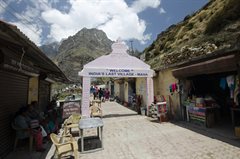
Brief Itinerary
Detailed itinerary.
Badrinath to Laxmiban (12,000 ft) - 7.3 km (Click to View GPS data)
We start our day with an easy walk up the Alakananda river towards the Somtoli meadows. You will see the mighty 400 ft Vasudhara falls on the opposite banks after a while. The trail climbs gradually till Somtoli, crossing a landslide section. You might find few shepherds here or their vacant caves. From here, a small walk through a boulder section takes us to our campsite marked by a cluster of Bhojpatra trees on the slopes. The campsite has great views of Alkapuri, the snout and starting point of Alaknanda river and the Balakun peak.
Laxmiban to Chakrateerth (13658 ft) - 7.0 km (Click to View GPS data)
The trail gets more challenging today. We will start with a sharp ascent through boulders and scree to Sahastra Dhar. As we climb up the valley, views of NIlkanth, Balakun and Chaukhamba open up. Once we reach Sahastra Dhar, we will cross a little stream and walk across a flat area with dozens of streams flowing and merging with each other. Then, we start traversing the left (true right) lateral moraine of the glacier coming down from Chaukhamba at the head of the valley. The trail climbs steeply again after Sahastra Dhar, followed by a short level walk across the upper snow slopes to reach our campsite at Chakrateerth. We will camp in Chakrateerth for the night.
Chakrateerth to Satopanth Lake (14258 ft) to Chakrateerth - 4.9 km (Click to View GPS data)
Although today's trail is short with an easy ascent, the trail goes through tricky boulder sections along the left (true right) lateral moraine. We will cross two spurs coming down from the slopes of Nilkanth to our left (true right) to reach Satopanth Lake - a beautiful blue triangular lake. Throughout the day, we will have imposing views of Chaukhamba and Nilkantha, and a bunch of small glacial lakes to our right. After spending some time at the lake, we will return to Chakrateerth for the night.
Chakrateerth to Chamtoli (11745 ft) - 8 km (Click to View GPS data)
We retrace our track today and reach Chamtoli, where we will camp for the night.
Chamtoli to Mana - 10.2 km. Drive to Joshimath. (Click to View GPS data)
We will finish the remaining descent today and then drive from Mana to Joshimath. Overnight stay in hotel/guest house
What's Included
- Food as per menu on the trek (Lunch on Day 2 till Lunch on Day 7)
- Forest Permits/Camping Charges, if any (upto the amount charged for Indian nationals)
- Tents, Sleeping bags, Sleeping mats
- Micro-spikes, Gaiters, and Helmets as required
- Experienced Trek guide, cook, helpers, and porters for carrying common supplies
- Mountaineering course certified Trek Leader with First Aid certification
- Guesthouse/Hotel accommodation (twin/triple sharing) in Joshimath on Day 1 and Day 7
- Guesthouse/Hotel accommodation (twin/triple sharing) in Badrinath on Day 2
What's Not Included
- Portage of personal bags during the trek
- Cost of any kind of Travel Insurance.
- Any Expense of personal nature.
- Any Expense not specified in the inclusions list.
- Meals during road journeys
Are you Eligible for this Adventure?
Max Altitude

BRS Level Required
Satopanth Lake Trek is a level 4 adventure on the Bikat Rating Scale.
This makes it mandatory for you to have high-altitude experience of preferably multiple treks marked at level 5 on the BRS. The altitude, the terrain and the nature of the climb demand a certain level of skill and a need for you to be aware of how your body reacts to the various features of high altitude environment.
If you do not know what level of BRS trek would suit you best, worry not! Fill out this Form:

we will send you a progression chart to help you comfortably get out of your comfort zone in order to level up and ultimately reach your highest potential in the big, bad world of outdoor adventure.
Packing List
This is a list of essential items for individuals doing the trek with Bikat Adventures. This list contains only those items which the participants are required to bring with them. The list excludes those items which are provided by Bikat Adventures on the trek. We have divided the items into five categories. All the items in the list are essential except for those marked as optional.
Trekking Gear
- Ruck sack bag with rain cover. Qty -1
- Day Pack Bag - Recommended for treks with summit day
- Head Torch with spare Batteries. Qty -1
- U V protection sunglasses. Qty -1 Here is how you can choose the best sunglasses for trekking.
- Water Bottles: 2 bottles of 1 liter each
- Non-skid, deep treaded, high-ankle trekking shoes Qty -1
- Pair of light weight Slipper/Sandals Qty -1
- Quick Dry Warm lower or Track Pants. Qty - 2
- Full sleeves T-shirts/ Sweatshirts. 1 for every 2 days of trekking
- Pair of thick woolen socks. 1 pair for every two days of trekking
- Thermal Body warmer Upper & Lower. Qty-1
- Undergarments. Qty - 1 for every day of trekking
- Warm jacket closed at wrist & neck .Qty-1
- Full sleeves sweater. Qty -1
- Rain wear ( Jacket & Pants ) . Qty-1
- Pair of waterproof, warm gloves. Qty-1
- Woolen cap. Qty-1
- Sun shielding Hat. Qty -1
- Personal toiletries kit (Small Towel, Toilet paper, paper soap, Bar soap, toothbrush, toothpaste, cold cream, etc.)
- Sun screen lotion small pack. Qty -1 Here is your Sun Protection 101 to stay safe in the bright sunny outdoors.
- Lip Balm small pack. Qty-1
- Small size, Light weight & Leak proof lunch box. Qty-1
- Plate. Qty- 1
- Spoon.Qty-1
- Tea/Coffee (plastic) Mug.Qty-1
Miscellaneous
- Camera (Optional)
- Carry your medicines in plenty in case you have any specific ailment. Consult your doctor before joining the trek.
- Dry fruits, Nuts, Chocolate bars (Optional)
Frequently Asked Questions
Eligibility, is this adventure good for me, what’s a good fitness benchmark for this adventure, what skills do i need to complete this adventure, what is the minimum and maximum age limit, about the activity, where is it located, what are some of its highlights, what are some of its challenges, what is the best season for this, what is the accommodation type, what is the temperature like here, is it technically challenging, connectivity, how do i reach the starting point, is there cellular network available throughout, where is the nearest atm, if i choose to travel to the base with you, what is the pick-up point, what time is the drop-off on the last day, what are the nearby attractions that i can explore, equipment & gear, what equipment is provided to us, what can i rent from you, where will i receive the rented items, where do i have to return the rented items, what gear do i need to bring, are there local shops to rent/buy equipment, facilities & additional services, can i offload my bag, can i leave any extra luggage i carry at the base of this adventure, what are the meals like, what are the washroom/ toilet facilities like, what should i do if i get my period on this adventure, what are the medical facilities available to me on this adventure, are there any electricity charging points on this adventure, mandatory documents, what documents do i need to carry, do i need insurance for this, do i need a permit for this, certification, do you provide a certificate of completion, when and how will i get the certificate of completion, international travel, will i need a visa, when should i apply for the visa, what kinds of insurance do i need to travel here, what is the specialty of this when compared to other mountain ranges, till which month can i make a booking for this, what is the qualification of the outdoor leader provided to us, how do you choose your outdoor leaders, is it safe for women, what is the ratio of outdoor leader to participants, what do you do in case of an emergency, what are the rescue options on this adventure, how do you choose your equipment, can i attempt this adventure if i have a specific medical condition, sustainability, what kind of camping do you practice on your outdoor adventures, why are you against fixed camping in the outdoors, how do you manage overcrowding on certain trails, what are some things to remember when using a dry toilet, why should i avoid wet wipes in the outdoors, where should i dispose of my sanitary waste if i am on my period, why should i carry my own utensils on an outdoor adventure, booking process, what happens after i make the payment, do you create a whatsapp group of participants before the start date of the activity, do i need to submit a medical certificate, do i need to submit an undertaking form.
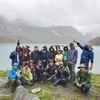
Small Group Size
Our batch sizes are capped at 15 for smaller treks with the trek leader and trekker ratio of 1:8. This ratio, in our years of experience, has proven to deliver the best trekking experience for individuals as well as groups. Capping the size of the group ensures individual attention to each trekker so that no signs of distress or need during the trek go unnoticed. It also helps to form a more cohesive cohort with better group energy which helps define the rhythm and pace of days on the trek. As you go higher up on the BRS scale, since the stakes are higher, expeditions have an even smaller group size with the ratio of expedition leader to climber set at 1:2.
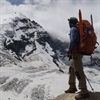
Qualified Trek Leaders
We follow a rigorous regime of hiring and training our experts in the field. Each trek leader is a certified mountaineer with years of experience in the field. In addition to their qualification, they also go through practical and situational training to tackle any and all kinds of sudden conditions that may present themselves on the ground. Being unpredictable is the core nature of the mountains but being ready for any circumstance as best as possible is a controllable asset that we try to nurture. Our field experts are also trained in basic medicine and first-aid response. Watch: Forerunners - The Making of A Trek Leader At Bikat Adventures
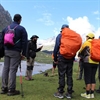
Guided Progression
Since Bikat Adventures is a learning-based organization, we help you climb up the ladder of difficulty within the sphere of outdoor adventure systematically. Our on-ground training modules are designed to handhold you through the upskilling process so that you are ready to take on bigger challenges.
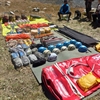
Equipment Quality and Check
All the gear used on our treks and expeditions is tried and tested, maintained for good quality, and is overall top-notch in quality and condition. We are continually looking to obtain the best of everything there is in the market so as to ensure optimum safety.
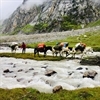
Support Systems
Along with the staff you see on-ground, we have a team of superheroes working in the background to give you the best experience possible. Our background team also comprises local staff from each area who know the region best. Having local support helps with studying the area, pre-planning, execution, and in receiving timely support in case of emergencies in these remote locations.

Communication
Our on-field staff is in constant contact with our teams based in primary locations so as to eliminate any avoidable delay in reaching additional help and support when required. We try to use the best tools for communication available, including satellite phones, in regions where they are not restricted.
What our customers Say

Cancellation Policy
Cash refund
Cancellations up to 30 days prior to departure date
5% deduction
Cancellations between 30 days to 15 days prior to departure date
50% deduction
Cancellations within 15 days prior to departure date
Voucher refund
Cancellations up to 5 days prior to departure date
No Deduction
Cancellations within 5 days prior to departure date
- Cash refund is applicable only in case of bookings made without using any promotional offer code or vouchers
- This is only a brief of cancellation terms. For finer details please refer Detailed Cancellation Policy.
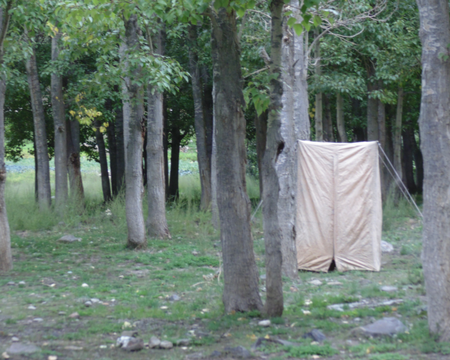
Subscribe for latest updates & offers
Similar adventures.
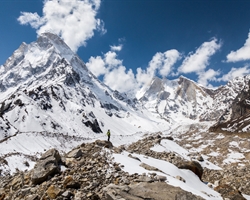
Gaumukh Tapovan Trek
Not just a trek but a journey to the source of river ganga.
Uttarakhand
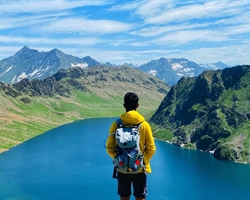
Tarsar Marsar Trek
A shorter and easier alternative to the kashmir great lakes trek.
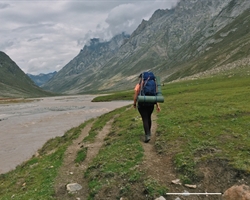
Miyar Valley Trek
The yosemite of the himalayas, enter your email, events by categories.

Mountaineering

Scuba Diving
Events by months.
- January July
- February August
- March September
- April October
- May November
- June December
Events By Nights
- 5 & More Night
- Environmental Policy
- Privacy Policy
- Term & Conditions
- Work With Us
- Address: 303, 3rd Floor, Tower B4, Spaze Itech Park, Sector 49. Gurgaon
- Pre Sale - 7838148127 , Post Sale - 8588878499, 9667639126
Bikat Adventures
- Cancellation & Refunds
- Content Sharing

© 2024 Bikat Adventures - All Rights Reserved
Powered by: novel knett software solutions, submit enquiry.
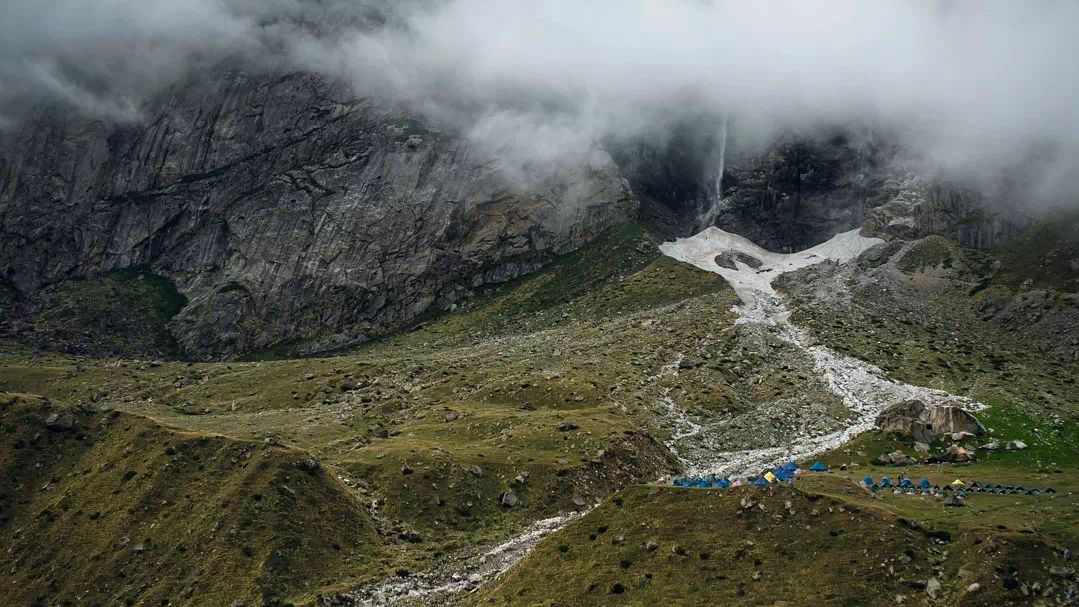
Satopanth Lake Trek
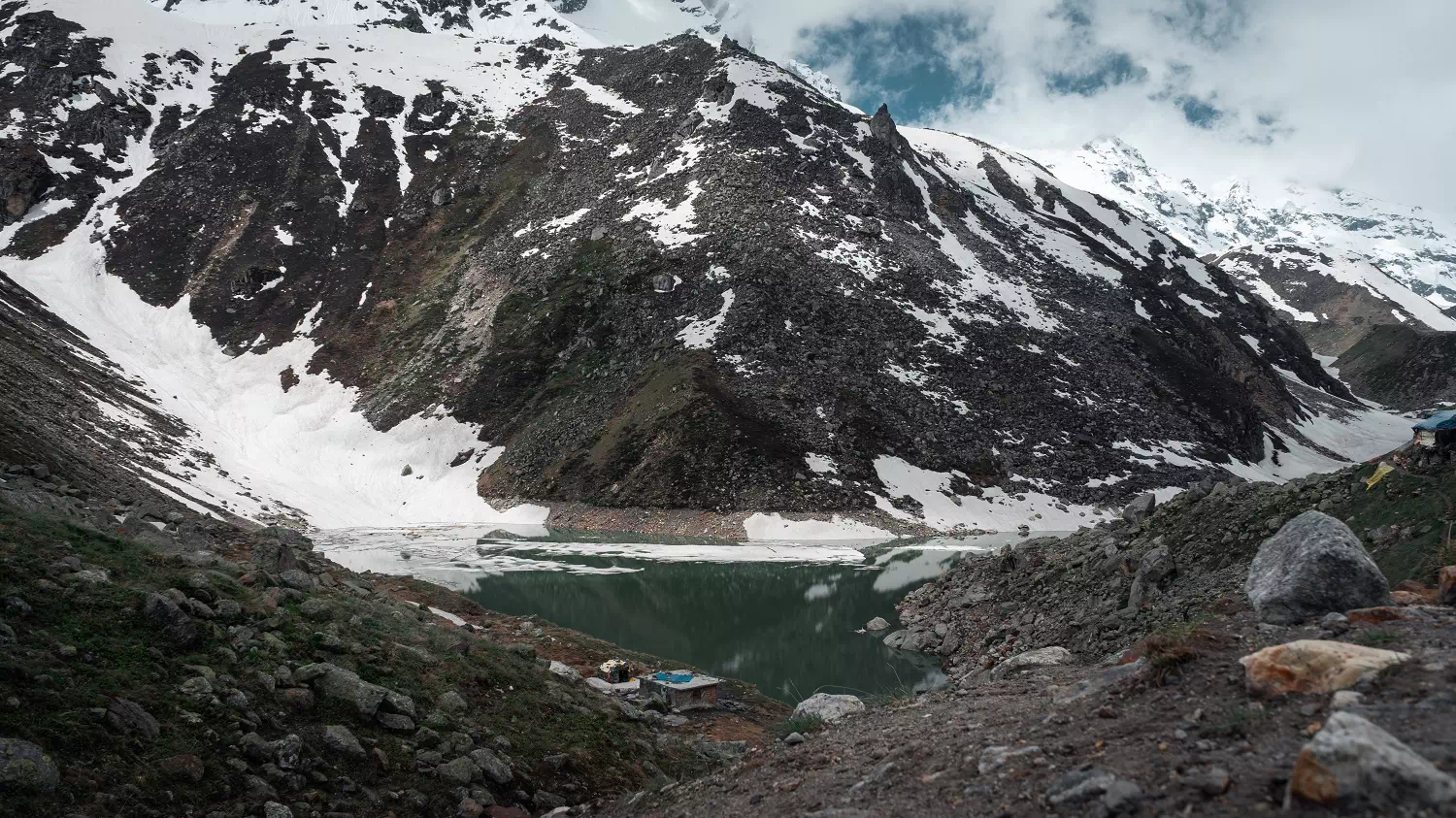
Day 1 Dehradun - Joshimath - Badrinath
We begin the day early and drive to Joshimath via Devprayag, Rudraprayag. One can see Devprayag (confluence of Alaknanda & Bhagirathi.) on the way. The Holy River Ganges starts from here. We reach Badrinath by evening and spend the night in a guest house.
Day 2 Badrinath - Mana - Vasudhara Falls Camp
In the morning visit Badrinath temple and later after breakfast drive a short distance to Mana village (Last village of the border). From here we will trek to Vasudhara falls via Bheem Bridge with packed lunch. Mana Village – 3 km from Badrinath, this is the last village of India on the Indo-Tibetan border. The Indo-Mongolian tribe set up this village. A population of 200 people lives here. Tourists come in plenty to this quaint village. Bheem Bridge – A short distance from Mana Village a natural bridge made of a huge boulder, over the river Saraswathi is seen. The story goes that Bheem; one of the Pandava brothers put it there. The view of this extraordinary bridge and the din of the flowing river make this place interesting. Vasudhara falls – 5 km after Bheem Bridge this astonishingly high waterfall is very attractive. The most interesting aspect about this place is that all the water here becomes vapour and vanishes into the atmosphere. The view looks like the Ganges is descending from the sky.
Day 3 Vasudhara Falls Camp - Laxmi Van - Chakrateerth Meadow
In the morning after breakfast we trek to Laxmi Van (2 kms). This is a small meadow with pastures for goat and sheep to graze. It has a few caves where gujjars stay with their flock of animals. After lunch we further trek to Chakrateerth meadow which is just 3 kms away from the lake. This is a beautiful camping ground with green grass all around and towering peaks surrounding you. At night one may also hear the glacial ice breaking away into a thunderous sound.
Day 4 Chakrateerth Camp To Satopanth Lake And Back To Laxmi Van
The trek from Chakrateerth meadow to the lake is very strenuous on the knees and is entirely over glacial debris. Walking over huge boulder and stones can take a toll on the knees but the calm and placid waters of the lake are a rewarding sight. Satopanth Lake is 18 km from Mana Village amidst the difficult areas of Himalayas. The water in the lake is very calm. On the banks of this lake are innumerable lotus flowers. We head back to our camp site and trek back to Laxmi van.
Day 5 Laxmi Van - Vasudhara Fall - Mana - Badrinath
In the morning trek back to Mana village and then drive 3 kms to Badrinath with pack lunch. One can also take the alternate route to reach Badrinath directly. Upon arrival at Badrinath check in to hotel for dinner and overnight stay.
Day 6 BADRINATH - RISHIKESH
Early in the morning drive to Haridwar via Rudraprayag & Devprayag.
Day 2 How difficult is the trek & what are the challenges?
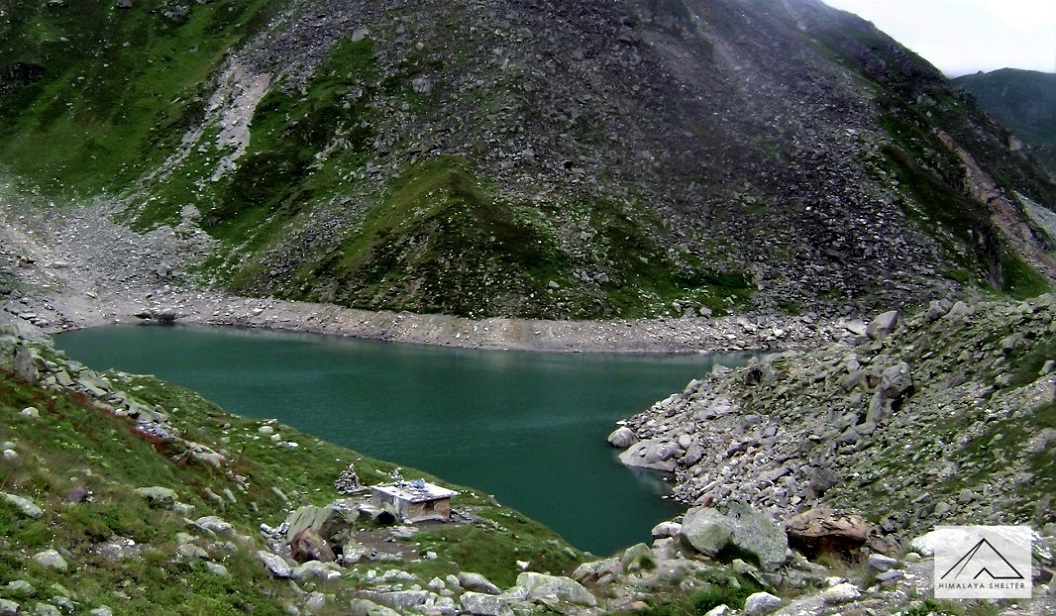
Upcoming Treks
- June 24, 2023 open
FAQ's about Satopanth Lake Trek
What is the best time to do satopanth tal trek.
The most ideal times for the Satopanth Tal Trek are in the summer and after the monsoon. In the summer, which spans from mid-May to June, you’ll have a great time. Similarly, September to October, after the monsoon, is another fantastic time for this trek. During these periods, you’ll be treated to clear skies and delightful weather.
On the other hand, in the monsoon season, you can revel in the breathtaking beauty of the Satopanth Tal lake, surrounded by vibrant greenery.
What is the difficulty level of Satopanth Tal Trek?
The Satopanth trek is moderately challenging. It will help if you have some prior experience with high-altitude trekking. You can also improve your stamina by doing activities like jogging, cycling, and swimming.
What is the height of Satopanth lake?
Satopanth Tal, a glacial lake situated amidst the snow-capped peaks of Uttarakhand, India, is located at an altitude of 4,600 meters (15,100 feet) above sea level.
Is Satopanth Tal Trek safe?
The Satopanth Tal trek is generally considered safe, provided you take necessary precautions and trek with a reputable organization. The trail is well-maintained, with no major technical challenges. However, like any high-altitude trek, there are inherent risks, such as altitude sickness, unpredictable weather, and potential for injuries. We prioritize safety, providing essential measures and a medical kit for emergencies. A knowledgeable guide accompanies you, enhancing your Satopanth Lake trek experience. Additionally, the package includes travel insurance for added security.
What is the starting point for Satopanth Tal Trek?
The Satopanth Tal Trek starts from a charming village called Mana in Uttarakhand, India. Interestingly, it’s the last village before reaching the border with China. Mana village is very close to the famous pilgrimage town of Badrinath, and you can easily reach it from both Haridwar and Rishikesh.
What is the total distance of the Satopanth Tal Trek?
The Satopanth Tal Trek covers a distance of approximately 50 kilometers for the entire round trip. Typically, this trek takes around 5 to 6 days to complete.
What is Satopanth famous for?
This sacred lake holds deep religious significance for the local community. In a solemn tradition, the inhabitants of Mana village honor their departed loved ones by gently placing their ashes into the serene waters of the lake.
What is the temperature during the Satopanth Tal trek?
The temperature during the Satopanth Tal trek varies greatly depending on the time of year and the altitude. Generally, the trek tends to be chilly all year round, with colder nights and milder days. Here’s a breakdown of the temperature ranges:
Summer (May to June):
- During the summer months of May and June, the days offer a comfortably cool range of 10°C to 20°C at lower altitudes, providing a pleasant atmosphere for trekking. At higher altitudes, the temperatures range from 5°C to 15°C. Nights remain cool but not overly cold, with readings between 0°C to 10°C at lower altitudes and -5°C to 0°C at higher altitudes.
Monsoon (July to August):
- The monsoon season brings slightly lower temperatures. Daytime temperatures range from 10°C to 15°C at lower altitudes and 5°C to 10°C at higher altitudes, offering a refreshing trekking experience. Nights become cooler, with temperatures ranging from 0°C to 5°C at lower altitudes and -5°C to 0°C at higher altitudes.
Autumn (September to October):
- In autumn, the days remain cool and comfortable for trekking. At lower altitudes, temperatures range from 5°C to 15°C, providing an enjoyable trekking environment. Higher altitudes experience temperatures from 0°C to 10°C. As the season progresses, nights gradually become colder, with readings dropping to -5°C to 0°C at lower altitudes and -10°C to -5°C at higher altitudes.
Winter (November to April):
- Winter brings chilly conditions, especially at higher altitudes. During the day, temperatures range from -5°C to 5°C at lower altitudes and -10°C to 0°C at higher altitudes. Nights can be very cold, with readings between -15°C to -5°C at lower altitudes and -20°C to -10°C at higher altitudes. It’s important to be well-prepared for the cold weather during this season.
Remember, these are just average temperature ranges, and actual temperatures may vary based on weather conditions. It’s always wise to be ready for colder weather, particularly at higher altitudes and during the night. Make sure to pack appropriate clothing, including thermal layers, a warm jacket, and don’t forget a hat and gloves.
What is the best time to do the trek and how is the weather?
What are the top highlights of the trek, 1 review for satopanth lake trek.
Diksha agarwal – February 8, 2022
I am planning to go on this trek. Kindly contact on the below mentioned email id
Your email address will not be published. Required fields are marked *
Your review *
Name *
Email *
Save my name, email, and website in this browser for the next time I comment.
- Transport support from and to Dehradun: starting from pickup on day 1 to drop on day 6.
- Guide and cook fees.
- Rent for camping equipment.
- Forest entry charges.
- Porter and mule support to carry camping equipment. Please note that personal luggage can be carried by mules and/or porters on chargeable basis.
- All veg meals starting from day 1 dinner to day 6 breakfast.
- Tented accommodation throughout the trek.
- Your designated hotels may not reopen by the time you reach there. While we are making alternate arrangements, do understand that things may not be as “tip-top” as our designated hotels.
- The gurudwara, Hemkund Sahib may not be open. While we are trying to take permission to go to Hemkund Sahib, if it does not happen, then do understand that the pandemic has put restrictions beyond our control.
- Personal expenses like tips, personal medicines, phone calls etc
- Any transport support during the trek apart from what is included above
- Any cost or services not mentioned in the Inclusions
- Accommodation apart from the trek
- Adventure Insurance
- Cost arising due to unforeseen incidents like bad weather, medical evacuation, roadblocks etc
- Porter and mule support to carry personal Luggage can be arranged at an additional cost of INR 350 per bag per day (weighing up to 12 kg)
- Lunch box for packed lunch/breakfast. To avoid using polythenes and Aluminium foils. Keeping the Himalayas clean is our own responsibility. Reduce the use of Plastic when you are in the abode of the Sacred Himalaya
- 17-07-2021 to 23-07-2021 open
- 17-07-2021 to 23-07-2021 close
Send Request
Your query has been successfully registered. we will contact you within 24 hours., something went wrong.try after sometime..

Satopanth Tal
Sankri,Garhwal,Uttarakhand
Moderate to Difficult
Maximum Altitude
INR 15000/- Badrinath to Badrinath
Available Date
Customised dates available

About Satopanth Tal Trek
A mythological journey in the Laps of the Himalayas in Devbhoomi Garhwal, this trail is believed as the stairway to heaven, which Pandavas with Draupadi, their wife, traveled through to their journey to Heaven. It is also a very important pilgrimage point of Hinduism, that is Badrinath Ji, or Badri Vishal, Dedicated to Bhagwan Vishnu, one of the Chaar Dham.
Satopanth Lake is a triangular shape high altitude glacial lake situated at 15,100 fts above the sea level at a distance of 25 KMs away from Badrinath Ji. As you start this trek you are about to witness one of the oldest and holy River of India, SARASWATI which visible only here in Badrinath Ji and origin of other holy river ALAKNANDA, Caves of Rishi-Muni used for meditation, Waterfalls like Vasudhara and Sahasradhara, Snow- capped mountain peaks Chaukhambha, Neelkath, Parvati, Satopanth col, Balakun, Nara Narayan and Satopanth Glacier which fill you full of energy and thrilling. This lake has a religious significance for the Hindus. According to the legend, each corner of this triangular lake, the Hindu trinity Brahma, Vishnu and Mahesh mediate here thousands of years. And, it is also believed that the Pandavas the heroes of Mahabharat get salvation in this route. Draupadi wife of Pandavas got first moksha after crossing Saraswati river near the Bhim Shila bridge, Sahadeva at Laxmivan, Nakul at Sahastradhara, Arjun at Chakratirth, and Bhim at Satopanth. Only Yudhishtir, the elder brother of Pandavas reach heaven alive with a Black Dog who accompany throughout this route from Swargarohini which is 5 KM away from Satopanth lake. This trek is full of adventurous and pilgrimage, worth giving a try for it. Due to arduous and challenge nature of this trek previous experience of trekking in mountain must be required.

Badrinath Arrival: Meet and Greet with our staff at Badrinath Ji, who help you check-in Hotel/Guest House/Lodge. Take rest in your rooms and get rid of your tiredness of long hours journey.
Rest day and Acclimatisation:-
Today will be the acclimatisation day and rest day as well for the previous day long journey. One can visit Badrinath Ji, or explore the surroundings.
Badrinath – Mana – Laxmivan (3400 Mt), trek 10 km. 6 hr:- Today our trek start from the Mana village which is 3 KM away. Mana village is the last Indian village of India. During the trek we will be crossing the holy Saraswati River and breathtaking view of Vashudhara waterfall with their gurgling sound. As enjoying this beauty of nature, we reach our first campsite Laxmivan which is lush green meadow, Where you find Bhojpatra (Birch tree), which used ancient time for writing. Overnight stay either ancient cave or tents.
Laxmivan – Chakrateerath (4200 Mt), trek 9 KM 6 Hrs. Today trek is challenging, after breakfast we start our trek after covering 4 KM distance we find the stunning view of Sahastradhara (Thousand of Glacier waterfalls) and snow capped mountain peak Neelkanth in-front of us. Now the route is steep and narrow so be careful during the trek. After crossing the ascent and descent ridge, we reach an open circular meadow which is known as Chakratirth. Overnight stay at camps
Chakratirth – Satopanth- Chakratirth (4600mtrs), trek 10 KM, 7 Hrs.) Satopanth Lake is located 5 KM away from Chakratirth. The further route demands lot of courage amidst the difficult terrain laden with boulders and rocks. However, the trek rewards the trekkers with an unparalled view of the crystal clear lake, Satopanth on its backdrop of Parvati and Chaukhambha massifs. A mere glace at the majestic mountain and lake will make you forget your tiring journey to reach here. Spend some time here exploring the region and return to Chakratirth. Overnight stay at tents.
Chakratirth – Laxmivan- Badrinath Ji, trek 15 KM, 7 Hrs. After early breakfast, trek back to Badrinath via Laxmivan. After a tiring day, rest into guest house/lodge/ hotel and get riding off your whole day tiredness.
Departure from Badrinath Ji After morning delicious breakfast you start for your journey to sweet home with the sweet memory of the mytholgical Holy Satopanth Lake trek-the last journey of Pandavas. Leave only footprints take only memories
"What included"
Cost of accommodation in Huts/Hotels/Homestays two nights in Badrinath Cost of Fooding while on trek (Morning and evening Tea, Breakfast, Lunch, and Dinner- meals will be provided. Breakfast-Roti, Sabji/Maggi, etc., Lunch/Dinner-Rice/Roti, Sabji, Dal, Achar, etc.).(Day 1:- Dinner to Day 7:- Breakfast) Technical Camping equipments:- Tents(sharing basis), Sleeping Bag, Mattress, Utensils, Microspikes, Technical climbing equipments Guide,Support staff,cook, Supporting crew. Cost of Permit fees.
"What not included"
Cost of Personal expenses. Cost of emergency due to bad weather conditions. Cost of personal porter for offloading Meals during transit i.e. meals while on road or travelling will not be provided. No meals will be provided in Last day (Day 8) Anything which is not mentioned in the inclusion. Cost of transportation from Dehradun to Dehradun/Haridwar to haridwar. Any cost related to mandir Darshan
Haridwar to Haridwar package can be arranged on Special Request
Things to carry on a Trek

Have a question in your mind?
call us or whatsapp
+91-9748955458 +91-9674715111
click the whatsapp button to start whatsapp chat
to know our office location and more details
Booking Policy:
To book your trek, you need to pay 30% of the trek fees as advance. Rest 70% to be paid in cash when you reach the basecamp, to be collected by the team leader.
One can pay the amount online(Net Banking, GPay, UPI ID).
Details to be shared on request.
Cancellation Policy:
30 days before the trek date, full refund of the paid amount
15 days before the trek date, 50% refund of the paid amount.
Cancellation less than 15days to the start date of the trek, no refund possible
In case Himalayan Passion cancels the trek or trip, full refund will be paid.
One has option to send another person on their behalf.
One has option to adjust the paid amount on any other trek, if a person cannot join the trek he/she paid for.
Satopanth Glacier: Planning for a High Altitude Trek?
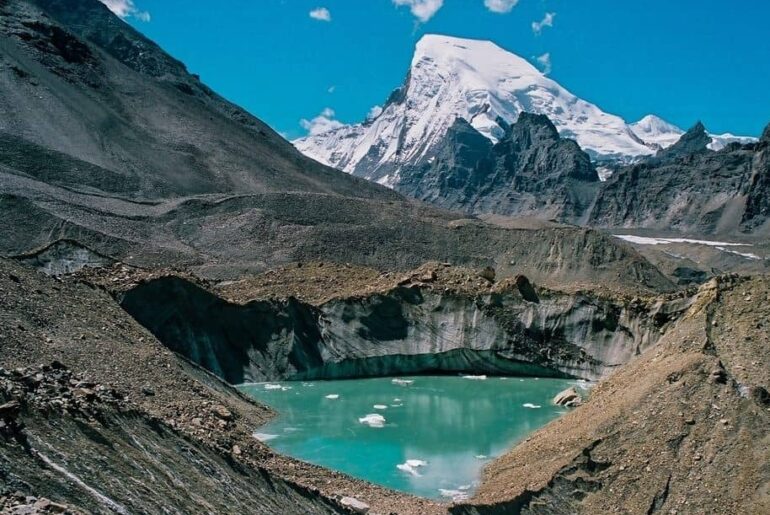
Satopanth Glacier : Planning for a High Altitude Trek?
The Satopanth Glacier is a popular destination for hikers in Uttarakhand. Its name, which means “Path of Truth,” comes from the fact that it is the origin glacier of the river Alaknanda near Badrinath temple . The Satopanth Expedition is an adventure trek that is accompanied by professional experts and includes proper acclimatization to ensure the safety and enjoyment of all participants.
Satopanth Tal
Satopanth Tal is a crystal clear green water, the triangular lake at an elevation of 4600 meters above sea level and is adorned in the midst of the snow-shrouded peaks. Satopanth Tal is a high-altitude lake located in the Chamoli district of Uttarakhand and near Badrinath Shrine.
Apart from religious significance Satopanth also become one of the Popular treks in Uttarakhand. This glacier trek offers majestic views of the Himalayas.
Satopanth Tal Trek
Only attempt the expedition to Sathopanth Peak if you have previous climbing expertise and are looking for a challenge. This difficult journey is only meant for trekkers who have completed a Basic Mountaineering Course and have climbed over 6000 meters.
It is essential not to underestimate the challenges of the Satopanth lake trek as they can be quite difficult. If you are not able to acclimate to high altitudes, then it is best to avoid the climb up to Satopanth Glacier. in order to successfully complete this expedition, one must have experience with expeditionary tactics, trekking on glaciers, climbing steep snow slopes, and technical ridge experience. Furthermore, a high level of physical endurance is necessary to finish this expedition.
Satopanth Trek Cost
The cost of the trek is ₹25,950 per person + 5% GST, which does not include Badrinath, but does cover the 4 days of trekking from Satopanth and back.
Satopanth Trek Distance
The emerald blue-green waters of the triangular Satopanth Lake are crystal clear and situated at an astounding height of 4400-4600 meters (15100 feet). The lake is 25 km from Badrinath shrine and about 4 km from Chakrateerth . This pristine lake is situated on the base of the legendary Neelkantha Peak.
The Satopanth Glacier is located in the Garhwal Himalayas, in the district of Rudraprayag of Uttarakhand, India. It is situated at the head of the Gangotri Glacier, which is a popular destination for hikers and is a part of the Mandakini valley, which is the origin of the Alaknanda River.
Namaste! I am Om. I am a licensed Tourist Guide ( Approved by Ministry of Tourism, Government of India), I’m originally from Varanasi. Now, I am living in Rishikesh. I set up this blog to share my tips and experiences for traveling to inspire and help you to travel more. Hari Om
Related Posts

Hostels in Rishikesh: 5 best Women-Friendly Retreats

Famous Food in Rishikesh: Exploring Street Foods
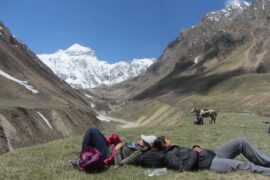
Best Time To Visit Adi Kailash: Unlock the Permit & Registration
Comments are closed.
- Travel News
- Homestay Registration

Satopanth Lake Trek
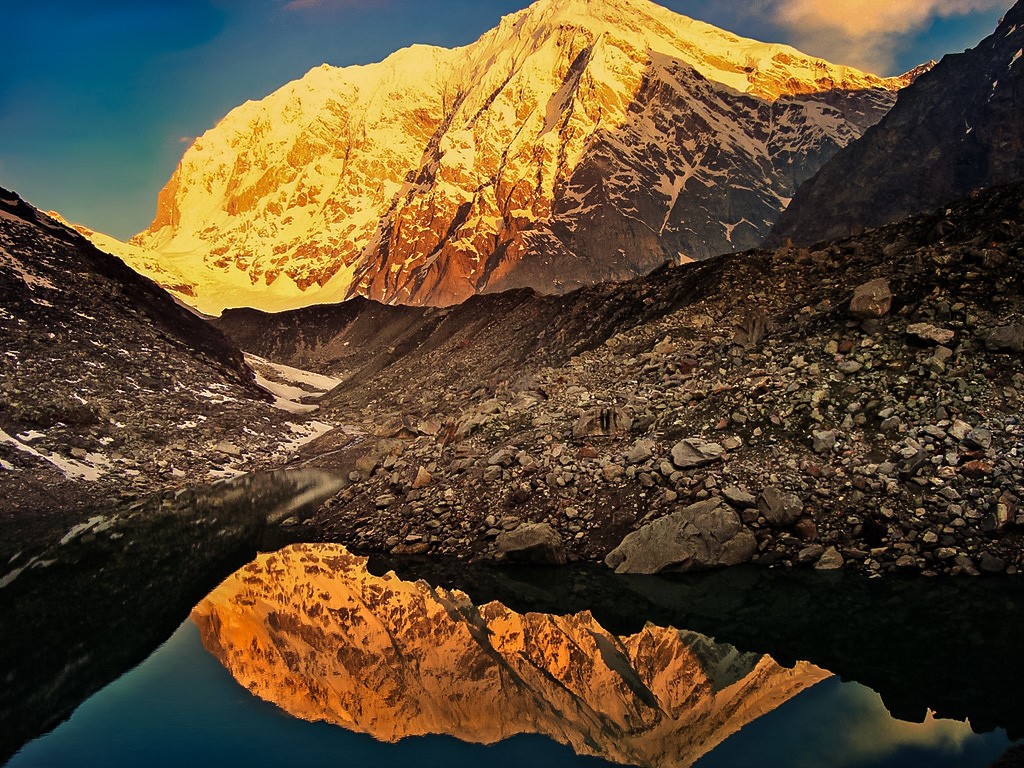
₹ 15,000 / Person
Summer / Autumn Trek Distance: 46 Km Trip Duration: 5 Days Trek Difficulty: Difficult Experience: Advanced Beginner Pickup & Drop: Badrinath
- Description
- Reviews (0)
Batch Availability
14 May – 20 May ( Available )
21 May – 27 May ( Available )
4 June – 10 June ( Available )
11 June – 17 June ( Available )
18 June – 24 June ( Available )
Satopanth Lake Trek is a beautiful trek full of excitement that starts from the Badrinath and goes to the holy Satopanth Lake, the source of the sacred Alaknanda River. As its name suggests, the meaning of ‘Satopanth’ – Sato (meaning: Truth) + Panth (meaning: Way/Path), is “Path of truth”! Satopanth Lake is a beautiful green triangular-shaped lake situated on the banks of Satopanth Glacier, between the east side of the Chaukhamba and the west of the Neelkantha Peaks. Satopanth Lake Trek is considered a very sacred journey in Hinduism.
As per Hindus text, the Trio Lord Brahma, Lord Vishnu, and Lord Shiva did penance on the banks of Satopanth lake. Because of this, the lake holds a sacred and significant place in Hinduism. Apart from this, people believe that one can travel to heaven through this path. After the end of Mahabharata in Dwapar Yuga, Pandavas and Draupadi set out on this route to travel to heaven. Out of which, only Yudhishthira was able to complete this journey successfully.
Satopanth Glacier Trek / Swargarohini Trek / Satopanth Swargarohini trek
Alternatively, Satopanth Lake Trek is also called Satopanth Glacier Trek/Swargarohini Trek/Satopanth Swargarohini trek. The Satopanth Glacier originates from the southeast of the Chaukhamba peak. Near its origin, the glacier looks like stairs, which is called ‘Swargarohini’! Swargarohini is around 5 km ahead of Satopanth Lake.
Surya Kund is a small pond, which lies about one and a half kilometers from Satopanth Lake towards Swargarohini.
Vishnu Kund
Vishnu Kund is 1 kilometer furthermore from the Surya Kund. It is a bit difficult to reach this place and becomes more difficult towards the Swargarohini.
Best Time to Visit Satopanth Lake Trek
May, June, Sept, Oct.
Satopanth Lake Trek Starting point
Badrinath, Chamoli, Uttarakhand, PIN – 246422.
Sort Itinerary
- Chakrateerth
Itinerary for Satopanth Lake Trek
Day 1: Rishikesh To Badrinath - Pickup From Joshimath
- Distance - 294 Km
- Driving Time - 11 Hrs.
- Maximum Altitude - 3124m
For Joshimath, you will get a lot of public transport from Rishikesh Haridwar, and many taxis are also available there for booking. The journey from Rishikesh to Joshimath is about 260 km, which is first on the banks of the river Ganges and then later on the banks of the Alaknanda. The whole journey is full of joy and excitement. There are beautiful mountains, jungles, villages, confluences of rivers on the way. After you reach the Joshimath, we will pick you up for Badrinath from there. Overnight stay will be at Badrinath.
Day 2: Badrinath To Laxmivan
- Distance - 10 Km
- Trekking Time - 6 Hrs.
- Maximum Altitude - 3654m
- Altitude Gain - 530m
Our trekking will start from Badrinath Guest House. After having the darshan of Badrinath Lord, we will proceed towards Laxmi Van. After walking about 3 km from the temple along the banks of river Alaknanda comes Mata Murti Temple, opposite Mana Village. As we proceed from here, the climb starts increasing, and the trail passes through many landslides. After some time, we see the beautiful Vasundhara Falls on the other side of the river.
The climb progresses slowly till the arrival of Samtoli Bugyal. After crossing the Boulder section, we reach the Laxmi Van campsite, where we see Bhojpatra trees on the banks of the river Alaknanda. Today we will rest the night in Laxmi Van. The snout of the Satopanth Glacier and Bhagirathi Glacier is visible from the Laxmi Forest Campsite and in the middle of which the Balakun Mountain attracts attention.
Day 3: Laxmivan To Chakrateerth Via Sahastradhara Waterfall
- Distance - 7 Km
- Trekking Time - 4 Hrs.
- Maximum Altitude - 4216m
- Altitude Gain - 562m
After the start of a beautiful morning, we will proceed towards Chakrateerth Campsite. The trail is more challenging as we ascend towards the Chakrateerth. There are lots of boulders, steep ascents, and many water streams on the way. When we reach Sahastradhara, there are dozens of water streams and small waterfalls falling from the mountain, looks splendid. You can observe many small caves and shepherd huts throughout the trail. One can comfortably stay or go camping in the caves near Sahastradhara. After crossing boulders-filled paths and small glaciers, we reach Chakratirth. From Chakrateerth you can view Neelkanth, Chaukhamba and Balakun peaks.
Day 4: Chakrateerth To Satopanth Lake To Vishnu Kund Then Back
- Distance - 11 Km
- Trekking Time - 7 Hrs.
- Maximum Altitude - 4530m
- Altitude Gain - 314m
Today’s hike is not so steep, and it’s a bit easier to climb today. Also, we will camp at the same site today, so no need to carry extra luggage, carry only essentials with you. Satopanth Lake is only 3 km away from Chakrateerth. You need to cross two small glaciers or ice debris emerging from the west ridge of Nilkantha Parvat to reach Satopanth Lake. After that, we see the triangular Shaped Satopanth Lake. The elevation of Satopanth Lake is around 4350m/14272ft.
The reflection of mount Chaukhamba in the lake is very charming, especially in the morning and evening when the Sun spreads the red spectrum in the sky, as you can see in the trip photo. So plan your trekking accordingly. Do meditation for a while, and you will feel calm and relaxed. The lake of Satopanth is very holy, so do not spread the dirt in the lake or around the lake. Be responsible and keep the Himalayas clean.
We can also proceed to Surya Kund, Vishnu Kund, or Swargarohini to see Chaukhamba and Swargarohini up close. Due to an extreme lack of oxygen and bad trails, trekking further becomes difficult. After that, we will go back to the Chakrateerth campsite.
Day 5: Chakrateerth To Laxmivan
- Trekking Time - 3 Hrs.
- Altitude - 3654m
Now we will descend back to the Laxmivan. The descent will be easy today. You can enjoy yourself at the Sahastradhara waterfall.
Day 6: Laxmivan To Badrinath
- Trekking Time - 5 Hrs.
- Altitude - 3124m
Today we will descend back from the Laxmivan campsite towards Badrinath. From where we will go to the Joshimath via taxi. We will stay at the Joshimath.
Day 7: Badrinath To Rishikesh (Joshimath Drop)
From Joshimath, you get plenty of transportation options for the Rishikesh, Haridwar, and Dehradun. You can choose public transport or book a taxi. It will take around 9-10hr to cover the 260km distance for Joshimath to Rishikesh.
SatopanthTrek Price
₹ 15,000 Inc GST – Badrinath to Badrinath
- Accommodation Hotel/ Guesthouse/ Tents
- Meals as per itinerary
- Safety Equipment (oxygen cylinder, first ad...)
- Tour Guide.
- Trekking Gears like Crampons, Gaiters (When needed).
- Forest entry charges, permits & camping fee.
- Necessary Permit
- Porter/Mule charges for carrying personal luggage.
- Any costs arising out of unforeseen circumstances like landslides, roadblocks, bad. Weather, etc.
- Trekking Gears like poles, shoes, poncho etc.
- Travel Insurance.
Things to carry
- Waterproof Trekking Shoes
- Woolen/Cotton Socks (Thick) - 3-4 Pairs
- Woolen sweater ( warm & Light )
- Jacket/Windcheater
- Trek Pants/Lower - 2 units
- Thermal wears - 2 pairs
- Full Cotton T-shirts - 2-3 units
- Inner wears - 2-3 Pairs
- Warm woolen shawl ( Thin & Light )
- Water Proof Rucksack ( 30-60 liter )
- Rain coat/Poncho
- Rain cover for your bag
- Portable Tourch/Headlamp
- Water Bottle
- Winter Moisturizer Cream
- Sunscreen Lotion
- First Ad Kit ( ORS, AMS tablets, Band Ad, Pain Relief Spray, Coldarin, etc.)
Satopanth Trek Map
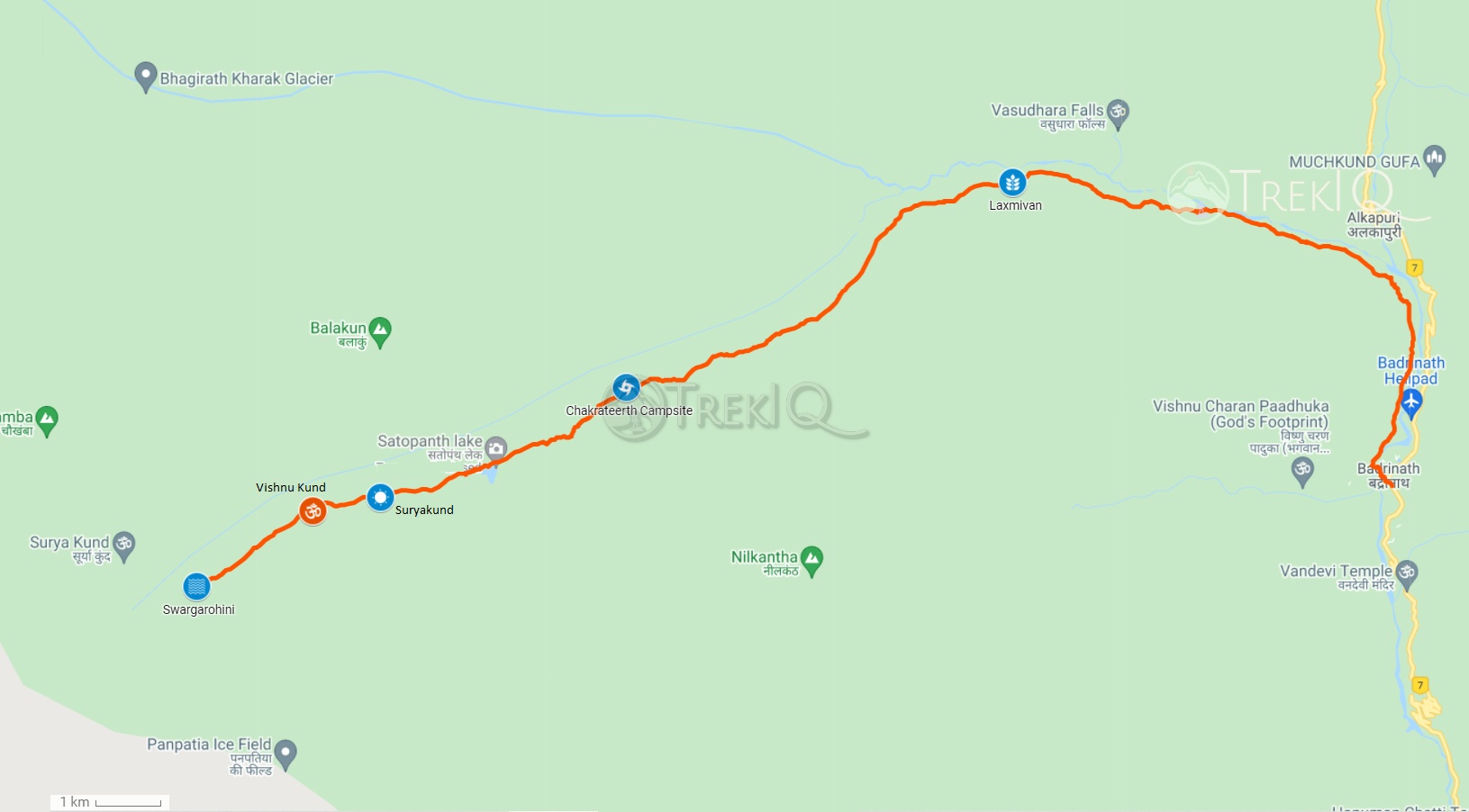
Satopanth Lake Trek FAQs
According to Hindu legends and mythology, Tridev(Supreme Gods), Brahma, Vishnu, and Mahesh (Lord Shiva) had meditated at the three corners of this lake. In Hindu belief, it is auspicious to take a bath in the Saptopanth lake on the 11th day (Ekadashi) of the Sun and Moon Paksha. People believe that the Trimurti takes a holy dip in the Satopanth lake’s waters during every Ekadashi. Locals believe that some unique birds around the Satopanth lake keep this lake clean, and these birds are sacred Gandharvas who keep the lake away from all dirt and evils.
According to the Mahabharata, Pandavas went to heaven from the Swargarohini(Stairway to Heaven). Only Yudhishthira had succeeded in going to heaven through Swargarohini. People believe that Pandavas went on a journey to heaven from this path only.
The ‘Satopanth’ consists of two words: ‘Sato’ (meaning: Truth) + ‘Panth’ (meaning: Way/Path). which combined meaning is “Path of truth”!
The location of Satopanth Lake is in the Chamoli district of Uttarakhand, near Mana Village.
The nearest bus stop and taxi stand are in Badrinath. You can reach Badrinath from Rishikesh, Haridwar, and Dehradun via public transport, private vehicles, and taxies. You can reach Rishikesh, Haridwar, and Dehradun via trains and buses from other states. There is also an airport in Jollygrand Dehradun, which connects with the metro cities of India.
Months of May-June and September-October are the best to visit Satopanth Lake Trek.
Yes! You must have some experience above the 3000m trek. You need to be physically fit before attempting the Satopanth Lake trek.
We have placed the Satopanth Lake trek at a difficulty level of 2. In this trek, one has to cross many landslides, boulders, and small glaciers. Apart from this, the high altitude and low oxygen level make this trek difficult.
The total trek length of the Satopanth Lake Trek is between 40-50 km. It varies accordingly with the trekking points you cover. If you trek only up to Satopanth Lake, then it will be around 40km trek. If you go beyond the lake, it will be up to 50 km or 50+ km trek.
You need 4-5 days to complete Satopanth Lake Trek from Badrinath to Badrinath.
Absolutely can be. Badrinath, our base camp, has an altitude of more than 3100 meters above sea level. While going to an elevation of more than 3000 meters increases the chances of getting AMS. As we proceed towards Satopanth lake, the altitude reaches up to 4400 meters. Therefore high chances of occurring of AMS.
Acclimatization is the process in which an individual organism adjusts to a change in its environment, allowing it to maintain performance across a range of environmental conditions. Acclimatization occurs in a short period and within the organism’s lifetime. Wikipedia
We can observe acclimatization when traveling to high-altitude locations, such as tall mountains. For instance, if an individual hikes to 3,000 meters above sea level and stays there for 1-3 days, they become acclimatized to 3,000 meters. If the same person hikes to 4000 meters in altitude, their body has to acclimatize once again. Some of the changes that take place during acclimatization to high altitudes involve:
- Increased production of Red blood cells.
- Increased pressure in pulmonary arteries – thereby forcing blood into sections of the lungs that are usually not used during normal breathing at lower altitudes.
- Increased depth of respiration.
- Increased depth (volume) of breath.
Source: Byjus.
In some cases, individuals suffer from Acute Mountain Sickness when ascending to elevations of over 3,000 meters from sea level. However, it is a common and mild condition. If the body gets enough time, then it can be overcome. It happens due to reduced air pressure at high altitudes as well as lower oxygen levels. One of the more severe forms of mountain sickness is called High Altitude Cerebral Edema, where fluid builds up in the brain. It is a life-threatening situation and requires immediate medical attention.
Satopanth Lake Facts
Latitude & Longitude
30.743474°N 79.357369°E
Max Altitude
4350 m / 14272ft
Total trek distance
Difficulty Level
Trip Duration
7 Days 6 Nights
Pickup & Drop
Rishikesh/Joshimath
Essential facts
Nearest Medical Facility
Nearest Hospital
Nearest ATM
Mobile Connectivity
Last Electricity
Nearest Bus Station
Nearest Railway Station
Nearest Airport
- Like Us On Facebook
- Follow Us On instagram
Satopanth Lake Trek Reviews
There are no reviews yet.
You must be logged in to post a review.
Similar Treks..
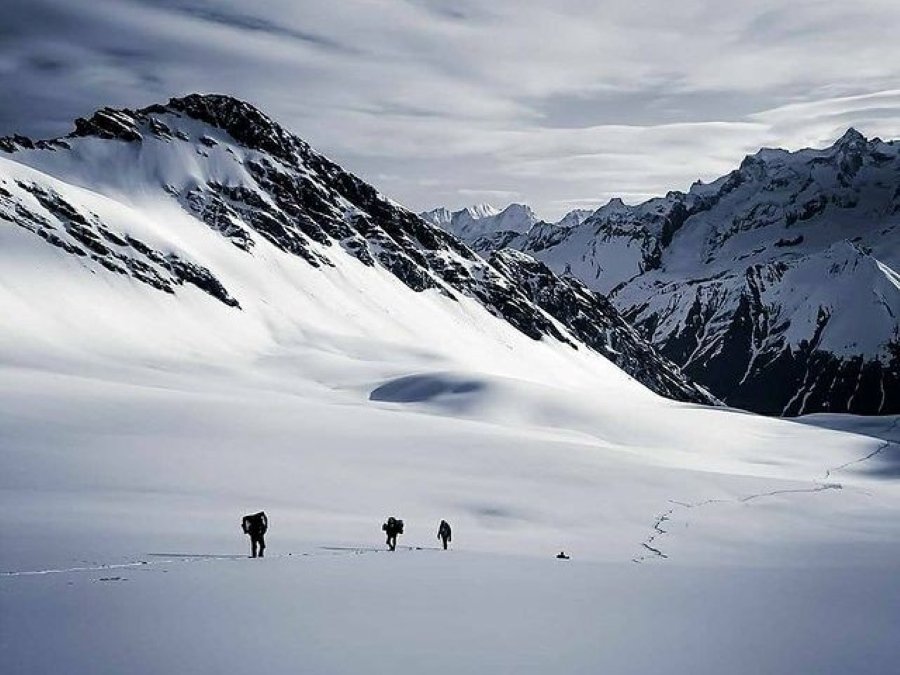
- Rated 5.00 out of 5
Bali Pass Trek
- ₹ 18,500 ₹ 16,500 / Person
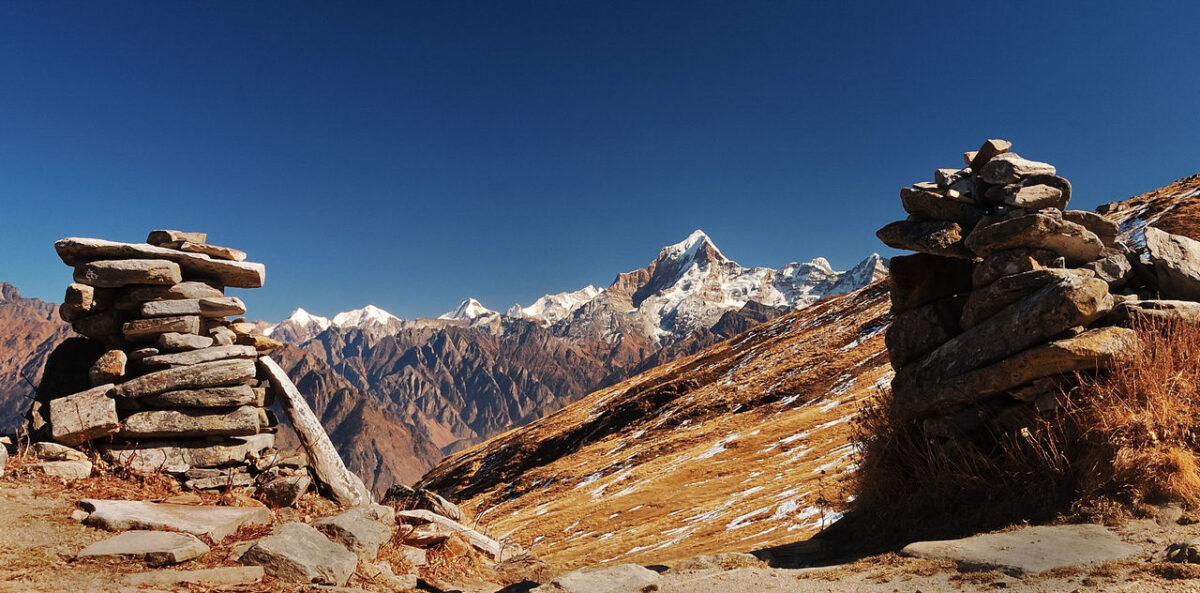
- Rated 0 out of 5
Kuari Pass Trek
- ₹ 8,500 / Person
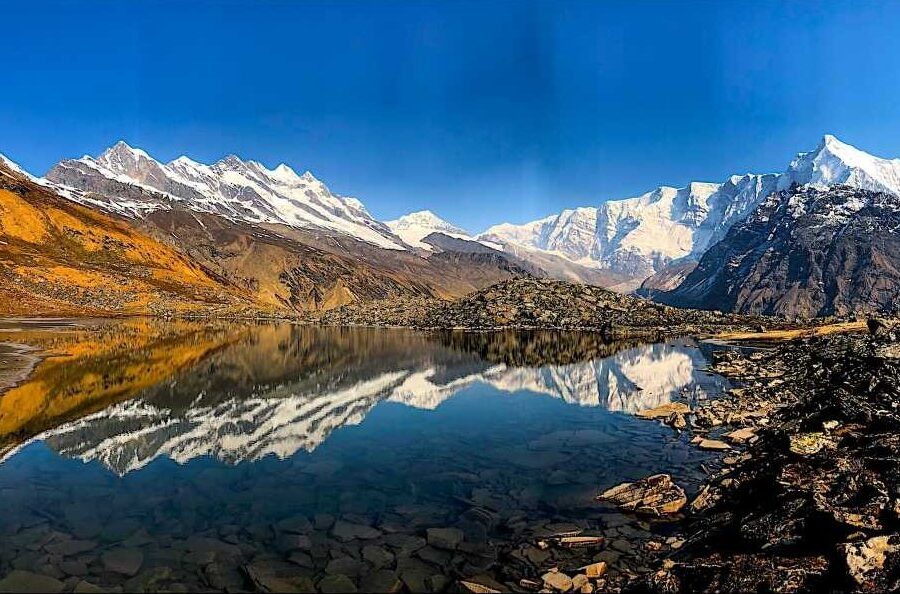
Nagkund Kanakata Pass Trek
- ₹ 14,500 / Person

- [email protected]
- 11 Am - 7 pm (Mon - Sat)
- Events By Difficulty
- Challenging Treks
- Events by Experience
- advanced beginner
- experienced
- Mountaineer
- Events by activity
- Events By Month
- privacy policy
- Cancellation & Discount
- Terms & Conditions
- Disciplinary Action Policy
- Homestay Policy & Terms
Drag and Drop (or) Choose Files
Request For a Trek
Click here to open in full Page
Group Size min 4* 4 5 6 7 8 9 10 11 12 13 14 15 More Than 15 Send Message
—————————————————————-
Request For A New Trek
Click here to open in full Page
—————————————————————————————-
Click here to open in full Page
0 / 180 Send Message Please do not fill in this field. Please do not fill in this field. Please do not fill in this field. Please do not fill in this field.
———————————————————————-
Subscribe Our Newsletter
Available Coupons !
There are no Coupons available right now.
Please refer to the discount and coupon policy before using coupons . While processing payment means you have a discount and coupon policy.
Up to 20% extra discount for groups
Directly applicable while checkout
Table of Contents

Home » Shop » Satopanth Tal Trek
- getting there
- Detailed itinerary
- cost inclusions
- cancellations
- Submit to know our Satopanth Tal trek details
- 1 Week trek
- Garhwal Treks
- Moderate Grade Treks in Himalayas
- Summer Treks
- Uttarakhand
Satopanth Tal Trek:
Upcoming summer Satopanth tal trek starting on 26th May 2024 at Badrinath on Day 1 as per the given itinerary.
The mythical lake trek route to Satopanth Tal encompasses the flavor of high altitude feature, walking on boulder, moraine, glacier and knife edge ridge are enthralling. Captivating peak views are hard to believe. This triangular shaped glacial lake lies above 14000 ft, hidden inside the ridge believed to be the “the road to truth” (Satya ki pantha or path) .

The Panch Pandavas of epic Mahabharata took this difficult trail to try to reach the heaven. At different places on the trail, the legends still live, and the names bear the resemblance of the myth. Towering Chaukhamba ridge looms over the lake along with the Neelkanth, Balakun, Parvati and other peaks. Many people believe that the Trimoortis, Brahma, Vishnu and Maheshswar, take bathe in the lake in an auspicious day. Adventurous devotees and Sadhus visit this lake in the monsoon for pilgrimage.
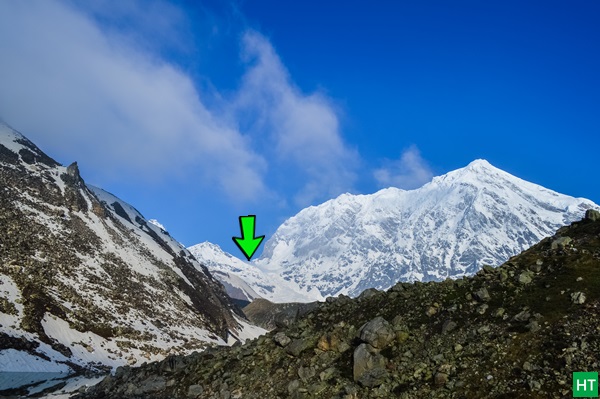
This trail is a classy example of glacier moraine walk on boulders, loose rock and scree zones to the core of the Himalayas and NOT recommended for the beginners . Trekkers must be having prior high altitude multi day trekking experiences.
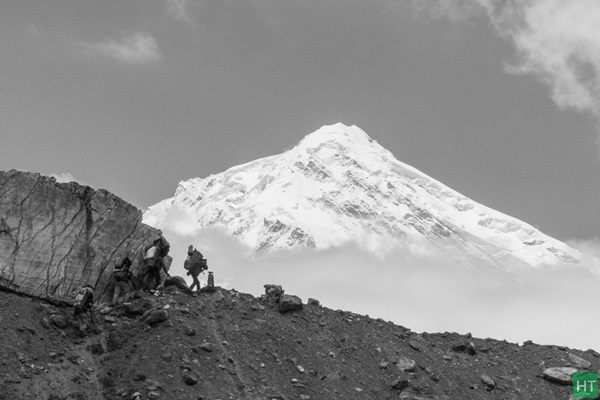
After crossing Alaknanda at Mana the trail till Laxmivan is relatively easy and like the usual trekking trails. The trail on the opposite side of the river goes to Vasudhara falls. Campsite of Laxmivan is located on a patch of grass and perhaps the campsites are the only shades of green from now on.
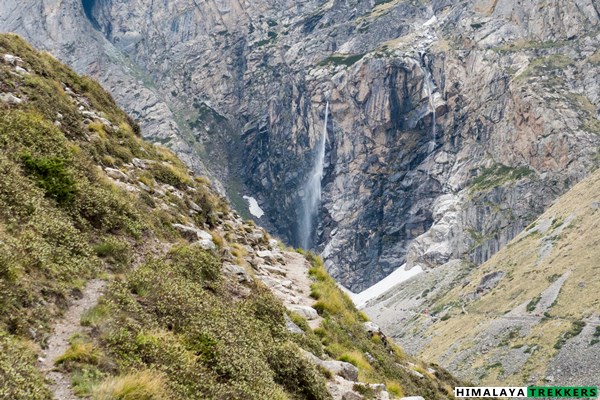
Brief Itinerary for Satopanth trek:
Day 1: Drive from Rishikesh to Badrinath – 290 Km – 11 to 12 hours. Accommodation and meals on your own (NOT included in the TREK FEE). Day 2: Meet your trek guide and briefing. Active Acclimatisation at Badrinath – Walk towards Charan Paduka or Mana etc, in the afternoon you may visit the holy temple. Accommodation and meals on your own. Day 3: Trek from Badrinath to Laxmivan – 10 km – 6 hours. Camp on a twin sharing basis. Day 4: Trek to Chakratirtha – 9 Km – 5 to 6 hours. Camp Day 5: Trek to Satopanth Tal – 5 Km – 3 hours – spend an hour or so and return to Chakratirtha – Total 10 Km – 8 hours. Camp Day 6: Trek from Chakratirtha to Mana – 15 Km – 6 to 7 hours – Walk or drive to Badrinath 3 Km – 1 hour or so. Accommodation and meals on your own . Day 7: Drive from Badrinath to Rishikesh – 290 Km – 1 1o 11 hours. Dehradun airport (DED, Jolly Grant or haridwar railway station is an hour’s drive from Rishikesh.
Important Note:
- You need to reach on their own to Rishikesh on Day 1 morning (by 6 am) or the previous night. Return to Rishikesh on Day 7 evening (by 8 pm). Arrange your tickets for inward journey and return from Rishikesh accordingly.
- TREK FEE ₹ 15,950 + 5% GST per person is excluding Badrinath and includes everything for the trek to Satopanth and back, i.e. 4 days of trekking.
- For further acclimatisation you may reach Joshimath on Day 0 and then move to Badrinath next day, i.e. Day 1 of our itinerary.
Satopanth Tal trek route and the legend:
We are purely trek organisers and run this trek once or twice in a year for interested and experienced Himalayan hikers.This typical glacial moraine trail into the core of the Himalayas is indeed a delight to any trekker. At the same time 50 Km round trip from Badrinath is tricky in many aspects. It is a full camping style porter run (no horses/mules) trek and there is nowhere you get any food or shelter. This glacier valley is typically low in oxygen and trekkers must get acclimatised once reaching Chakratirtha. If not, there is noway but to return. You need to negotiate boulder zones, moraine debris and scree zones before reaching Satopanth Tal.
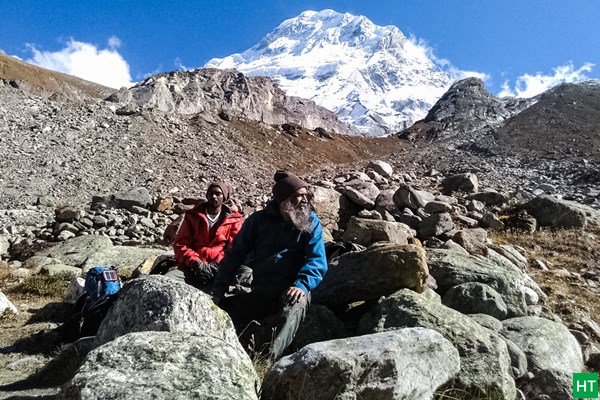
We often get requests from people wishing for Satopanth and Swargarohini Yatra . This must be taken as a high altitude Himalayan trek and the pilgrims must have prior trekking experiences like Kailash, Adi Kailash, Manimahesh, Kinnaur Kailash circuit, Srikhand Mahadev or similar, preferably all. Swargarohini area is out of scope of this trek as that is a mountaineering pursuit. On a clear day one can see clearly the legendary Swargarohini steps from Satopanth Tal and its surrounding. Here is how it looks from Satopanth on a clear day.
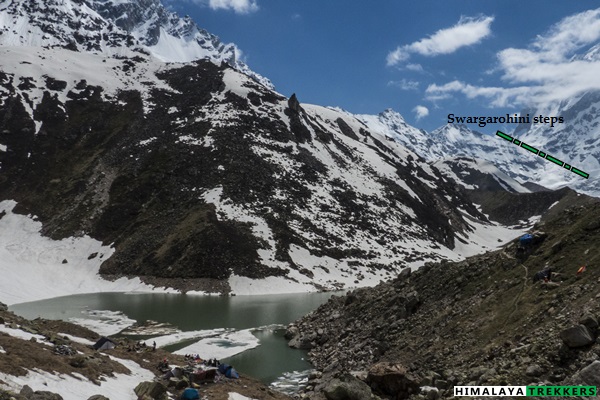
Camping restricted at Satopanth Tal (with effect from Sep 2018):
As per Uttarakhand High Court order (Petition No. : 123/2014 ) , one can not camp on alpine and sub-alpine meadows/grasslands, locally called “Bugyal”. Therefore forest department has revoked the permit to camp at the lake, i.e. Satopanth Tal. Starting from Sep 2018, our highest camp is at Chakratirtha and we visit Satopanth and return to same camp.
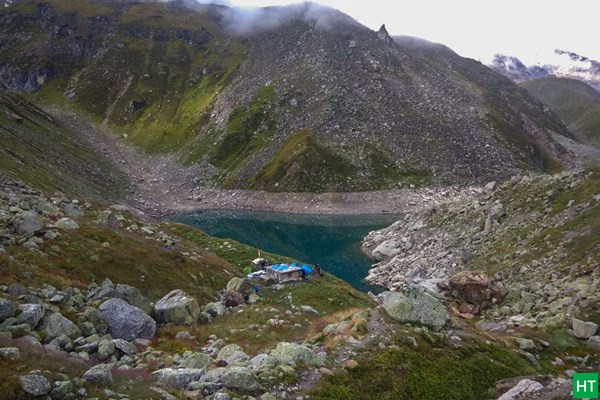
Access to Satopanth trek base – Badrinath:
To reach the trek base Badrinath you need to reach Haridwar on your own arrangements. Haridwar is well connected by train from Delhi and Kolkata. Frequent regular and Volvo bus service from Delhi Kashmiri Gate ISBT.
Based upon trekkers request we may arrange a pickup from Haridwar railway station to Badrinath and back. This will be shared equally by the availing team members on actual basis and paid directly to the driver. The fare is ₹ 8000 for a Tata Sumo/Mahindra Maxx one way. This can accommodate 5 to 6 people. A Tempo Traveller charges ₹ 12000 (12-13 seat) one way. This is NOT included in TREK FEE.
You can reach Badrinath by bus which start very early morning from Haridwar, latest by 4:30/5 am. Its a long journey and may take up to 13/14 hours.
To reach the trek base Badrinath independently/public transportation check the details in GETTING THERE TAB.
Click here to check the List of things to carry in Satopanth Tal trek or Download the PDF list.
Duration: 4 days of trekking from Badrinath to Satopanth Tal and return. Haridwar to Haridwar in 7 days.
Prerequisite: Prior high altitude trekking experiences are must. At least 2 Moderate grade treks are highly recommended.
Grade: Moderate
Physicality: 7/10
Trail Length: 50 Km
Highest Point: Satopanth Tal ~ 4400 m/14430 ft
Seasons: June & August/September
Access: Trek starting point (trek base) is Badrinath, 310 Km from Haridwar
Rail station: Haridwar (Station Code: HW)
Airport: Delhi, Jolly Grant in Dehradun (Airport Code: DED)
Upcoming scheduled dates for Satopanth Tal trek:
- You can check the scheduled Fixed Departure dates in the calendar available inside Booking Form or inside REGISTER NOW form. Tour starting Dates are highlighted as per our itinerary ( Day 1 of 8 days itinerary ).
- At present BOOK NOW functionality is disabled . You can get all the information in your email by submitting the REGISTER NOW form.
- If you are a group of people and available dates are not matching then you may select Custom date mode (by clicking the Select your custom date) and fill in the displayed form.
- You can also check all the available dates at a glance in our TREK CALENDAR .
- Trekkers need to reach Haridwar on Day 1 morning (latest by 6 am) or the previous night. Return to Haridwar on Day 8 evening (around 8/9 pm). Arrange your tickets for inward journey and return accordingly.
Access to Badrinath (The trek base): Haridwar is well connected by train from Delhi and Kolkata. Frequent regular and Volvo bus service from Delhi Kashimiri Gate ISBT.
To reach the trek base Badrinath you need to reach Haridwar by your own arrangements.
We will arrange a pickup from Haridwar to Badrinath and back. The cost will be shared equally by the team members and is approximately around 7000 Rs one side in a Jeep (Mahindra Maxx, Sumo). One such Jeep is comfortable for 6-8 persons.
If you want to reach and return from Badrinath by public vehicle then:
1) Take early morning bus service from Haridwar to directly Badrinath or till Joshimath. Direct buses leave by 5 am. The state operated Bus terminus (referred as Roadways) is just opposite to the Haridwar railway station. Privately operated buses start just 2 minutes walking from here. In the summer during Char Dham Yatra, buses are packed. It takes 11/12 hours to reach Joshimath. Look for a shared Jeep service or book a car till Badrinath. It may take up to 14 hours.
2) From Badrinath early in the morning board the direct bus for Haridwar/Rishikesh. It will take 12 hours. From Rishikesh, it is only 25 Km journey to Haridwar by frequent bus service.
There are direct trains from Kolkata to Haridwar.
KUMBHA EXPRESS – Train No. – 12369 ( Very good option to reach Haridwar by 5 pm; Spend the night in Haridwar and start your onward journey by car next morning)
UPASANA EXPRESS – Train No. – 12327 ( Very good option to reach Haridwar by 5 pm; Spend the night in Haridwar and start your onward journey by car next morning)
DOON EXPRESS – Train No. – 13009 ( Don’t book this train when you plan a long onward journey immediately in the morning)]
Avoid booking wait listed (WL) tickets in AC classes (1A/2A/3A) or Chair Car (CC). Book Sleeper class (SL)/Second Sitting class (2S) tickets which have normally more seats/berth and hence much better chance to get confirmed.
Following trains are good to reach Haridwar and run daily.
DDN JANSHTBDI – Train No. 12055 (Arrives HW in the evening @ 7:30 pm, good choice when you stay the night in Haridwar and have a long drive ahead next day) NANDA DEVI EXP – Train No. 12205 (arrives HW early morning @ 4am) UTKAL EXPRESS – Train No. 18477 (arrives HW in the night @ 9pm) MUSSOORIE EXP – Train No. 14041 (arrives HW in the morning @ 5:45am) Always avoid booking waitlisted (WL) tickets in AC classes (1A/2A/3A) or Chair Car (CC). Book Sleeper class (SL)/Second Sitting class (2S) tickets which have normally more seats/berth and hence much better chance to get confirmed.
Govt. Road Transport (Roadways of Uttarakhand, Uttar Pradesh, Delhi, Haryana, Punjab etc.) buses are frequently available in day time and night from Kashmiri Gate ISBT ( http://www.delhi.gov.in/wps/wcm/connect/doit_transport/Transport/Home/ISBT/Fare+Chart ). Tickets are available on board for these regular type buses. From Delhi Airport or Station you can reach ISBT Kashmiri Gate via Delhi Metro service ( http://www.delhimetrorail.com/metro-fares.aspx ). It is only 4 Km from NDLS and can be reached easily by booking an auto rickshaw.
For privately operated bus, you can book online from different portals ( http://www.redbus.in ). Select a boarding point suitably. Overnight Volvo/A.C/Push back bus service.
For night stay in Haridwar:
Trekkers reaching on the previous day before the journey to the actual trek base need to stay the night in Haridwar. There are several options in Haridwar for spending a night while staying in Premium, Standard or Budget accommodation. Options vary from Privately operated Hotels/Lodges, to State run Tourist rest House and Dharamshalas.
State run GMVN (Garhwal Mandal Vikas Nigam) operates Hotel Rahi just beside the Bus Stand and opposite to the Haridwar Railway Station. This is a reliable and a decent choice for Standard accommodation. Check the following for online booking of the above: http://www.gmvnl.com/newgmvn/tour/booktrh.asp You can call or visit GMVN nearest office or even send an email for more information.The information is available at: http://www.gmvnl.com/newgmvn/online_reservation/#
Normally you reach Haridwar from any trek base by 7/8 pm in the evening. You can take any train after 9 pm or regular bus service as mentioned above to reach Delhi or directly to your homeward journey in the same night.
Drive from Haridwar to Badrinath – 310 km – 12 hours
You must reach Haridwar by 5 am latest or you can reach the previous evening/night. This is possibly one of the longest journeys in a day on the mountain. From the plains of Haridwar to the the holy shrine of Badrinath at 3000 m/10000 ft. The road (NH 58) follows initially the valley of River Ganga, and later for a major section beside its main tributary Alaknanda. On route we cross Rishikesh and then the confluence at Deoprayag, Rudraprayag, Karnaprayag, Nandaprayag to reach Joshimath. From here Badrinath is another 45 Km. Total distance is 310 Km and can take around 13/14 hours. Night stay at lodge/rest house.
Note: Trekkers having an extra day and willing to spend on the mountain are advised to reach till Joshimath on first day. Next day after lunch you can reach Badrinath in 2/3 hours drive (by bus or reserved car). In Joshimath town you may visit Shri Shankracharya Math, Bhavishya Kedar & Narsing temple or a car trip to Auli, (14 Km, 45 mins drive) or a ride in Auli Rope way. So it is better to stretch this journey in 9 days instead 8 days as this one.
Active Acclimatisation at Badrinath
After a much needed sleep today visit the Badrinath temple in the morning at your will. After lunch we will walk either to Mana Village or to Charan Paduka area for an acclimatisation walk. This is pretty much a must at Badrinath which is already a place devoid of visible tree and having an oxygen level of only 70% that of sea level. Mana village is only 3 Km away from Badrinath. This is a small settlement of Tibetan/Bhutia/Bhote people and settled here for ages. People stay here only in summer and monsoon. From fall they start their downward movement to lower areas. At Mana you will find a SBI ATM welcoming that we are at the last ATM in the Indian side. At Bhim Pul you can see Saraswati river gushing down carving the rocks and disappearing inside a cave. However you can see clearly this stream meets Alaknanda just after a while.
Trek to Laxmivan – 9 Km – 5/6 hours
Today morning after breakfast we start our 5 days trek to Satopanth and back. We will follow the Alaknanda river and will keep the river on our right (true right of the river). In June it is possible to cross the river at Mana as the snow bridge after Mana normally remains good and intact. In post monsoon you will cross the river at Badrinath temple bridge and turn left to take the concrete track for few kilometres. The trail is a gentle uphill following Alaknanda. Walking around 3 hours we reach a flattened ground called Chamtoli Bugyal. Myriads of tiny wildflowers bloom during summer and monsoon in this valley. Vasudhara falls is just opposite to this on the other side of river. From here it is another hour to our camping ground called Laxmivan (~ 3650 m/11650 ft). Total distance is 9 Km and may take 6 hours. Though called a “Van”(Forest in Hindi), this place is only a patch of green grass on the trail. Draupadi of Mahabharata supposed to breath her last here. From this ground the views are simply breath taking, in fact in all our next camping grounds. If you look directly north, you will notice that two glacial valleys connecting ahead. the right is the Alkapuri valley, the source of the river Alaknanda. This is also said to be the abode of Kuber, Yakshas and Gandharvas. The fluted peak called Shri Parvat is at the head of the valley and is mesmerising during the sunrise from this camp. Looking back you can see the Mana peak towering above Mana area. The valley which turned right is the one towards Satopanth Tal and we will follow tomorrow. On the other side of the river you can see the much famed Vasudhara waterfalls. Tent accommodation for the night.
Trek to Chakratirtha – 11 Km – 6/7 hours
Today we trek to Chakratirtha another 11 Km ahead towards Satopanth Tal. Initial 2 km is an easy walk till Bandhar from where the valleys bifurcate. This area has quite a few Rhododendron bushes flowering late in May. From here the terrain changes to typical glacial moraine covered with boulders and rocks. On our left locate a single standalone rock pillar named Bhim Gada. We cross the stream in a suitable place and continue to walk on the moraine ridge. After continuing for couple of hours we reach Sahastradhara, where numerous waterfalls cascading down the mountains on the left. As per legend brother twins Nakula and Sahadeva died around this place. Crossing the area we climb on moraine ridge and continue for another two hours to reach another patch of green, beautiful camping ground called Chakratirtha (~ 3950 m/12750 m). The way may take 6/7 hours. The view of Mount Neelkanth from this campsite produces a different angle and face of this iconic mountain. Lord Arjuna died at this holy place. We camp for the night.
Trek to Satopanth Tal – 5 Km – 4/5 hours – In the afternoon walk around the lake
After breakfast we start our today’s trek to Satopanth Tal. Leaving behind our camping area we climb on a steep section to reach the shoulder of a ridge. From here the view unfurls and Chaukhamba massif marks the end of this valley ahead. The terrain becomes rough, full of scree, moraine and debris. We continue our climb and slowly gain altitude while crossing smaller ridges hiking up and down. Though the distance is short but the journey is tiring. Finally we climb a ridge and the turquoise lake is seen in the depression. The shape of the lake is like a “Boomerang”, two arms spreading on the opposite sides. We camp on a suitable place around the Satopanth Tal (~4400 m/14430 ft). It may take 5 hours to cover the 5 Km distance. There is a small temple of Lord Shiva and Parvati is on the left arm and a small hut is constructed on the right arm, where a Sadhu resides in summer and monsoon.
Trek from Satopanth Tal to Bandhar – 14 Km – 6/7 hours
Wake up early in the morning to witness the magnificent sunrise and the reflection of Chaukhamba peak on Satopanth Tal. Legendary Swargarohini steps on the left side of the Chaukhamba massif is clearly visible on a clear day. Bhim couldn’t go any further and Yudhisthira continued alone to heaven following the Swargarohini. After breakfast our descent starts and we trace back our trail to Bandhar, 14 Km via Chakratirtha and Shahastradhara. The walk can take 6/7 hours. Camp for the night.
Trek back to Badrinath – 11 Km – 6 hours
We return to Badrinath via Laxmivan and Chamtoli. 11 Km distance may take 5/6 hours. Night accommodation in lodge.
Drive from Badrinath to Haridwar – 310 Km – 12 hours
Today morning we start our long journey back to Haridwar. We reach Haridwar by 8/9 pm in the evening. Trip ends here.
P.S.: Distances and altitudes are approximate and may not be exact.
TREK FEE: ₹ 15950 (Ex Badrinath to Badrinath, trek only) + 5% GST
The above TREK FEE doesn’t include stay or meals in Badrinath.
Inclusions:
Twin sharing tent accommodation during the trek.
All meals during the trek (Day 3 lunch to Day 6 lunch) . Regular Indian style nutritious vegetarian food during the trek, breakfast packed or hot lunch (depending upon the time you reach a campsite), light snacks, dinner along with morning and evening tea.
Excellent Trekking Guide, who will be a local to this particular area and has profound knowledge of the trekking trails around.
Specialised Cook, Support staff, Porters for carrying the central logistics of the trek.
Camping equipment like Sleeping bag, Carry mattress, Gaiters, Micro spikes/Crampon. (Bring your own sleeping bag, if you have a high altitude specific personal one. This is always better for hygienic reasons.)
Kitchen tent, dining tent and toilet tent as required during the trek.
All permit fees, camping charges, forest levy required for the trek.
Basic Medical & First Aid kit.
Medical cum Travel Insurance Policy covering high altitude trekking tours (For Indian nationals it is included in the TREK FEE, up to 60 years of age). It covers your trek as well as your return journey for a maximum duration of 7 days.
Exclusions:
Transportation from Rishikesh to Badrinath and back. We can arrange the same and trekkers need to pay directly to the driver sharing equally on actual basis.
Any accommodation or meal in Badrinath . There are plenty of options for vegetarian food at Badrinath along with budget and standard accommodation choices.
We assume that you will carry your personal Rucksack/Backpack with all your personal belongings. If you want to offload your Rucksack and be carried by a Porter, then you need to pay additional ₹ 4000 for the entire duration of the trek. The rucksack must not weigh more than 10 Kg.
Any tip or gratuity to the HT support staff.
Anything that is NOT mentioned in the “Inclusions” or personal in nature.
- We assume that you have read and understood our “Terms & Conditions” ( https://himalayatrekker.com/terms-and-conditions ) before Booking a trek/tour.
- To reserve your place in a scheduled Fixed Departure trek or a Customised/Private trek pay 25% of the TREK/TOUR FEE as the initial “Booking Deposit” . You can pay by Net banking/Draft/Cheque/Credit/Debit/AMEX cards. This will ensure your participation in the desired trek and we will reserve your place in the scheduled date. You need to pay the remaining amount at least 15 days before Trek Starting Date .
- If you book a Trek/Tour before 14 days or less from Trek/Tour Starting Date, you need to pay the full TREK/TOUR FEE .
Cancellations:
- “Booking Amount” i.e. 25% of the TREK/TOUR FEE is Non-Refundable at any stage.
- If in case you are not able to make it due to unavoidable reason(s), we provide you a very flexible choice of Shifting to another trek within next one year . One year is counted from the starting date of the trek/tour you booked initially with us.
- In case you postpone your trip you need to inform minimum of 15 days before the trek/tour starting date. (Though we suggest to inform us earlier if known)
- In case you postpone a trek/tour before 15 days of the scheduled Trek/Tour Starting date or prior , you may shift to another group of the same trek/tour scheduled in the same season or within next one year. You may shift to another suitable route also. For changing any, you need our approval first. Your request must be in written communication through your registered email with us.
- If you cancel/postpone a trek/tour from 14 days to 8 days before tour starting date , your Booking Amount is Non-Refundable. We will not take any request of shifting dates. We will charge 50% of the amount as Cancellation Charges and process refund of remaining 50%. You may also shift to another group within next year but 25% Booking Amount will be deemed as Cancellation Charge and the rest amount will be transferred to the shifted group.
- If you cancel a trek/tour 7 days (i.e. a week) before Trek/Tour Starting Date or later , there will be NO REFUND.
- In case of any unforeseen incident including but not limited to natural calamities like flood, earthquake, landslide, forest fire or any political unrest, if we are compelled to cancel the trek/trip, you will be entitled to redeem the full amount for the same/similar kind of trek/trip within next one year.
If you need more clarifications write in to [email protected]
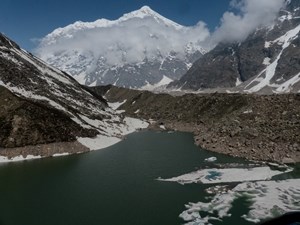
Tour Reviews
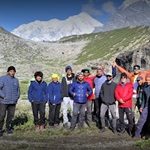
Very well organised and skilled staff to take care of all the different aspects of the trek. Not only they help to make it a memorable experience but also they help you with preparation/booking/shopping so that you won’t feel lost.
Leave a Review
Cancel reply.
You must be logged in to post a comment.
You May Also Like
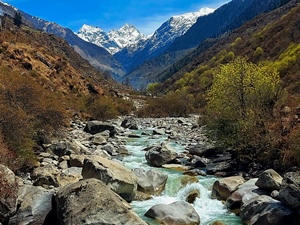
Har Ki Dun Homestay Trek
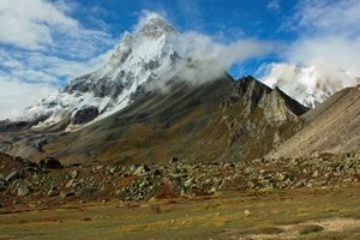
Tapovan Trek
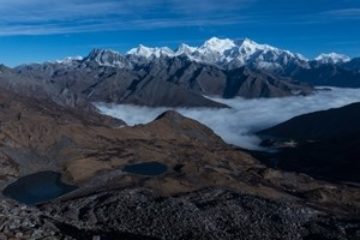
Dafeybhir Trek
Submit this form that we can email you all the necessary details and call you to discuss., tour starting date: green boxed dates indicate starting of a scheduled fixed departure tour (day 1 of our tour itinerary). please check the calendar and choose a suitable fixed departure date (green boxed) unless dates are not matching or you are looking for a customised/private trip., i accept the terms & conditions.

IMAGES
VIDEO
COMMENTS
Satopanth Tal Trek- An adventure to explore the Pristine Glacial Lake. 1st September 2021 Shikhar Travels Trekking in India. An untouched Glacier Lake, Satopanth Tal is a triangle-shaped hidden treasure amidst the magnificent Garhwal region. The destination happens to be an impeccable religious site for the locals and is believed that the three ...
Short Itinerary of Satopanth Tal -. Day 1- Drive from Dehradun to Joshimath Altitude - Joshimath by taxi (256 Km) (10/11 Hours) (1,875 m/ 6152 feet) Day 2- Drive from Joshimath to Badrinath by taxi (48 km) (2/3 Hours) Reach hotel need proper acclimatization. Day 3- Trek from Badrinath to Laxmivan (08 km) (4/5 Hours) (12,510 feet)
Day 4: Chakrateertha to Satopanth and back - Trek for 8 hours (10km) - 15,100 ft. This day's trek starts off on a flat and easy gradient but takes off towards the end. Boulders and moraines trace your path towards the top of the ridge from where you get the first glimpse of the pristine lake.
Here are the detailed points about the best time to visit Satopanth Tal: Weather: Summer is considered the prime trekking season. The weather is generally pleasant during the day, with temperatures ranging from 10°C to 15°C (50°F to 59°F). Nights can still be quite chilly, dropping to around 0°C to 5°C (32°F to 41°F).
From here I started on my feet toward the formerly introduced Vasudhara Falls. Finally, my first-ever trek began on Day 2 Satopanth lake trek itinerary. To my surprise, I had not even completed 1 kilometer of my trek and I witnessed the first wonder of trek journey, The Bheem Bridge. The name must-have clarified who build the bridge.
The Satopanth Tal trek is of the moderate-Difficult level. You start at an altitude of 10,830 feet and reach an altitude of 15,100 feet in 3 days. Ideally, you should be only gaining 1000 ft a day. However, the Indian Himalayas climb very quickly.
Trek to Satopanth Tal: A high altitude alpine lake. Amidst the snow clad mountains and sun kissed meadows, Satopanth Tal, located at 4,400 metres above the sea level, requires 6 nights and 7 days in hand. You can choose oceans over mountains if you would like to, but there is no way that a high-altitude alpine lake with significance in Hindu ...
Satopanth Tal - Swargarohini Trek. Satopanth Tal is located in the midst of snow-capped peaks at an altitude 15,000 feet above sea level. One has to trek 22 km from mana village to reach the lake. The lake remains under the snow from the end of October to the middle of May or sometimes till end of June.
The Satopanth Tal Trek is a soul-stirring pilgrimage into the sacred landscapes of the Garhwal Himalayas, where pristine glacial lakes, towering peaks, and spiritual legends converge. Nestled in Uttarakhand, India, this trek commences from the pilgrimage town of Badrinath and unfolds as a journey through rugged terrains and high-altitude wonders.
Mythology about Satopanth Trek. According to the Hindu legends amd Mythology, the Tridevas or the three devas, Brahma, Vishnu and Mahesha (Shiva) mediated on the corners of this lake. It is believed that during every Ekadashi the trinities take a holy dip in the water of Satopanth Lake.The Hindus believe that taking a bath in the Saptopanth Lake on the 11th day of the solar and lunar ...
The Satopanth Lake Trek is a little treacherous, but the risk is well worth it for the spectacular, bewitching scenery of the verdant landscapes and rugged snow-topped mountains. This trek will take you along some ethereal scenery namely, the BheemPul, Vasundhara Waterfall and the quaint Mana village.During the journey, you will feel blessed to ...
Brief About Satopanth Trek. The Satopanth Tal trek is not only a spiritual experience but also offers breathtaking natural beauty. It's a difficult trek that rewards you with a pristine glacier lake that's nestled amidst the Garhwal Himalayas. The trek offers stunning views of the snow-covered Chaukhamba peak, Neelkanth peak, and ...
Itinerary for Satopanth Trek: 1st day: Rishikesh - Badrinath Route (approx. 301km) Take the bus from Rishikesh for Badrinath and have lunch en route. It will take approx. 11-13 hours to reach Badrinath. On reaching Badrinath, Visit the shrine and take the blessing of the Lord.
Maximum Altitude: 15100 ft Duration: 4 days Difficulty: Moderate - Difficult Amidst the snow clad mountains and sun kissed meadows, the Satopanth Lake is one of the high altitude lakes in the Himalayan region that is often dubbed as the lake of divinity. The story goes that Lord Brahma, Mahesh and Vishnu descend on earth during auspicious days to take a dip in the pristine water of the lake ...
The trek ascends through the Vasudhara Falls, a stunning 400-foot waterfall. The falls are said to be named after the legendary queen of the Pandavas, who is believed to have taken a dip in the falls. Challenge Yourself And Discover The Sacred Beauty Of Satopanth Lake. Satopanth Lake is undoubtedly the main highlight of the trek. The lake is ...
The route offers splendid views of Chaukhamba, Nilkantha, Balakun, Kamet and Abi Gamin. The best time to do Satopanth lake trek is May - June, and September - October. On this page, you will find all essential information lake Satopanth Lake Trek route map, Temperature and Weather details, Photos, Videos, and Blog Posts.
The trek route to the mythical Satopanth Tal, a glacial lake hidden in the Garhwal Himalayas, offers the flavor of high altitude trekking, walking on boulders, moraine, glacier and knife edge ridge. While the trek is exhilarating, the peak views are unbelievably mesmerising. This triangular shaped glacial lake lies above 4,000 m, hidden inside ...
Satopanth Lake Trek. Satopanth lake is a glacial lake in Uttarakhand, India, located in the midst of snow-capped peaks at an altitude of 4,400 meters (14,400 feet) above sea-level. The lake is considered to be of religious significance to the local people; residents of Mana village throw the ashes of the dead in the lake.
Embark on an unforgettable mythological journey with the Satopanth Taal trek in Uttarakhand. This offbeat and unpopular, moderate to difficult trek takes you through the sacred Char Dham Badrinath, offering majestic views of Chaukhamba and Balakun peaks. Explore the pristine beauty of Mana village and witness the stunning Vasudhara Falls on this unique adventure near Badrinath.
Satopanth Trek Cost. The cost of the trek is ₹25,950 per person + 5% GST, which does not include Badrinath, but does cover the 4 days of trekking from Satopanth and back. Satopanth Trek Distance. The emerald blue-green waters of the triangular Satopanth Lake are crystal clear and situated at an astounding height of 4400-4600 meters (15100 feet).
Satopanth Lake is a beautiful green triangular-shaped lake situated on the banks of Satopanth Glacier, between the east side of the Chaukhamba and the west of the Neelkantha Peaks. Satopanth Lake Trek is considered a very sacred journey in Hinduism. As per Hindus text, the Trio Lord Brahma, Lord Vishnu, and Lord Shiva did penance on the banks ...
Upcoming summer Satopanth tal trek starting on 26th May 2024 at Badrinath on Day 1 as per the given itinerary. The mythical lake trek route to Satopanth Tal encompasses the flavor of high altitude feature, walking on boulder, moraine, glacier and knife edge ridge are enthralling. Captivating peak views are hard to believe.
Satopanth lake Trek is a challenging high-altitude trek located in the Indian state of Uttarakhand, near the holy town of Badrinath. It's a less-traveled route, known for its stunning beauty and demanding terrain. The trek usually begins from Mana village, the last inhabited village near the Indo-China border. It involves passing through ...
Are you looking for a challenging and rewarding trek in the Himalayas? Satopanth Trek, Uttarakhand is a perfect choice for you. This trek takes you to the sacred Satopanth Tal, a glacial lake surrounded by snow-capped peaks and legends. You will witness the stunning views of Swargarohini, Chaukhamba, Neelkanth and other majestic mountains along the way. Book now and get a flat 22% off on this ...
Trek. 11 4月, 2024. トレック・ジャパン株式会社は、4月13日 (土)よりトレック直営店および一部トレック販売店にて「春のプレゼントキャンペーン」を開催いたします。. 期間中、キャンペーン実施店舗にてTrek / Bontrager製品を5,000円以上お買い上げいただくと ...